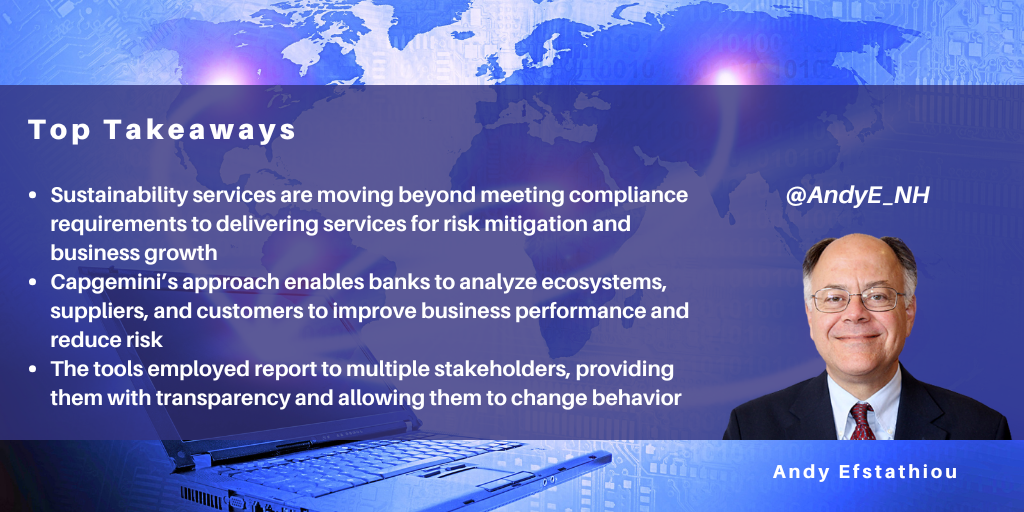
Since my last ESG Market Assessment published in 2024, the public’s perception of ESG has declined due to public revelations that the carbon emission metrics used by many certifying firms are inconsistent, incomplete, and sometimes misleading. During the past year, ESG practitioners have shifted their emphasis from covering all three pillars of ESG to focusing efforts on sustainability. Correcting environmental data sourcing, analysis, and reporting will consume significant resources and provide a set of best practices for acting, tracking, and reporting once completed.
I recently spoke with Capgemini’s Sustainability practice for financial services to find out how their services have evolved and what their clients are doing to meet their sustainability objectives.
Sustainability Initiatives
Recent conversations I have had with financial institutions show they are continuing to pursue sustainability initiatives by working on:
- Data sourcing, remediation, and reporting. While the banks are implementing AI to source and analyze unstructured data, they are focusing less on AI initiatives and more on data lifecycle management and developing analytic frameworks to apply to the data
- Compliance reporting, which varies by region and requires constant change to keep up with compliance requirements
- Understanding and implementing supply chain tracking and monitoring of carbon footprints to manage overall institutional risk and understand the global impact of proposed remediation activities.
This has led institutions to adopt a more focused approach to their sustainability initiatives, emphasizing improved data management and prioritizing projects that address regulatory priorities. Currently, those priorities are:
- Extending sustainability tracking beyond the institutional borders to suppliers, buyers, and investments
- Reducing risk with improved tracking and reporting.
The application of these priorities varies by market, with the highest levels of activity in rank order coming from: Europe (the largest market for ESG services by far), Singapore, Australia, and the U.S. Because local market regulations and business conditions drive investment projects in sustainability, institutions have changed their strategy development and execution from a centrally-planned, enterprise-wide framework to a locally-planned and executed strategy with the flexibility to adopt best practices across the enterprise.
Capgemini’s Financial Services Sustainability Practice
Capgemini has found that institutions with mature sustainability programs are no longer focusing solely on compliance. They want to achieve additional objectives: mitigating climate-related financial risks and creating new sources of business value. To achieve these goals, they need to build a strong data foundation that will enable better risk modeling and product innovation. The goal of Capgemini’s sustainability offerings is to help banks move beyond a regulatory response to embed sustainability into operations, governance, and customer offerings. This enables the banks to turn environmental challenges into opportunities for growth and differentiation.
To meet this demand, Capgemini has developed a sustainability framework that helps clients embed sustainability across strategy, execution, and reporting. It employs a four-pillar approach, with offerings under each pillar:
Sustainable Enterprise, transforming operating models to reduce carbon footprint and costs. Key offerings include:
- Energy Command Center: an IoT- and AI-enabled solution that enables real-time monitoring, predictive maintenance, and optimization of energy and asset performance to reduce costs, carbon footprint, and operational risks
- Carbon Management as a Service: which delivers auditable, and near real-time carbon data across Scope 1, 2, and 3, enabling compliance, reporting, and abatement to accelerate net-zero timelines.
Reporting & Compliance. Key offerings include:
- ESG Lens: an AI-enabled platform that detects ESG data anomalies, benchmarks performance, and provides regulatory insights and scalable ESG compliance
- ESG Reporting: a lifecycle approach to sustainability reporting from roadmap design and data integration to processing and visualization.
Climate Risk & Transition, integrating climate in LOB’s growth and risk strategy. The key offering is business for planet modeling, simulating and computing climate scenarios, stress testing portfolios, and informing transition strategies to reduce financial risk and realize financial opportunity.
Growth & Customer Experience, increasing sustainability revenue and value delivered to end clients. Key offerings include:
- Business and financial impact of sustainability: advanced modeling and advisory services that link sustainability initiatives to EBITDA through integrated financial projections and scenario analysis
- Sustainable finance: a framework and services for deal-level integration, client and relationship manager support, ESG data insights, and tracking mechanisms.
Below are two client case studies showing how Capgemini is working with banks to achieve their sustainability goals.
Leading International Bank
The bank was an early provider of sustainable finance and has a large green bonds business. However, its retail bank provides limited sustainability offerings to customers. Further, due to a lack of active promotion by the bank to the retail customer base, only proactive customers buy those offerings. The bank wanted to proactively establish a brand presence for sustainable finance in the retail market and distribute its sustainable products from its retail branch network.
Using a mobile app with a gameboard of sustainable offerings, Capgemini positioned the bank as a Sustainable Trusted Companion. This proprietary app proposes sustainable choices and offerings with delivery partners at each stage of the consumer/enterprise journey. The bank can meet its sustainability goals with its retail customers relying on the app’s open banking network of delivery partners.
Global Banking Institution
The client wanted an automated platform for mapping EU sustainability reporting (CSRD) requirements across its supply chain. The goal was to simplify and consolidate reporting by evaluating multiple requirements and optimizing the final output.
Capgemini employed GenAI tools to create a map connecting 1.2k CSRD attributes and the bank’s sourcing partners. It then provided a remediation log to resolve unmatched attributes and an audit trail for all actions taken. Finally, it built and deployed a KPI scenario modeler to generate insights to optimize regulatory data.
The use of GenAI tools enabled highly accurate regulatory attribute mapping, provided a scalable solution across multiple sourcing providers and regulatory frameworks, and created a single source of reference.
Summary
Capgemini’s sustainability services help banks to move beyond compliance to use sustainability as a lever for risk mitigation and business growth. Employing its four-pillar framework of Sustainable Enterprise, Reporting & Compliance, Climate Risk & Transition, and Growth & Customer Experience, Capgemini combines technology and domain knowledge to deliver measurable improvements in sustainability. This approach builds the data foundation necessary for sustainability, regulatory alignment, climate risk mitigation, and business revenue growth; and it enables sustainability to increase enterprise resilience and competitive advantage.
By employing GenAI and relevant frameworks, Capgemini is enabling banks to analyze ecosystems, suppliers, and customers to improve business performance and reduce business risk. Importantly, the tools report to multiple stakeholders, allowing them to change behavior.
]]>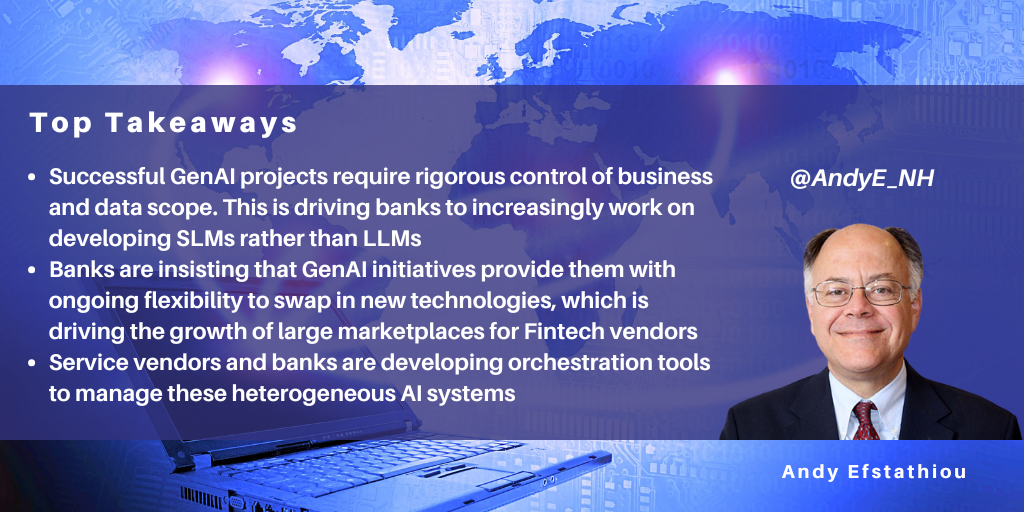
I recently completed a global market assessment of how GenAI and process automation are transforming banking operations. Here are some high-level findings.
GenAI adoption trends in banking
The adoption of GenAI and automation is still very immature, with large institutions being the only adopters of this technology on a large scale. However, the pace of maturation is accelerating, as demonstrated by:
- In 2024, the largest tier one banks worked on ~100 POCs each, and only 5% or fewer POCs moved through to operational deployment. However, in 2025, 25% of POCs are moving forward to operational deployment
- Tier two banks were doing only a handful of GenAI POCs each, with almost none moving forward to operational deployment in 2024. However, in 2025, tier two banks are looking for prepackaged GenAI POCs to deploy to operations. If those are successful, they expect to grow the scale of their GenAI activities in 2026
- Tier three banks are engaging in GenAI activities in two ways: enabling employees to test co-pilot agents to enhance personal productivity, but not interact with customers; and joining consortia that will develop GenAI offerings for their market niche
- Specialty financial institutions are running GenAI POCs to deliver low-volume, high-value processes. Examples include commercial banking, trade finance, investment banking, credit/investment analysis, and employee training.
The use cases being operationalized are software engineering, customer agent support, customer onboarding, credit/investment analysis, and personalized training. The majority of GenAI activity in financial services is in software engineering.
The challenge of becoming an AI-first business
Legacy financial businesses cannot become AI-first businesses without becoming fully digital, accessing relevant data as needed, and transforming legacy platforms. To accomplish those goals, banks are:
- Automating manual processes. For years, banks had automated high-volume, low-value processes to reduce costs. Now they are automating low-volume, high-cost processes, with the aim of automating all processing over the next decade. Generally, low-volume processes are for enterprise and high-net-worth customers. By automating these processes, the banks can generate clean data that can be analyzed by GenAI and agentic AI solutions
- Moving legacy systems to the cloud. Legacy transformation has been an expensive, risky, and long-term project. By moving legacy systems to the cloud, banks can break the process into smaller, less risky steps using microservices, APIs, and app marketplaces
- Adopting SLMs. Clean data is challenging to generate on a large scale. Early GenAI POCs have led banks to pursue SLMs, which are much easier and less costly to scrub and vet for high-quality data, thereby reducing the risk of GenAI hallucination.
Once processes have been digitalized and data scrubbed for a business process, such as credit analysis, the institution needs to develop a plan to change the business model, enabling the business to employ an AI-driven operational environment. As of today, only a few of the most sophisticated large enterprises are integrating business model change into their AI transformation initiatives. To achieve these transformation goals, banks are increasingly demanding change management services from vendors.
Summary
Successful GenAI and automation projects require rigorous control of business and data scope. By limiting the scope of a business process to a well-defined set of operational processes, the bank can source and analyze data effectively. A key example of this is credit analysis, which pulls in large amounts of data but performs analysis that is standardized for an individual institution. Similarly, software development consists of a series of processes that are standardized for an individual institution to create customized functionality. This is driving banks to increasingly work on developing SLMs rather than LLMs for their GenAI engagements.
The use of GenAI is rapidly evolving, and banks are insisting that their GenAI initiatives provide them with the ongoing flexibility to swap in new technologies as new leaders emerge. This creates large ecosystems and marketplaces for Fintech vendors. Service vendors and banks are developing orchestration and management systems, often under the rubric of ethical AI, to manage AI systems and report on their effectiveness.
I will publish a market assessment on GenAI and Process Automation in Banking in December that will delve deeper into this market. It will identify how the market is evolving, what services banks are buying to support their transformation efforts, and the benefits being realized.
]]>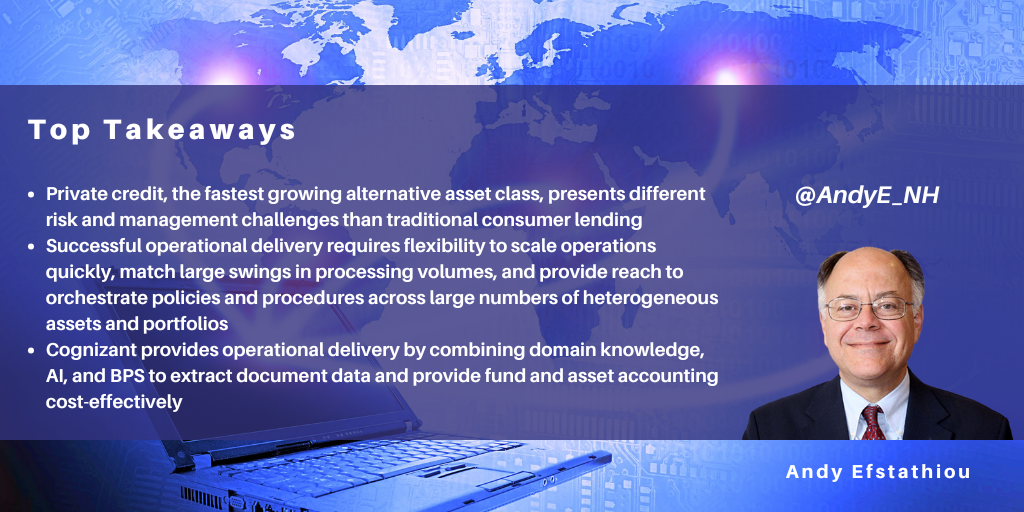
In this blog, I look at the rise of private credit and Cognizant’s operational services that are tailored to meet the needs of the private credit industry.
The Rise of Private Credit
The creation and availability of alternative assets such as crypto, private equity, tokenized assets, and tangible assets, is expanding much faster than the overall investment market. Indeed, changes in regulations are accelerating the adoption of crypto, notably in the U.S. Managing these assets presents different challenges to custodians and asset managers than traditional asset classes.
The largest, fastest-growing alternative asset class is private credit. It has grown in real terms from $49 billion in 2000 to $1 trillion in 2023, according to the Boston Federal Reserve Bank. Market growth has been accelerating since 2019, and Prequin has forecast that the market will reach $2.6 trillion by 2028, with a growth rate of over 20% per year. This level of explosive growth has prompted regulators to take notice and initiate discussions about prudential risk management to ensure market stability.
Private credit presents different risk and management challenges than the traditional consumer credit products provided by conventional lenders. Private credit is provided by non-bank lenders primarily to commercial borrowers. This presents the following operational challenges:
- Borrowers are more complex credit risks requiring rigorous analysis and monitoring
- Lenders have less experience with the borrowers and a smaller operational footprint to deliver all processes
- Private credit often utilizes new deal structures to address borrower operational needs. These deal structures are typically not used by conventional lenders
- The lender (owner of the loan) is often different from the agent (originator and servicer), which necessitates clear and disciplined communication.
The difficulty in addressing these operational challenges is expected to increase when the economy deteriorates, interest rates rise, and individual industries enter cyclical downturns. Hence, private credit lenders are addressing their operational delivery needs by collaborating with technology and BPS providers to enhance the flexibility, scalability, and rigor of their lending activities. Cognizant’s capital markets division offers operational services tailored to meet the needs of the private credit industry.
Cognizant’s Private Credit Operational Services
Cognizant provides three groups of services depending on how the client approaches its operations delivery. They are:
- Operations and research services for clients who externally source BPS services, such as investment operations, credit/investment research, accounting services, and performance management
- Digital and transformation services for clients who externally source project management and point solution implementation, such as change management, project management office, process excellence, and custom solution implementation
- Technology services for clients who internally deploy technology but externally source maintenance services, such as platform upgrades and application/technology infrastructure maintenance.
Processes supported include:
- Data management and pricing (e.g., dealer quotes, asset rating updates, linking/syncing/subscribing)
- Investment operations and treasury (e.g., PIK processing, WSO settlements, sweep commission accruals)
- Accounting (e.g., BDC accounting, accretion income, carried interest, waterfall calculation)
- Reconciliations (e.g., borrower, cash, intercompany)
- Performance (e.g., VAR, scenario and factor analysis, stress testing)
- Reporting (e.g., borrowings/paydowns/rate fixing/rollovers, tax reporting)
- Investor services (e.g., review investor documentation and compliance checks).
Services typically start with fund accounting, cash/trade management, and/or reconciliation. The client will eventually expand its engagement to include investment operations and treasury management. Lenders have been slow to adopt credit research services; however, advances in GenAI are increasing the demand for these services.
Third-party provisioning of operational services for private credit works because the industry's volumes are rapidly growing at over 20% per year, while individual lenders have much larger fluctuations in processing volume due to the buying or selling of portfolios. At the individual loan level, executing these processes is very complex due to the idiosyncratic nature of commercial lending. Calculating cash waterfalls, extracting data from custom documents, attributing performance, reconciling, capital calls, and conducting daily settlements require a combination of domain knowledge and AI to deliver cost-effective, accurate results within deadlines.
Client Case Study: Credit Investment Group
Cognizant has been able to save clients thousands of man-hours of processing time across hundreds of private credit portfolios, while increasing accuracy and enabling clients to scale up/down operations as portfolios are purchased and sold. One such client is a credit investment group, for whom Cognizant provides governance and oversight of fund administration for 152 portfolios with $56 Bn in AUM. Processes supported by Cognizant include corporate actions reconciliation, daily cash reconciliation, and portfolio performance summary.
Benefits achieved for the client include:
- Automated data extraction from trustee reports: annual savings of 1,000 work hours
- Intelligent automation of daily P&L tracking updates across 52 funds: annual savings of 450 work hours
- Low-code automation of daily cash break analysis: annual savings of 300 work hours
- Automated reconciliation of PCO cash balance preparation using trustee data: annual savings of 250 work hours.
Cognizant uses Fintech tools to deliver faster processing in investment operations, such as:
- Canoe for document management: to automate document collection with APIs and RPA. It employs AI/ML to analyze data and generate valuations
- Vidrio for managed data services: to track risk exposure across asset allocations
- Chronograph and I-level for portfolio management: to create a unified view of cash flows
- Alleryx for automations: to automate cash reconciliation and prepare capital calls
- Workflows for control and audit: to implement fund administration processing on the Pega platform.
These tools enable better orchestration and analysis across complex alternative asset portfolios and processes.
Summary
Cognizant’s operational solutions for the private credit industry enable lenders and asset managers to address their two most significant challenges: providing flexibility to scale operations quickly, matching large swings in processing volumes and providing reach to orchestrate policies and procedures across large numbers of heterogeneous assets and portfolios. Cognizant employs advanced technology to pull, analyze, and report on relevant data from custom documents. This is ahead of the market, which is mostly experimenting with the best way to address these challenges. Cognizant will be able to apply best practices and use cases from private credit to other alternative asset classes to accelerate intelligent automation of the industry’s operations.
]]>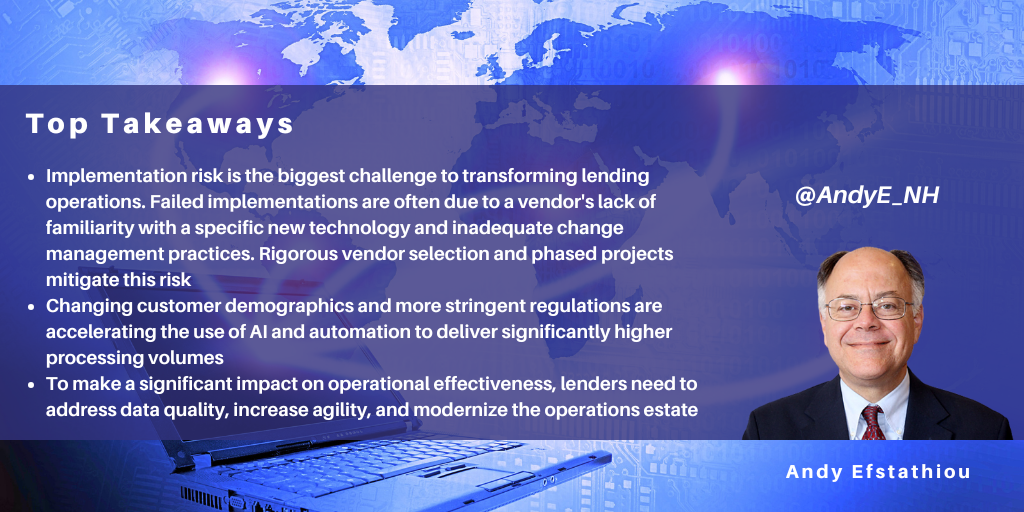
I recently completed a global market assessment of mortgage and loan operations services. I found that the mortgage and loan industry is restructuring at a faster pace than at any time since the Savings and Loan Crisis of the early 1990s, as mergers and divestitures have increased in size and frequency.
For example, over the past twelve months in the U.S., Rocket Mortgage has acquired Mr. Cooper for $9.4 Bn. This merger combines the largest mortgage servicer with the largest originator in the U.S. The combined company will service 10m mortgages, 17% of all U.S. mortgages, and Rocket Mortgage forecasts it can save $500m in operating costs post-merger. Elsewhere, other medium-sized market participants have divested their mortgage operations to focus on their core businesses.
The challenge of operational transformation
The lending industry remains a highly manual operational environment. The high cost of loan origination, increasing competition, and evolving technology is driving industry participants to automate processes and embed AI into their operations. The changing market environment, including shifting customer demographics (such as younger and unbanked individuals) and increasingly stringent enforcement of regulations (especially KYC/AML), is driving the acceleration of automation to accommodate significantly higher processing volumes.
Successful operations transformation requires change on a large scale. To make a big impact on operational effectiveness, lenders need to address three issues:
- Data: None of the emerging AI technology works without clean data from multiple sources. Data sourcing, extraction, scrubbing, and indexing from new channels and new ecosystems are required to enable an intelligent organization
- Agility: Lending is a cyclical business. Delivering cost-effective operations requires operations with a non-linear cost structure. Lenders need to move to hybrid multi-cloud delivery with high levels of process automation to increase operational flexibility
- Modernization of the operations estate: Lenders cannot simply rip and replace systems without undue risk and cost. Lenders need to develop a structured replacement strategy utilizing microservices, APIs, and app marketplaces to employ best-of-breed solutions for each sub-process.
Lenders have been applying these strategies to modernize origination and default management services, while loan servicing has seen less transformation activity. Where lenders have modernized their servicing activities, their efforts have focused on process automation and the modernization of collateral management.
Across all processes, the shift from manual to digital processing has delivered the highest ROI. GenAI promises to deliver additional cost and time savings on judgment-based processes, such as credit assessment, product offers presented to borrowers, and risk/security management.
Regional and local lenders are using managed services and BPS to mitigate their staffing disadvantage. Their focus is on buying standardized offerings to enable them to compete with tier-one and digital lenders.
Summary
The biggest challenge to transforming lending operations is the risk of implementation. Many of the most successful implementations have been done after an initial failed attempt with a previous vendor. Failed implementations often occur due to a vendor's lack of familiarity with a specific new technology and inadequate change management practices. Lenders generally avoid full platform replacement strategies in favor of phased modernization or decoupling of functionality. These strategies are easier to pursue using cloud delivery, which reduces risks by moving technology change management to the cloud provider, leaving business change management as an internal task.
Third-party vendors can provide valuable insights, best practices, and product selection services for emerging technologies, leveraging their experience with AI, automation, and cloud technologies, which is especially helpful to regional and local banks. These best practices are developing rapidly as FinTech and cloud technology continue to evolve.
I will publish a market assessment on transforming mortgage and loan services in July to delve deeper into this market. It will identify how the market is evolving, what services banks are buying to support their transformation efforts, and the benefits being realized.
]]>
In this blog, I look at the growing requirement for operational flexibility in banking, and at a specific KYC initiative from Capgemini aimed at addressing this.
Industry trends
Financial institutions and regulators are increasing their financial crime and compliance (FCC) activities for three reasons:
- The failure of Silicon Valley Bank (SVB), which highlighted the risk of balance sheets with asset/liability mismatches and liquidity risk
- The growing industry-wide expectation of a recession and/or market decline
- An ongoing increase in cyberattacks and fraud perpetrated by increasingly sophisticated actors
- A growing body of compliance regulations from many governmental entities across the world.
Industry trends toward cloud delivery, open banking, and financial product innovation (e.g., crypto) are driving the industry toward greater exposure to financial crime risks. Regulators in each country take a custom view on regulations. Collectively, regulators are raising the bar to demand a proactive response to real-time changes in customer risk assessment. Crypto enforcement in the U.S. is becoming more business-friendly, while the European Union has moved forward with comprehensive regulations aiming for tighter oversight.
As a result of these industry trends, financial institutions will need to transition from the current, heavily manual processes conducted primarily during customer onboarding to highly automated processing conducted continuously and based on a much broader range of data inputs.
Capgemini launches pKYC Sandbox
Capgemini acquired Exiger in October 2023, which accelerated the development of Capgemini’s Financial Crime Compliance offerings. Exiger was founded to oversee the monitoring of HSBC’s AML regulatory action. Capgemini has been appointed on the FCA skilled person panel as a result of the novation of a slot previously held by Exiger FCC to Capgemini. Its capabilities and direct regulatory participation led Capgemini to develop an offering that enhances Know Your Customer (KYC) automation, supporting clients with additional managed services. This enables them to customize their KYC activities while increasing operational flexibility.
Capgemini has developed an offering to address these challenges. Launched in April, pKYC Sandbox enables financial institutions to improve their KYC operations in four areas:
- Data sourcing and management: expanding the range of data sources, both public and private; applying the client’s taxonomy to the data; tracking and analyzing the data over time
- Event and materiality detection: identifying data changes at frequent intervals; applying a KYC/AML risk management policy to data changes; creating and using materiality triggers to the data
- AI and GenAI capabilities: employing AI, ML, and GenAI to create automated alerts, build KYC profiles, and validate documentation
- Enhanced workforce management: scaling KYC/AML alert generation and profile creation using AI and GenAI rather than labor; providing right-shoring services to scale manual labor cost-effectively.
The pKYC Sandbox enables each financial institution to transition from static KYC to trigger-based KYC in a manner tailored to meet its specific business requirements. The sandbox enables the bank to evaluate new technologies and procedures in a standalone environment, mitigating the risk of compliance failures or customer data breaches.
Capgemini has partnered with RegTechs and hyperscalers, including Encompass, Quantexa, WokFusion, Pega, and Google, to develop this offering. Capgemini has partnered with Microsoft to create the industry's first use case for AI-led Know Your Customer (KYC) transformation. Microsoft technology provides:
- Ability to efficiently source data from internal and external providers
- Multi-agent workflows with Azure AI Foundry to digitalize worker tasks
- Structured and unstructured document analysis and data capture using models from Azure AI Model Catalog and Power Platform AI Builder
- Copilot agents integrated into the processing stream
- Data-based risk assessment and reviews, eliminating multi-level QC processes.
Capgemini says the benefits of this offering include:
- First-year cost savings of 10-15%, increasing to 50% per year by year three
- Ability to customize by geography and LOB
- Ability to scale operations non-linearly due to increased process automation
- Creation of a golden source of KYC records
- Consistent execution with transparency to regulators
- Flexibility to adapt to new regulatory requirements.
Summary
Over the past five years, there has been a rapid increase in KYC/AML regulatory requirements worldwide. Financial institutions are struggling to keep pace with the rising costs of compliance. Capgemini has developed a customizable offering that leverages Microsoft AI and GenAI to deliver automated KYC assessments while maintaining visibility into the procedures used to create those assessments. As part of the service, BPS services are provided from right shore centers to deliver the retained manual processes cost-effectively. This enables banks to adapt their KYC operations to meet new regulations and changing business volumes.
]]>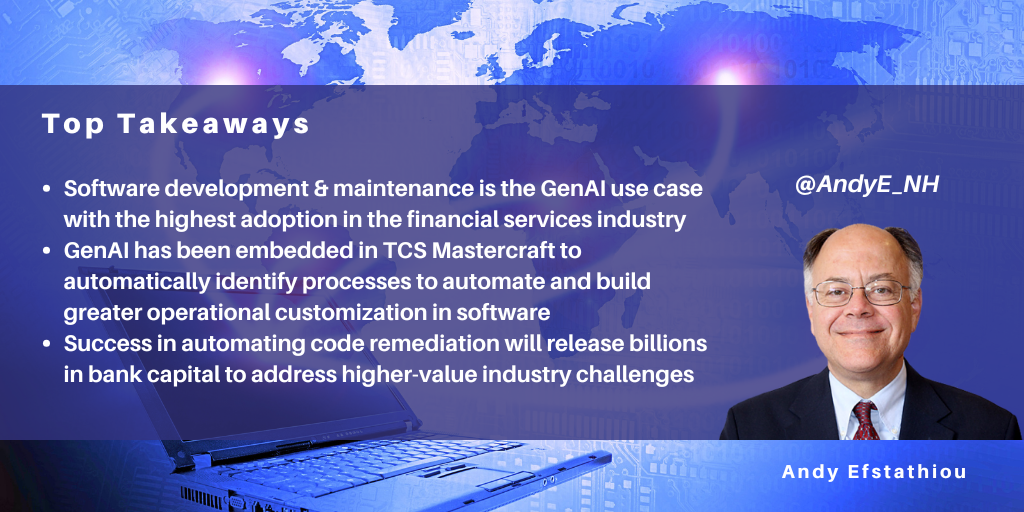
GenAI is being tested by enterprises to identify the value it can bring to their operations. In 2024, the BFSI industry undertook more GenAI testing and POCs than any other industry. However, many POCs were unsuccessful because of limitations in data sets, processing power, and digital processes.
In 2025, large banks are narrowing the range of their GenAI use cases and launching full-scale operational deployment for them. The use cases banks are operationalizing are:
- Software development and modernization
- Agent support
- Process automation
- Document data extraction and categorization
- Employee training.
Software development, modernization, and maintenance are GenAI's highest adoption use case in the financial services industry, with GenAI reducing the delivery cost by 30% to 70%. The financial services industry is in cyclical high demand for software development and modernization as it adopts new technology architectures, responds to rapidly evolving regulatory requirements, and automates previously manual processes (a “digital first” strategy). So, what are vendors doing to help institutions operationalize GenAI software development to speed business transformation at scale?
TCS is helping institutions accelerate software development and modernization by embedding GenAI in its TCS MasterCraft offering, one of the software brands it offers to the market. TCS MasterCraft is a 2012-launched software and data modernization platform that delivers multi-modal software development and ongoing modernization of legacy applications. TCS MasterCraft uses AI to analyze data records and legacy code. In May 2025, it launched a GenAI-enhanced version to enable software engineers to:
- Interview software users more effectively identify processes with high automation potential by employing agentic GenAI
- Create legacy code summaries
- Extract processing rules and SOPs from code summaries
- Identify dependencies
- Customize new code design by industry and institution
- Write and test new code
- Extract processing rules and SOPs from new code summaries.
GenAI functionality will enable clients to:
- Identify processes to automate. Previously, people identified manual processes suitable for automation. Often, individuals had skills in either technology or business, but not both. By combining GenAI and people to conduct process identification, TCS MasterCraft is now able to improve process selection and enable more efficient resource utilization
- Build greater operational customization by industry, market, process, and institution, facilitating differentiation
- Enable reduced time to market for new products to harvest more of each new product’s lifetime value.
TCS will not standardize on one LLM set. This enables clients to work with the most relevant LLMs and switch between them in the future. Clients will be able to develop higher accuracy from their AI models from data-sourcing flexibility.
The BFSI industry has been the largest adopter and user of GenAI for software development to date, and already, 2025 is showing strong growth in the number of GenAI-enabled software development programs. Principal adopters are global custodians, global universal banks, and commercial lenders.
The hype around GenAI has been around building moonshot projects to deliver novel functionality. TCS MasterCraft's latest version is designed to deliver up to 70% greater efficiency, addressing the vast legacy application infrastructure constraints that banks face. Many of the legacy apps are written in COBOL, which increasingly lacks trained coders able to update and transform them. Success in automating code remediation will release billions in bank capital to address higher-value industry challenges.
]]>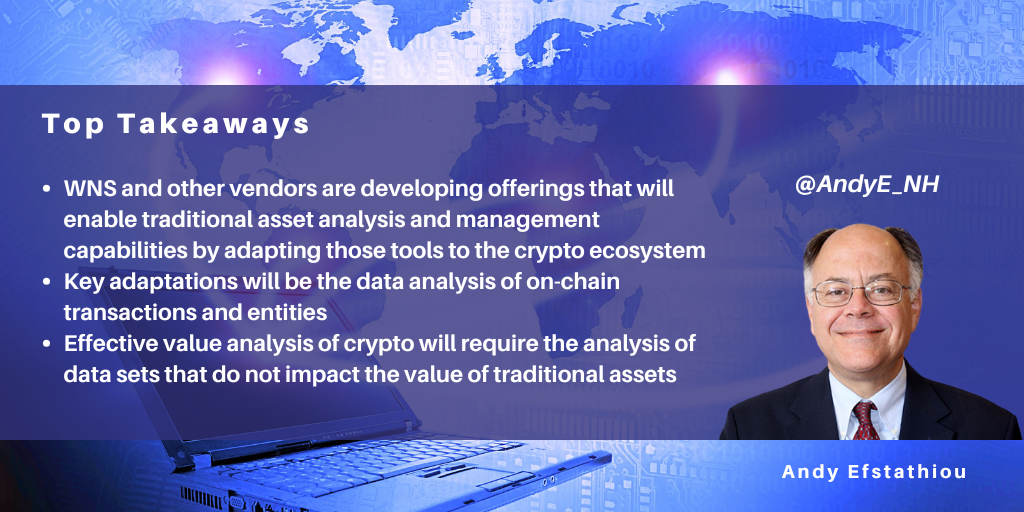
In recent years, cryptocurrency (crypto), a digital currency that relies on a distributed ledger system to maintain ownership and transaction records, has emerged as a new asset class. Crypto has experienced the ups and downs typical of emerging technologies. In 2022, the demand for crypto hit a low, with the value of bitcoin dropping by over 74% from $64.4k on November 13, 2021, to $16.5k on December 31, 2022. Since then, Bitcoin has risen to $87.4k, a 430% increase.
The new Trump administration has accelerated the adoption of crypto, and President Trump has pledged to make the U.S. the crypto capital of the world. This is the first in a series of blogs on crypto that will focus on how financial institutions and technology services vendors are addressing the market opportunity and what best practices look like today. First, I will take a look at WNS’ initiatives.
The crypto challenge
There are four main types of crypto: payment (e.g., Ethereum, Bitcoin), Tokens (e.g., Ethereum), Stablecoins (e.g., Tether), and central bank digital currencies (e.g., digital yuan or e-CNY).
Each type of crypto has a different set of stakeholders, regulations, and technology architecture. Successful operations in each major crypto type require discovery, policy deployment, technology infrastructure, and business model build-out to enable successful, secure operations.
Regulations on crypto are beginning to emerge and vary widely by country. The organization with the most mature regulatory approach to crypto is the Financial Action Task Force (FATF), an intergovernmental organization set up by the G7. The EU has adopted the FATF’s approach to regulation in their MiCA regulation. Adoption of crypto by people and businesses remains low due to a perceived lack of security, which has been amplified by many examples of bad actors stealing or laundering crypto. However, the strength of crypto, which has no centralized manager or single source of failure, is also its primary challenge. The decentralized nature of crypto enables bad actors to game the system and commit various financial crimes.
So, what are the best practices for participating in a crypto environment?
The WNS approach
WNS provides a set of compliance services for financial institutions looking to operate in the crypto world. There are four service offerings:
- KYC: performing new customer onboarding and continuous monitoring (periodic reviews, perpetual KYC) of customers in establishing customer identity, understanding their background and activity, and identifying any potential risks, all to ensure compliance with regulations
- AML: performing AML investigations for crypto transactions by verifying trigger alerts, searching the customer for payments related to crypto, performing a KYC profile, and analyzing the on-chain flow of funds for red flags, if any, to report to regulators
- Fraud investigations: supporting client fraud investigation with triggers to protect customer funds/assets
- Customer query handling: replying to customer inquiries on crypto, verifying onboarding documents, requesting additional documents, and requesting clarification.
To enable the delivery of these services, WNS provides its employees with training specific to crypto-based security issues. Recently, it launched a Compliance-in-a-box service to support KYC, AML, Fraud, and SAR form preparation for suspicious customers. The Compliance-in-a-box solution targets Fintech firms that do not have the resources to deliver these services internally for the foreseeable future.
WNS is also building new services for crypto clients, including:
- Advanced Financial Crime Compliance (FCC) services: currently, all FCC vendors can analyze data from public sources (e.g., internet, media, and data vendors). Few crypto participants can analyze on-chain data for a Financial Crime assessment. The few institutions able to analyze on-chain data are global institutions that use the data for proprietary purposes. WNS will explore developing on-chain analytics solutions and integrate them with public blockchain data to provide FCC services customized for crypto assets
- Intelligent Customer Service driven by GenAI capabilities: providing high customer experience to end customers with faster onboarding and self-service capabilities through AI/ML-driven transformation/analytics solutions.
In summary, WNS and other vendors are developing offerings that will enable traditional asset analysis and management capabilities by adapting those tools to the crypto ecosystem. Key adaptations will be the data analysis of on-chain transactions and entities. Effective value analysis of crypto will require the analysis of data sets that do not impact the value of traditional assets.
]]>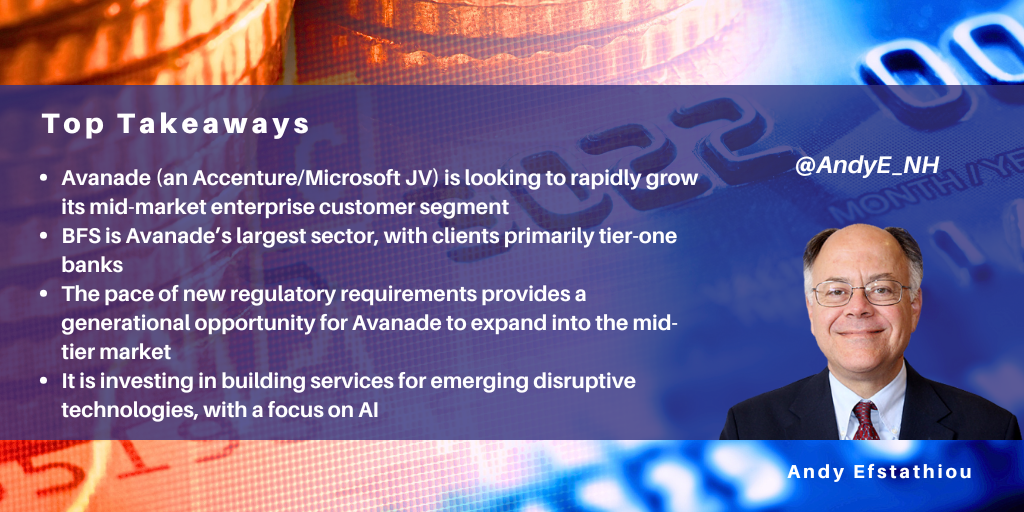
Avanade laid out its strategy and roadmap for growing its business over the next three years at a recent analyst day. Avanade is an Accenture/Microsoft joint venture providing enterprises with IT services. In the 25 years since its founding, Avanade has delivered 37k projects to 5k clients. Its staff holds over 60k Microsoft certifications, including 68 employees with the Microsoft MVP designation. Currently, Avanade sources the majority of its business leads from its owners.
New Horizon targets mid-market
The company is launching a new strategy, New Horizon, to grow its business faster and become operationally more independent of its parents. It plans to focus its direct business development efforts on middle-market enterprises. Currently, Avanade’s client base includes middle-market clients, most of whom are direct-source clients. It defines middle-market enterprises as having revenues between $500m and $5bn. The market of mid-tier firms has thousands of enterprises and should offer Avanade faster growth opportunities than tier-one enterprises outside Microsoft and Accenture’s target markets. If the strategy is successful, it will grow to four times its current size in the next three years.
To accomplish these goals, Avanade is hiring salespeople to identify mid-market prospects and bring on 1k new clients annually. Engagements will start with 4-to-6-week projects, Halo Offers, which will identify Microsoft opportunities within an enterprise. These engagements will be expanded into Solution Plays, implementing templated solutions, or as-a-service engagements. By employing standardized delivery and rapidly scaling best practices across markets, Avanade will be able to deliver quality engagements while growing its sales faster than it scales its workforce. It will also need to shift its mix of full-time/contractor employees towards more contractors to be able to scale delivery to clients with higher sensitivity to seasonal and cyclical economic conditions.
Scaling sales and delivery will only be possible if Avanade’s offerings meet client requirements. Avanade’s mid-market clients prioritize:
- Onshore/nearshore delivery to enable mid-level managers to communicate requirements that enable their differentiated value proposition to the market and maximize client/vendor trust
- Defined solution frameworks to enable rapid deployment and scalability
- SaaS, cloud, and managed service delivery to allow them to reduce their commitment to internal resources.
Avanade is investing in building services for emerging technologies, with a focus on AI, including:
- Engineering services across emerging Microsoft technologies:
- Co-pilots and agents
- AI design and engineering
- Innovating customer experiences:
- Hybrid experiences
- Search (collective intelligence)
- Emerging disruptive technologies:
- Data fabric and core
- AI infrastructure and Edge
- Security and identity.
At this stage, Avanade’s offerings for the Biz Apps suite are its most industrialized offerings.
Financial services clients
The financial services industry is Avanade’s largest industry today, its client base consisting primarily of tier-one banks. The New Horizon strategy will look to grow in BFS in the U.S., Europe (UK, France, Iberia, ASG), APAC (Australia, Singapore), and Brazil marketplaces. Avanade can provide industry domain knowledge, which Microsoft does not offer. It can access Accenture’s industry capabilities and has a cost structure that allows it to deliver cost-effectively to mid-tier banks. To date, Avanade’s engagements with mid-tier banks have primarily been AI-based, cloud migration work, and application development modernization.
Key examples provided were AI-assisted customer contact use cases. For example, responses to customer inquiries must be highly accurate according to regulations. The AI contact agent can deliver high accuracy with ChatGPT 4.0-based technology or somewhat lower accuracy with ChatGPT 3.5-based technology. However, the license costs make 4.0 uneconomic for the client's use case. Avanade was able to engineer improved accuracy into the 3.5 technology to meet the high accuracy requirement. The client was able to save on licensing costs and make its use case highly cost-effective.
Conclusion
In summary, Avanade is looking to grow into the mid-market enterprise at a breathtaking pace. For perspective, the New Horizon initiative will grow its direct business revenues faster than Avanade grew its direct business in the first 25 years. Its best opportunities for success will be in regulated industries where competitors do not have the luxury of putting off decisions until it is economically convenient to implement disruptive technologies. Regulations in BFS are tightening with new regulations that shorten settlement times, increase risk management requirements, and require greater customer data protection. The pace of new compliance adoption provides a generational opportunity for a large services vendor like Avanade to enter the mid-tier market and gain market share with a strong value proposition. To succeed, Avanade will need to consistently deliver successful engagements while innovating new offerings and best practices across geographic and sub-industry markets.
]]>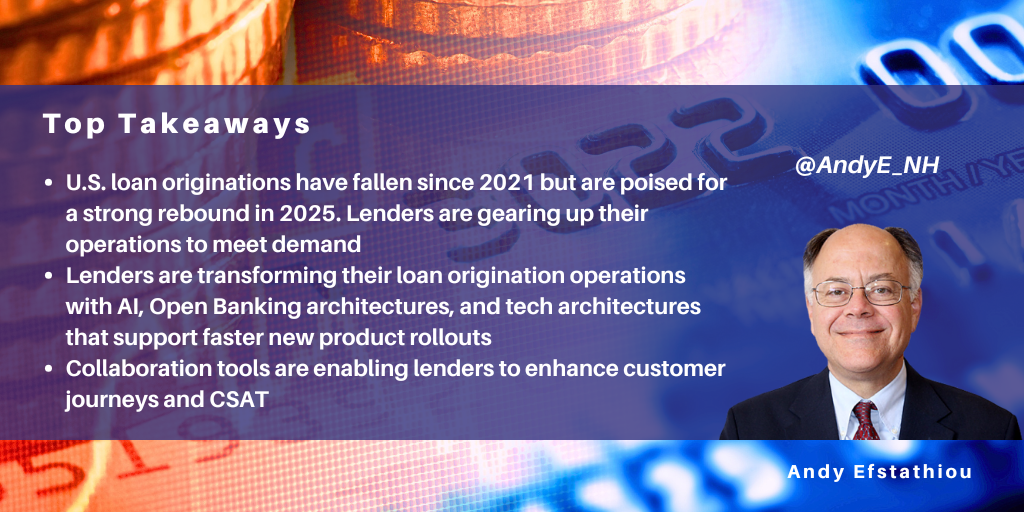
Global loan originations have declined since COVID and the trough of interest rates in April 2020. For example, in the U.S., loan originations fell from $4.51 trillion in 2021 to $1.50 trillion in 2023. Currently, interest rates in the U.S. are declining, and mortgage originations in the first three quarters of 2024 have increased by 9% over the prior year. The U.S. lending industry group, the Mortgage Bankers Association, forecasts a 28% increase in mortgage originations in 2025 to $2.3 trillion due to lower interest rates and increased home building providing consumers with a larger inventory at a lower net cost. Lenders are preparing their operations for a strong rebound in lending. This blog looks at some of the initiatives in play.
NelsonHall completed a survey of 60 financial industry executives in August 2024 about their intentions for operational transformation. Mortgage and core banking operations are the areas with the highest need for fundamental change (55% of respondents indicated extensive change is needed). Mortgage operations had the highest level of respondents (60%) saying they would increase their use of standalone operations transformation.
Lenders are looking to transform operations to drive revenue growth and capture the anticipated surge in origination volumes by:
- Using AI to enable hyper-personalization
- Using intelligent agents to enable customers and originators to shop a broader range of offerings and options efficiently
- Adopting flexible tech infrastructure to enable faster loan product introductions
- Implementing open banking architecture to enable partners to offer customers a broader range of financial products and services.
A recent example of the type of operational changes origination lenders are making is Florius, the largest mortgage specialist in the Netherlands, which wanted to simplify the application process for its customers. To meet this goal, it upgraded its systems to:
- Analyze incoming calls and route them to agents with customer-specific knowledge (typically an agent the customer has worked with previously)
- Integrate systems for customer contact, CRM, databases, and fulfillment
- Retain flexibility for future upgrades with APIs and open architecture.
The company did this by upgrading its Avaya Aura solutions for contact center, workforce automation, and collaboration platform (Breeze), which it integrated with its Microsoft Dynamics CRM system. It worked with NTT DATA in consulting, integration, and ongoing managed services to access expertise and upgrades.
Another example is when the largest mortgage lender in the U.S. wanted to redesign its customized, manual mortgage origination systems into a highly automated system that would deliver faster processing, lower error rates (significantly lower rejection rates), and greater scalability to address industry cyclicality. Working with WNS, the lender deployed Mozaiq.ai, an intelligent mortgage automation platform, and KnowRa+, an intelligent agent solution, to support the originators. The result was that the lender could reduce time-to-close, reduce costs, and improve CSAT and new business growth.
This is just a sample of what lenders are doing to prepare for the anticipated growth in lending. I am starting a global market assessment of operations and technology services in the mortgage and loan industry this month. The Transforming Mortgage and Loan Services project will delve deeper into how these initiatives develop, how lenders address the challenges, and how technology services vendors support their clients. The transformation promises to change the underlying lending business model across many geographies, making home and asset ownership accessible to new consumer demographics under more favorable terms than before.
Technology vendors with relevant offerings can contact me directly to participate in this study.
]]>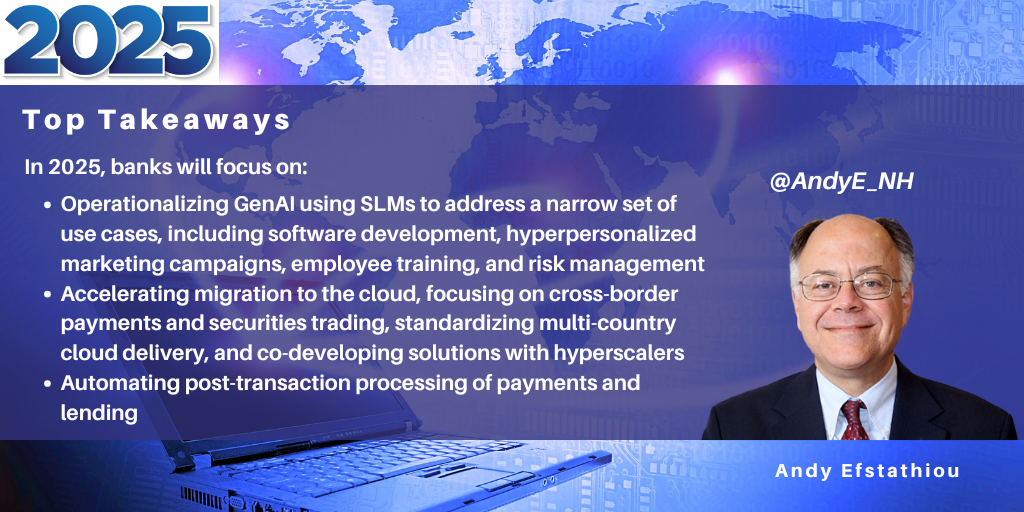
In 2025, the financial services industry will continue to build out its AI, GenAI, cloud delivery, and process automation capabilities. NelsonHall’s recent survey of financial services executives identified that:
- Operational transformation is highly important to 92% of retail banking companies and 93% of commercial banking companies
- Current operating models and processes at over half of institutions are not highly adequate to support key business lines, including payments, lending, and wealth management.
Banks will change how they pursue their business objectives in 2025, including in the areas of AI/GenAI, cloud delivery, and process automation.
AI/GenAI: operationalizing Small Language Model projects
In 2024, every bank wanted to investigate GenAI and appear to have an AI strategy. This resulted in many consulting engagements and POCs. Most POCs do not have a high ROI, and very few banks have operationalized any GenAI POCs. Furthermore, banks have discovered that successfully operationalizing GenAI using LLMs requires vast data, processing power, and energy consumption.
In 2025, most banks will decide that GenAI technology needs greater maturity before they invest heavily in operationalizing the technology internally. However, early adopter banks will move from testing the technology to operationalizing it in a narrowly defined set of use cases. The use cases will use Small Language Models (SLMs) to address internal operations processes such as:
- Software development, including more efficient generation of code documentation
- Hyperpersonalized content for marketing campaigns, such as generating thousands of unique marketing documents and emails personalized to each intended recipient
- Employee online training programs customized to each employee
- Email/document extraction and knowledge summarization
- Risk management, where banks train apps on special-purpose data sets, such as specific loan types used by regional/local customers, to identify risk characteristics and initiate early remediation activities.
While banks will operationalize GenAI use cases, AI efforts in 2025 will primarily focus on modernizing the data architecture. To improve the data architecture, banks will seek to:
- Define a data security architecture that is effective under a rapidly changing technology environment
- Decide what applications can be used in each part of a bank’s tech ecosystem (e.g., proprietary apps in the customer-facing environment and third-party apps in the internal facing environment)
- Decide where the data will be hosted and who has access.
Finally, banks will deploy AI embedded in processes to enhance corporate action resolutions, payment dispute resolutions, and prospect and at-risk client identification and prioritization.
Cloud delivery: standardizing faster delivery & embedding domain IP into hyperscaler solutions
Banks have been accelerating their move to the cloud. Over the past two years, most banks have developed target operating models (TOMs) and have adopted a hybrid, multi-cloud strategy. In 2025, banks will focus their cloud activities on:
- Migrating payments and securities trading to the cloud to improve cross-border transaction processing and declining settlement times (on the path to comprehensive real-time settlement)
- Standardizing and coordinating multi-country cloud delivery to provide a single-brand experience to customers
- Building joint solutions with hyperscalers, including:
- Cybersecurity and fraud solutions with industry customization
- Frameworks and solutions to deliver custom synthetic data sets
- Automation of data migration
- Automation of hollow-the-core processes.
Process automation for payments and lending
The adoption of process automation has been accelerating because:
- Cost pressures have accelerated the automation of manual processes
- The conversion of platforms to microservices has delayed the rewriting of solution modules, which will remain legacy for the time being.
In 2025, the focus on process automation will be on automating processes in lending (primarily origination) and payments (settlement, reconciliation, and reporting). This represents a significant shift from focusing on customer contact to transaction execution. By embedding AI in these automated processes, banks can complete transactions much faster, setting the stage for real-time processing, not just near real-time processing.
Summary
Banks are maturing their approach to using RPA, cloud, and AI in operations. In 2025, they will operationalize these technologies in tightly defined and rigorously controlled domain-specific use cases. GenAI will be deployed to address domain-intense challenges such as hyper-personalized marketing campaigns, employee training, software development, and document summarization. Cloud activities will automate migration, standardize TOMs, and migrate transaction processes. And finally, payments and lending sub-processes will be automated with embedded AI to address domain-specific requirements.
]]>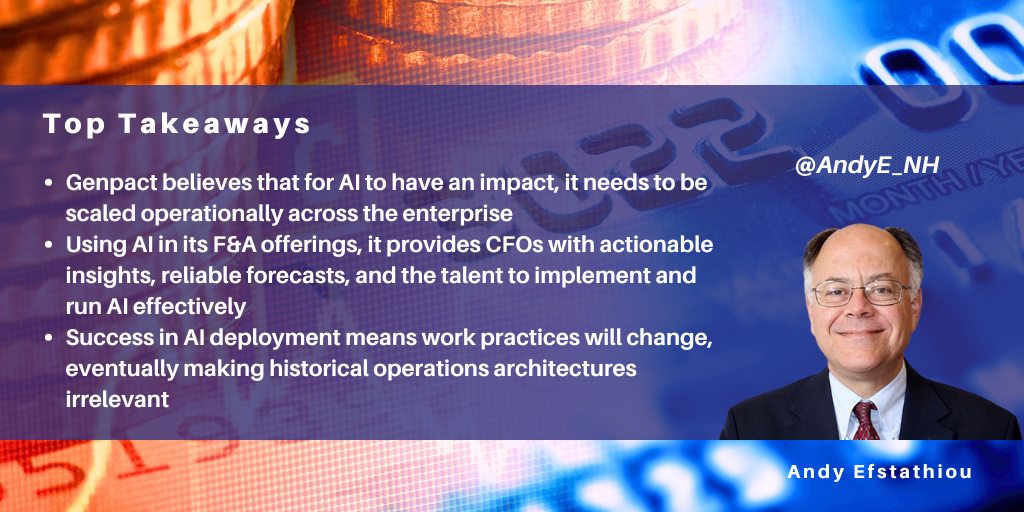
I recently attended the Genpact AI conference, where the Genpact employees I spoke to were energized by the changes AI is bringing and are focused on helping clients operationalize emerging technologies at scale. The company is investing in tools to provide greater ongoing feedback from employees: an HR executive described how they use an employee feedback system combined with a benefit awards system (like an airline's rewards program) to monitor employee satisfaction and identify ways to remedy shortcomings.
In this blog, I look at Genpact’s approach to scaling AI across the enterprise.
Scaling AI across the enterprise
Genpact’s AI focus is on the “AI of Now”. It believes that for AI to have an impact, it needs to be scaled operationally across the enterprise. Unlike many competitors, Genpact did not demonstrate futuristic AI functionality but instead focused on how it helps drive adoption across enterprises, presenting examples of operational deployment of AI to six clients. To grow its client base, Genpact wants to do more work with Tier Two enterprises, which typically have a more significant portion of their operations delivered with legacy platforms and manual processes.
To drive operational adoption of AI across an enterprise, Genpact believes there are three things required:
- Domain expertise: understanding industry-specific processes and data from working with those processes. Genpact has identified which processes and data it will work with for AI projects
- Technology ecosystem and expertise: building an ecosystem of product vendors is necessary to access emerging AI functionality. Executing successful implementations requires the tools, integrators, and technology knowledge that most clients do not have
- Dynamic talent: building an effective workforce to deliver these services requires training and creating cross-functional data, AI, and domain experts’ teams.
Practical AI applications
To build its AI services, Genpact surveyed what CFOs want from their technology investments, and found their top requirements to be:
- Actionable insights
- Reliable forecasts
- Talent that can implement and run AI effectively.
Based on this research, Genpact has embedded AI into its F&A offerings to enable CFOs to improve capital allocation and produce more reliable sales and profit forecasts with on-demand revenue and cost forecasts, fast decision-making with what-if analyses, and the ability to drive change in the trajectory of their business. Using these tools, enterprise clients can:
- Drive growth through AI-driven insights and data-backed decision-making
- Improve revenue forecasting, working capital optimization and planning
- Improve operational efficiency with AI-driven automation.
Genpact can develop better AI-based insights than any single client because it draws on a large pool of data from clients across multiple industries. Genpact’s business supporting F&A draws on its experience doing 500 quarterly book closes for 35k legal entities annually. The data and domain experience from this sizeable annual transaction pool enable robust predictive analysis and the ability to apply AI using keystroke-level process knowledge, thus enabling it to deliver outcomes to its clients. Similarly, Genpact has applied its considerable operational transaction experience to address supply chain and bank fraud challenges for clients.
New AI tools
At the conference, Genpact announced three proprietary tools for its AI ecosystem:
- Genpact CFO Actions Hub: the four key themes the hub will address are responsible AI, fine-tuning LLMs, the agent-computer interface, and how to retrieve & generate data that enables CFOs to transform data into cohesive narratives and enable forward-looking actions like scenario planning and forecasting. It uses LLMs and Genpact’s domain knowledge on a foundation of responsible AI to drive relevance with CFOs
- Genpact Agentic AP Solutions: the launch of four AI-based AP solutions, already live, with four AI-based AR and four AI-based accounts solutions coming soon
- Genpact Finance AI Academy: a set of training courses for employees and clients to improve their domain/technology expertise for the use of AI in finance.
In addition, Genpact’s GenAI solution, Scout, was on the conference app. It summarized each presentation soon after it had been delivered. This was a significant aid to this conference attendee because of the speed at which the summaries were sent out after each session. Presentation slides were also available on the app soon after each session.
Conclusions
Genpact’s AI strategy is to drive operational adoption of AI within enterprises to deliver business value. Operational adoption requires both client and Genpact employees to become familiar with AI technology and how it works in practice. Success in AI deployment means work practices will change, eventually making historical operations architectures irrelevant. Successful change management will need employee buy-in, and Genpact is building continuous feedback mechanisms to keep employees on board.
]]>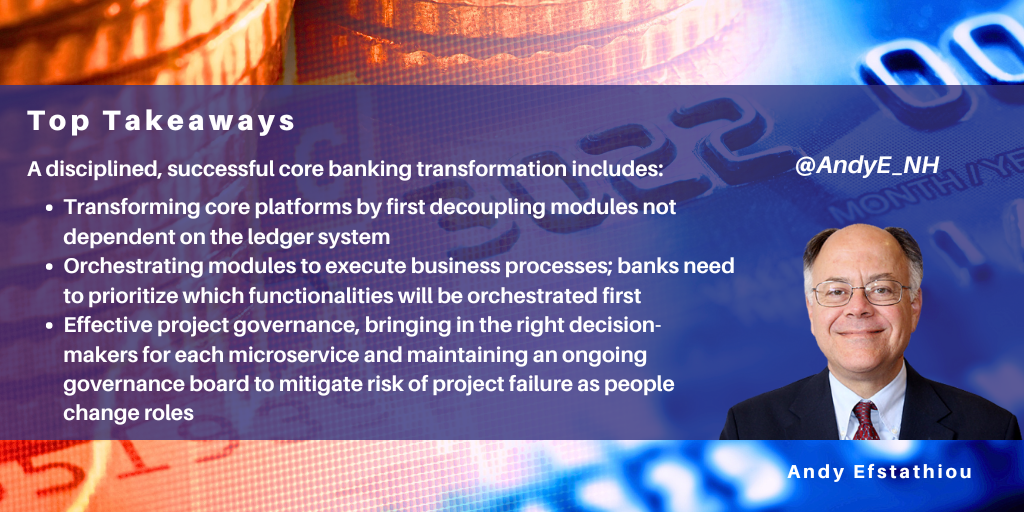
In July, I published a blog outlining the latest evolving practices in core banking platform transformation. In this new blog, I outline Capgemini's approach to addressing core banking transformation challenges with its clients.
The imperative of platform transformation
Demand for core banking platform transformation continues to proliferate to enable banks to:
- Reduce their operational costs
- Meet customer expectations and increase C-SAT
- Migrate operations to the cloud
- Enable FinTech functionality, including AI and GenAI
- Increase operational agility and bring new offerings to market faster
- Integrate operations into the emerging digital ecosystem and comply with open banking requirements
- Achieve faster and more accurate adoption of changing compliance requirements
- Improve risk management capabilities
- Achieve effective international expansion.
However, bankers are reluctant to start transformation projects due to many key challenges, including:
- Difficulty in running an operation environment while undertaking a renovation project
- High risk of project failure leading to career failure
- Complexity, cost, and long timelines to run a project
- Limited access to skilled resources to execute a project.
Capgemini’s approach to core banking transformation
Capgemini has developed a disciplined core banking transformation methodology to address the challenges to achieving a successful transformation based on six critical success factors. It addresses each of these success factors in its engagements as follows:
Effective governance model:
A project governance model must enable project lifecycle continuity. The governance team must include all relevant stakeholders, including the IT group, LOB owners, and third-party service providers. Bringing in the right decision-makers for each microservice is critical to keeping a project on track. Retaining an active governance board will mitigate the risk of project failure over time as people change roles.
Identifying functionalities embedded in the core platform:
Most legacy systems have poor functionality documentation. Banks need to identify functionalities, dependencies, and integrations. BIAN is the standard reference for an industry-standard banking framework. This process needs to be executed with speed and accuracy. Capgemini employs its IPs: CAP360, a legacy code analyzer, and BREAD, a GenAI legacy rules extractor. These tools typically deliver a 40% cost reduction in identifying functionalities versus manual identification.
Sequencing the decomposition of functionalities:
Their dependence on ledger systems must drive the sequencing of pulling out functions into modules. Banks should begin by decoupling systems, such as customer management, where multiple functionalities converge to deliver service. The second set of functions to be decoupled are the ones not dependent on ledger systems (e.g., compliance and payments). Finally, the bank should decouple functions dependent on the ledger systems.
Prioritizing orchestration investments:
A microservices environment needs to be able to link the modules to execute business processes. Rolling out an orchestrator requires prioritizing which functionalities to orchestrate first and what customization to build into the orchestrator.
Reinventing the target operating model:
To reinvent and execute a new operating module, the bank must assign the right team to own and manage individual modules continuously. It needs to coordinate how teams work to enable collaboration across modules and align their development roadmaps.
Linking business value to the transformation journey:
Identifying, implementing, and reporting agreed-upon KPIs and SLAs enables the stakeholders to remain committed to the project and identify remedies if objectives are not met.
Case study
Capgemini recently undertook a core banking transformation project for a tier-one global financial institution offering retail, wealth, corporate, and SME banking services in 50 worldwide markets.
Challenges:
- Long time-to-market for new bank products
- Higher customer servicing costs and inability to meet customer expectations due to a lack of digital banking capabilities
- Increasing inefficiency and high maintenance costs of heterogeneous and end-of-life legacy system operations
- The need to componentize a microservice-based architecture to be able to bring in best-of-breed modules
- Inflexibility of existing system.
Scope of services provided:
To support the bank’s discovery phase and baseline the operations architecture, Capgemini delivered architecture components including:
- Capability model covering all the capabilities aligned to the BIAN model
- Requirements catalog covering 2000 requirements aligned to the capability model
- Baselined scope, defining the markets, products, processes, and integrations to be covered
- Architectural blueprint covering designs for all infrastructure components.
Capgemini set up a Design authority covering:
- Architecture principles, critical design decisions, RAID Log, and non-functional requirements
- Data migration and coexistence strategy, migration options, co-existence scenarios, reconciliation and cut-over approach
- Minimum Viable Product (MVP ) definition approach and sample MVPs
- Roadmap for the next phase of architecture and design
- Functional, nonfunctional, and architectural inputs to the vendor selection RFI for selecting a new core product vendor.
Benefits:
- Defined core and non-core capabilities with ownership agreed with 50 teams across the globe for delivering non-core capabilities
- Employed a BIAN-aligned capability framework and a roadmap to define BIAN-aligned microservices
- Developed a global technology architecture that identified the applications that will deliver non-core functionalities
- Enabled componentized modules, which can be extended to all the bank brands and accommodate local requirements
- Identified existing initiatives the bank will need to change to align with the core banking transformation initiative
- Developed an operational drivers value map to identify the go-to-market proposition for the first MVP
- Identified the core banking product vendors with whom the bank would like to send an RFP
- Delivered a platform and technology perspective for the target state reference architecture
- Delivered a detailed design for the core banking transformation program.
Conclusions
In summary, most banks are pursuing a hollow-the-core strategy for core banking transformation. However, the success of that approach is dependent on bringing all relevant stakeholders to oversee the project and the ongoing evolution of operations. Rigorous prioritization of module sequencing based on business goals and process dependencies will drive value enablement; and orchestrating technology modules and operations units will deliver value to customers.
]]>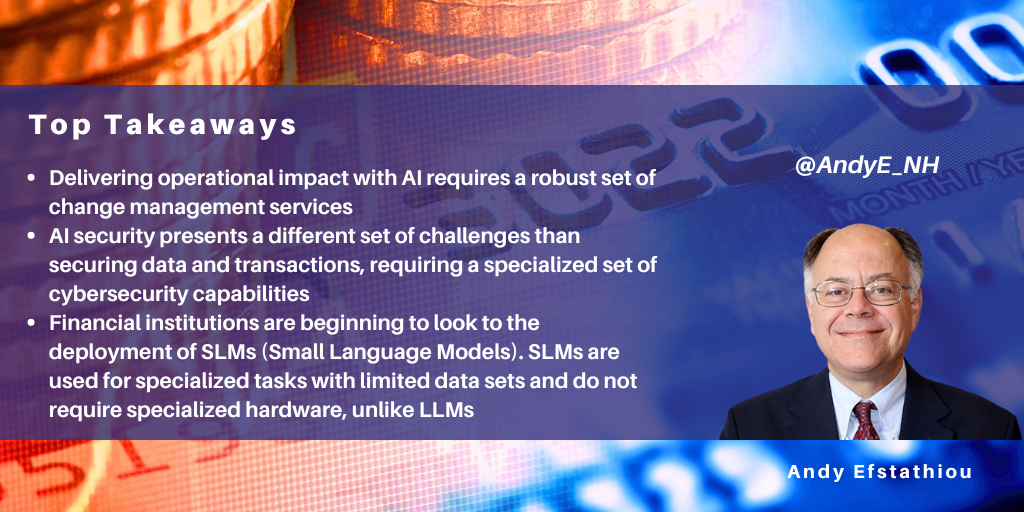
At its recent thought leadership forum, Confluence 2024, Infosys set out its roadmap for achieving a leadership position in AI services.
Despite the hype in the marketplace, Infosys finds its clients are taking a thoughtful approach to implementing AI. Clients want to carefully evaluate the realistically achievable ROI if they bring a project to full operational deployment. Once they identify high ROI opportunities, they fix the data infrastructure for a quality analysis. That requires fixing the sourcing, scrubbing, and distribution of data. Next, operationalizing the data analysis requires modernizing workloads, moving the workloads to the cloud, and experimenting with how AI can be applied to those workloads.
Successful application of AI requires leveraging domain expertise. However, to date, most AI vendors lack the domain expertise to enhance the practical application of AI to business workloads. Infosys is applying its industry experience to develop AI-based offerings for real-time payments, digital wealth management, and commercial banking in financial services. These process areas are characterized by higher levels of manual processing and higher customization across banks.
Infosys’ AI investments
Infosys is investing in six areas to build its AI capabilities:
- Data: tools, techniques, and services for sourcing, scrubbing, and analyzing data. Infosys uses its Master Data Management (MDM) solution for these functions
- AI functionality: enhancing its Topaz platform. Infosys is partnering with more Fintech vendors to develop emerging functionality
- Cloud migration: Infosys is enhancing its Cobalt platform and adapting its architectures and cloud delivery to more markets, including expanding its services for the Nordics, Southeast Asia, and the Middle East
- Engineering software services: Infosys has found GenAI very effective in accelerating its software development. It is taking these learnings and enabling client teams, primarily in large enterprises, to accelerate their internal software development. Shorter development times allow faster time to market for new products and quicker responses to cybersecurity threats
- Marketing: Infosys launched its Aster platform of AI-enabled marketing services, solutions, and platforms in June 2024. Currently, the platform has 400 assets and 50 partners
- ESG: Infosys has found that curating data and feeding the model are as important as building the best ESG model. It has accelerated its investment in these foundational aspects of ESG reporting.
Delivering business impact with AI
Infosys has found that a robust set of change management services is necessary to impact operational outcomes with AI. To increase business impact for clients, it is supporting its AI initiatives by:
- Enabling broad-based adoption by growing its AI and GenAI training offerings for its and client employees. These training programs include the application of domain requirements to AI solutions
- Scaling its Fintech partner ecosystem to provide clients with curated access to mid-tier Fintechs who are likely to succeed but do not currently have the scale for most enterprises to investigate. Banks are particularly interested in the vetting of cybersecurity Fintechs
- Providing clients with ready-to-use offerings by building out use cases that can be operationalized and developing productized offerings for tier two and three enterprises
- Building cybersecurity capabilities to secure AI. AI security presents a different set of challenges than securing data and transactions
- Customizing offerings to the unique characteristics of each market (e.g., Nordics, ANZAK, Middle East).
For the banking industry, Infosys is investing more AI resources in developing open banking offerings. Today, open banking is in high demand from European banks. Initially, Infosys is developing embedded finance and trade finance solutions for its open banking portfolio.
Finally, LLMs are in high demand in the financial services industry. However, institutions that have deployed LLMs are beginning to look to the deployment of SLMs (Small Language Models). SLMs are used for specialized tasks with limited data sets. LLMs require specialized hardware and cloud delivery to run. Typically, SLMs can be run on local hardware, often a cell phone, without cloud access. Specialized industries such as financial services will have many applications for SLMs, and Infosys is developing offerings for this emerging trend.
]]>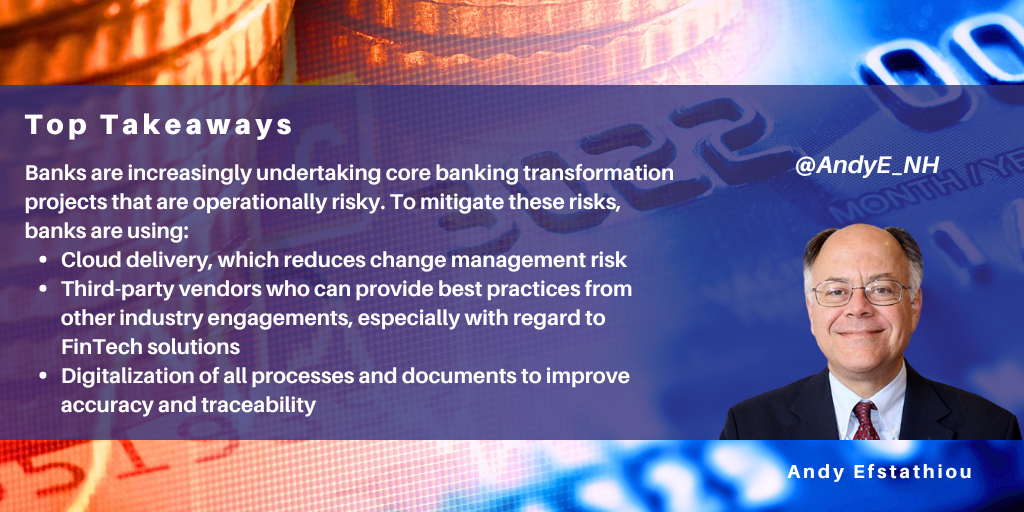
Banks are undertaking core banking transformation projects at an accelerating pace. Typically, two-thirds of these transformation projects will fail. Most either fail to implement a new solution altogether, leaving the bank with the original legacy system, or (in the case of a successful implementation), fail to deliver the anticipated value. Some projects, such as those at TSB Bank and Cooperative Bank, cause permanent impairment to the business and become the stuff of legend.
Since the risk of failure is high, why are almost all banks undertaking core platform transformation projects today? Driving the change is a rapidly evolving industry facing multiple challenges:
- Regulatory changes that require real-time transaction processing, open banking businesses, and expanded reporting, especially for fraud and risk
- Changing customer bases resulting from generational change and the banking of previously unbanked consumers
- New bank entrants, both established banks entering new markets and digital bank startups
- Technological change, including cloud, FinTech, AI, and distributed ledger
- High-cost structures requiring greater efficiency to enable those banks to remain viable.
To address these challenges, banks are pursuing three goals with their transformation efforts: developing low-cost access to quality resources, eliminating internal barriers to all corporate resources, and increasing operational efficiency.
Low-cost access to resources
Banks are pursuing the goal of providing low-cost access to resources by building ecosystems of vendors and partners with the help of technology service providers. To succeed, their platforms need to be able to plug in products and services from the ecosystem partners, so the banks are enabling optimum internal technology deployments by modularizing functionality within their platforms.
To do this, banks need a tech/business talent ecosystem to staff transformation projects. Finally, they need an ecosystem of third-party business partners, such as independent investment advisors, loan originators, and data vendors, to set up new businesses quickly and meet open banking requirements.
Eliminating internal barriers to corporate resources
Eliminating internal barriers to corporate resources is being achieved by rearchitecting core banking platforms into a microservices architecture, which enables the bank to change the operational structure from product silo-based to customer-centric. A customer-centric architecture allows the bank to deliver hyper-personalization of services to each customer. Critical to successfully removing internal barriers is changing how data is managed by improving data sourcing, scrubbing, and efficiency. Finally, embedding AI into a platform that can access all relevant data enables customers to shop complex offering portfolios more easily.
Increasing operational efficiency
The third goal of improving efficiency is being achieved by digitalizing all processes and documents. Banks are outsourcing more processes to convert CapEx to OpEx to align revenues and costs better. Processes are being automated with either digitalization or RPA. Where manual execution is still required, banks are implementing AI to reduce manual error, increase the span of control, and deploy consistent use of best practices.
Summary
The biggest challenge to achieving these goals is implementation risk, and the biggest challenge to successful implementation is change management. Banks mostly avoid full replacement strategies in favor of phased modernization or functionality decoupling. These strategies are easier to pursue using cloud delivery, which reduces change management risks by moving technology change management to the cloud provider, leaving business change management as an internal task.
Third-party vendors can provide best practices from other engagements in the industry, which is especially helpful to regional and local banks. These best practices are evolving rapidly as FinTech and cloud technology continue to evolve.
I will publish a market assessment on transforming core banking services in September to delve deeper into this market. It will identify how the market is evolving, what services banks are buying to support their transformation efforts, and the benefits being realized.
]]>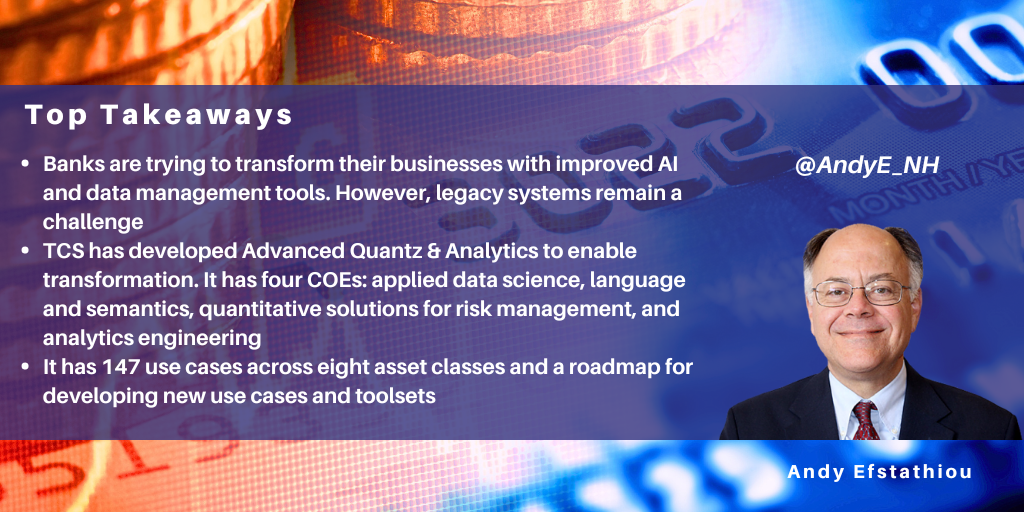
Financial institutions are data-driven businesses, and because of decades of investment in technology, banks process data using heterogeneous legacy environments. Modern AI and GenAI solutions promise to enable banks to manage and analyze data more effectively. However, adopting new AI solutions is lagging far behind the market hype. In this blog, I look at how TCS is helping clients address this challenge.
The Challenge
Banks must modernize their data management practices and technology infrastructure to adapt to fast-changing regulations, business models, stakeholders, and technology offerings. The scale and complexity of bank legacy data environments are a primary inhibitor to data modernization.
Most existing AI and GenAI projects are point solutions that deliver some benefits but cannot deliver business transformation. Further, when an AI solution is implemented, the highly siloed nature of large banks makes data analysis ineffective because modern AI, ML, and GenAI require the analysis of very large data sets.
For banks to adopt AI at the pace and scale needed to drive fundamental business transformation requires support from technology services providers. Essential third-party tools needed include:
- Taxonomies, frameworks, and use cases to identify where and how to implement AI solutions
- Ecosystems of vetted FinTech vendors to draw on for emerging functionalities
- Accelerators to drive effective implementation.
TCS’ Approach to AI Enablement
TCS has multiple offerings specific to BFSI customers and their requirements around AI. For example, it has developed Advanced Quantz & Analytics, an offering to enable clients to accelerate their AI journey, delivering services comprising:
- Technology and analytics engineering
- Business contextualization
- AI strategy consulting
- Design
- Innovation.
These five services are delivered as a package to identify combined business/technology requirements and implement transformative change. However, to reduce complexity and time to operational deployment, TCS is developing use cases and templates for AI deployment.
To support the development of use cases, templates, and offering development, the Advanced Quantz & Analytics team has built four COEs:
- Applied data science: delivers AI/ML solutions at the enterprise level
- Language and semantics: delivers GenAI and Deep Learning knowledge graph applications by partnering with graph producers
- Quantz: delivers quantitative solutions for market and risk use cases
- Analytics engineering: delivers process and ecosystem transparency for ML-based operations and orchestration.
These COEs have developed use cases that are segmented by time to deployment and business value:
- Time to deployment:
- 0 to 6 months: quick implementation to achieve rapid payback
- 6 to 12 months: medium-term implementation, which can be scaled across LOBs, silos, and markets
- Over 12 months: transformational engagements requiring major platform retooling
- Business value:
- ROI
- Customer impact
- User adoption rate.
TCS has developed ten categories of ML/AI models it wants to work with in BFSI, including sales, risk, financial forecast, and language models that are already fully operational, and others that are in development.
Advanced Quantz & Analytics has developed 147 use cases across eight asset classes, with credit and equity having the highest number of use cases developed to date. To operationalize use cases, clients have access to TCS’ ecosystem of 1k technology providers and 500 FinTechs in TCS’ COIN ecosystem.
TCS is working with 80 clients in BFSI to deliver AI services with the Advanced Quantz & Analytics offering. Most clients are large banks able to draw on large data sets, but many engagements require TCS to deploy synthetic data sets to enable effective ML and analysis.
Summary
AI and GenAI offer new power to enhance the value of bank data and transform many financial services business models. Identifying relevant use cases and implementing effective solutions remains challenging for the banking industry. TCS has developed an offering to support banks deploying AI and GenAI effectively and quickly. Its Advanced Quantz & Analytics offering has a roadmap for developing new use cases and toolsets to enable the offering to mature as AI technology continues to develop quickly.
]]>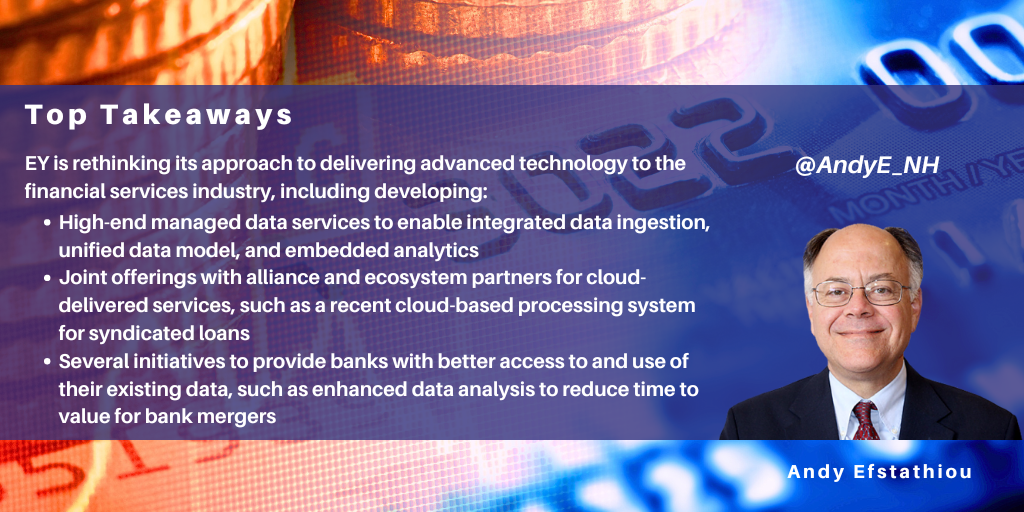
I recently attended the EY Global Analyst Summit 2024, the theme of which was Rethink! The conference sought to answer the question, “How is EY rethinking the value it delivers?” and this blog looks at how EY is rethinking its activities in support of the BFS industry sector.
EY has been growing its business rapidly, with the most recent numbers showing 15% revenue growth for the FY year ending June 31, 2023. EY is rethinking and doubling down on its transformation offerings to grow its business further and is investing in two areas (IP and offerings) to enable differentiated delivery of transformation projects.
Intellectual Property
EY is focusing its IP investments on accelerators, frameworks, and platforms, and is developing business solutions in partnership with ISVs and FinTechs. EY’s key platform offerings are:
- EY Fabric: a global foundational technology platform providing reusable assets, standards, and access to IP for all EY technology projects. 69k EY clients are using Fabric with 2m unique users globally
- EY Nexus: a technology platform that combines EY’s industry knowledge and implementation experience to help their clients push the boundaries of new ideas, accelerate problem solving and simplify business operations
- EY Canvas: a unified audit platform that digitalizes the entire audit process
- EY.ai: a platform supporting enterprises looking to implement AI, providing access to solutions, people, and methodologies. Ey.ai has 100 AI apps deployed, 10k dedicated EY employees, and receives 330k visits per month.
The key benefits banking clients derive from these platforms are the ability to:
- Standardize platform transformation for global enterprises across multiple LOBs and markets. For global banks, this allows units to maintain independence and local market compliance while still enabling centralized risk management and CX to adhere to the bank’s global standards
- Reduce cost and time to market on implementation. One banking case study provided claimed a 70% reduction in implementation effort for a global bank due to the combined use of AI and RPA embedded in the implementation platform.
Offerings
EY has eleven categories of service offerings. The conference highlighted two offerings in the BFS industry: managed services and sustainability.
Managed services are its most recently created offering category (see my blog “EY Managed Services Driving Increased Efficiency for Clients” from June, 2022). Managed services have been growing faster than EY’s expectations and currently over 500 managed services clients are buying four or more managed services solutions from EY. Since June 2022, EY has added three new lines of managed services: customer & growth, supply chain, and technology services.
Managed Services
Managed Services recently acquired a FDL, which provided one of the clients with centralized data management taxonomies, practices, and services across its disparate businesses. EY will build the FDL capability into a high-end managed data services offering for global enterprises, enabling them to:
- Create a unified data model across their businesses
- Build an integrated data-ingestion-to-user experience
- Integrate AI into their data processes
- Build persona-based data products.
Global banks, which have diverse business segments and customer bases with highly diverse businesses, are expected to become a large client base for the managed data service offering.
Sustainability
EY’s sustainability practice has delivered 17k engagements for 11k clients with a dedicated Climate Change and Sustainability Services team of 4K professionals. EY has applied and learned from its internal sustainability activities and reduced the EY carbon emissions by 43% from 2019 to 2023 while growing its headcount by 40%. The practice provides ESG and Sustainability technology services across:
- Reporting and performance management
- Green IT and responsible computing
- Sustainable supply chain and operations
- Decarbonization and net zero transformation.
Sustainability for BFS services focuses on reporting and Green IT, and it will soon add three services to support banks' lending activities and sourcing decisions. Sustainability services for BFS are delivered from the managed services unit. After several years of breakneck growth, BFS represents the largest single industry segment in EY’s sustainable managed services.
BFS Industry Offerings
EY’s BFS industry cloud offering is Nexus, a platform for financial institutions looking to digitalize their operations. Launched in 2020, Nexus runs on clients’ choice of cloud provider infrastructure and comprises industry-focused products packaged to address market and client challenges. One way in which banks are using Nexus is to accelerate their adoption of modern core platforms. To develop emerging functionality for banks, EY is working with alliance and ecosystem partners to develop joint offerings, starting with a lower-cost lead generation solution.
An example of Nexus’ recently delivered large-scale banking cloud migration engagements is where a consortium of four New York-headquartered global banks set up a cloud-based processing system for syndicated loans and now processes 65% of all syndicated loans. Based on Microsoft, the platform uses blockchain technology to enable transparency down to the loan level. The platform has reduced settlement times from weeks to days.
EY has three focus areas for growth in BFS: technology modernization, risk management, and sustainable development; and it has built the tools for rapid delivery to improve processing in these three areas. EY recently acquired a FDL, enabling it to deliver the data management capabilities to populate these three focus areas with better data and analytics. The FDL capability will allow it to accelerate the growth of its current offerings for BFS.
EY is working on several initiatives to provide banks with better access to and use of their existing data:
- Data analysis to reduce time to value for mergers. The banking industry expects to accelerate the pace of mergers over the next few years. To support their clients, EY
developed a comprehensive suite of FinTech solutions to help scale acquisition strategies and service models as well as foster organic growth and engagement within financial institutions’ customer base leveraging the partnership with MoneyLion and its embedded marketplace infrastructure technology, data insights and content solutions
- Enabling wealth advisors to use complex internal data to improve customer offers. In one case, a large wealth manager wants to integrate Open AI into its platforms to provide its advisors with enhanced access to internal data
- FIS, the core banking platform and solutions vendor, wants to migrate its applications to the cloud. Cloud delivery will enable FIS to expand the range of clients and markets it sells to. EY, in partnership with Microsoft, has developed migration accelerators. Six solutions went live on the cloud in December 2023.
Summary
In summary, EY’s banking practice is doubling down on offerings that migrate platforms to the cloud, making more data accessible to a broader range of users and delivering managed services to clients. These new offerings will allow EY to reach out to markets and clients, such as mid-size firms, where it has not been active. Managed services and industry-specific transformations are the fastest-growing segments of its BFS business and promise to be less cyclical than its traditional professional services business.
]]>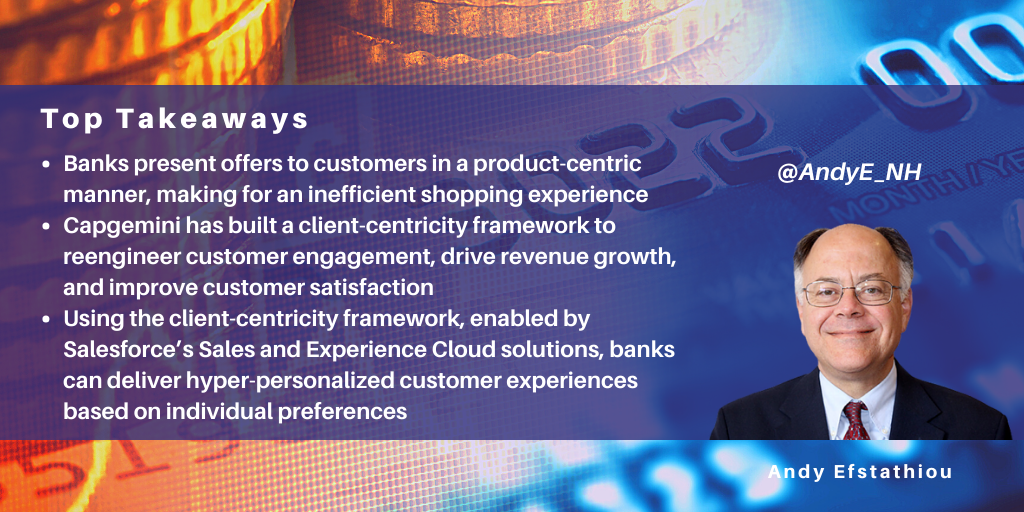
Financial institutions have complex portfolios of products presented to customers in a siloed, product-centric fashion, which makes shopping for financial products inefficient and reduces the overall customer experience. However, digital delivery promises to improve customers' shopping experience, CX, and CSAT.
Some firms in other industries have been doing this successfully, such as Disney for its theme parks. Each theme park has a complex set of offerings to choose from, and Disney uses its MagicBand to connect consumers to all their choices within the park and deliver the final experience. However, developing a customer-centric, unified shopping experience for financial services remains an industry challenge. In the early 2000s, Citibank tried to address these issues with its “Financial Supermarket” concept, But by 2008, the Citibank experiment famously failed.
Capgemini’s client-centricity framework
Capgemini and Salesforce are working together to enable enterprises to deliver customer-centric, unified, and optimized consumer experiences for financial services, similar to the Disney MagicBand concept. Capgemini has built a client-centricity framework to identify customer drivers and enterprise enablers that will support reengineered customer engagement, and in turn, drive revenue growth and improve customer satisfaction. Critical components of Capgemini’s client-centricity framework include:
- Customer drivers:
- Personalization: tailoring the customer’s experience
- Availability: ubiquitous, 24/7 access and responsiveness to customer inquiries/demands
- Trust: built via reputation, ethics, and actions
- Diverse offerings: providing a wide range of financial offerings
- Autonomy: empowering customers to make informed decisions
- Enterprise enablers:
- Strategy Alignment: ensuring corporate strategy aligns with customer needs
- Data capabilities: employing data to customize offerings to individual customers
- AI/technology upgrade: re-engineering the technology platform to a customer-centric approach
- Operating model automation: digitalizing and automating all operations delivery to customers
- Culture: attracting, training, and retaining employees with high domain knowledge and customer interaction skills.
Effective organizations can analyze customer drivers in real-time and prioritize offerings and fulfillment to meet a customer’s needs.
Salesforce technology
Salesforce provides the solutions and platforms to integrate and deliver enablement for clients. Key Salesforce offerings used in the partnership include:
- Data Cloud: the platform integrates sales, service, and marketing data from multiple silos to create a single experience across customer-facing functions
- Sales Cloud: a sales management solution providing lead and pipeline management, forecasting, and AI insights
- Service Cloud: a customer services platform that helps businesses manage and resolve customer inquiries and issues
- Marketing Cloud: the platform integrates data, teams, technology, and AI to enable real-time personalization
- Experience Cloud: enables a business to create branded digital experiences to share information and collaborate
- Financial Services Cloud: a platform built on the SF Sales and Service Cloud platforms but customized for the financial services industry, including industry compliance requirements and data compliance. Initially designed for the wealth management industry, it supports relationship managers managing customer relationships
- Einstein 1 and Co-pilot Studio: AI assistants that respond to natural language inquiries
- Next Gen Tableau: automates data analysis, predicts user requirements, and generates actionable insights.
These solutions provide functionality to enhance data quality and integrity, provide contextual suggestions, and customize AI actions to specific customers.
By combining these two offerings, Capgemini’s client-centricity offer and Salesforce’s Sales and Experience Cloud offerings, financial institutions can deliver hyper-personalized customer experiences based on their individual preferences. The AI embedded in these platforms enables advisors and customers to find available financial products that are relevant. Current engagements are delivering these capabilities to banks. Here is a recent example:
Client example: large U.S. bank
Challenge
A leading retail bank could not deliver the seamless customer experience it wanted. Specific challenges included:
- Fragmented customer experience due to the lack of a unified digital solution. Lack of a 360° customer overview resulting in a poor time-to-market for new product launches
- Fragmented operational silos, which created a disjointed customer journey, the slow release of solution enhancements, and reconfiguration challenges
- Manual interventions to communicate data across silos reduced visibility and increased error rates in market and transaction data.
Scope of Services
- Integrated and deployed an integrated solution of Salesforce, Mulesoft, and Marketing Cloud across all systems
- Solution was delivered across experience strategy, roadmap development, design, implementation, and standup
- Phased deployment strategy to minimize risk
- New activation channels were opened based on predefined segmentation to enhance customer engagement.
Benefits
- Customers experienced an omnichannel experience with priorities based on customer goals, regardless of initial channel entrance
- Improved lead management, resulting in increased conversion ratios
- Minimal impact on legacy systems
- Elimination of manual processes leading to lower error rates, faster throughput, and enhanced CSAT
- Integration benefits included real-time reporting to speed up troubleshooting, provide insights into customer behavior, and assess system performance.
As this case demonstrates, customers no longer have to “stumble upon” products that meet their needs by accessing multiple product silos; the platform can sift through an ocean of data to narrow down offerings and present a few highly relevant suggestions for final consideration. This should make dealing with a bank less stressful and more satisfying.
]]>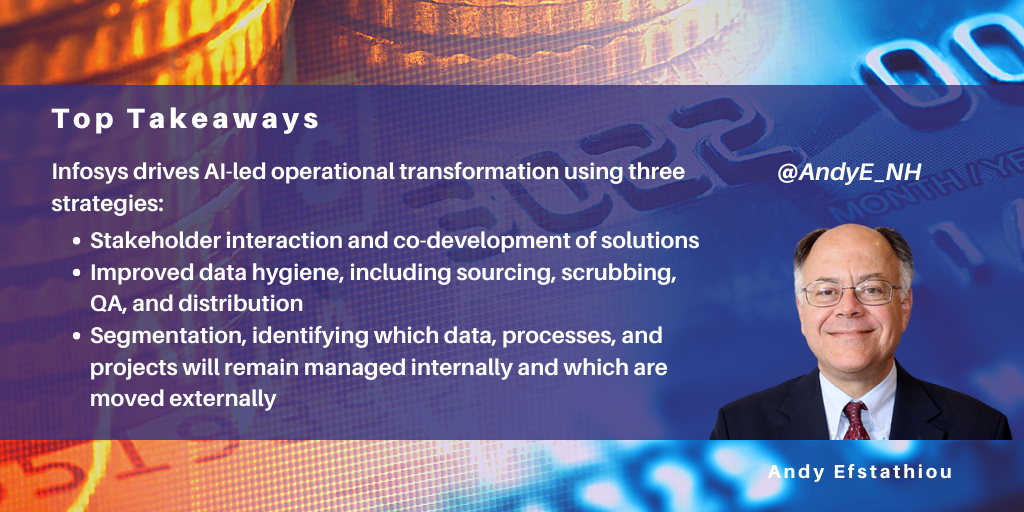
NelsonHall recently attended the Infosys U.S. Analyst Day in Dallas, the theme of which was “Being AI First”. It demonstrated clear progress since last year’s conference in Infosys’ thinking and approach to the critical steps for effective implementation and operational deployment of AI.
Key components of AI-led operational transformation
Infosys and its clients attending the conference identified three essential components to enabling an effective AI-led operations transformation:
- Stakeholder interaction and co-development of problem definition, goals identification, roadmap development, and operations transformation
- Data hygiene, including sourcing, scrubbing, QA, and distribution
- Segmentation, identifying which data, processes, and projects will remain managed internally and which are moved externally.
To drive the first component of stakeholder interaction, Infosys pursues a hub-first strategy for innovation. Hubs are operational centers of expertise where Infosys and its clients work on client projects to develop novel POCs and operational deployments. Clients prefer to be involved in innovating their operations and have relevant input to shape and drive the innovation process. This enables a co-creation process that allows enterprises to focus on innovation at a higher success rate. Infosys values the feedback, domain expertise, and deep knowledge of an institution’s differentiating factors that clients provide in a hub environment.
To drive innovation in a tightly coupled co-creation environment, Infosys has built tech and innovation hubs worldwide. In the U.S., it had committed to building four hubs in 2018, but it has set up six because of client demand. The six hubs are based in Providence, RI; Richardson, TX; Hartford, CT; Raliegh, NC; Indianapolis, IN; and Phoenix, AZ.
The ideation from hubs needs to be realized with AI functionality and delivered with operational flexibility. To enable that synthesis, Infosys has coupled two of its platforms, Topaz (an AI-first offering that helps enterprises create value from generative AI technologies) and Cobalt (a set of services, solutions and platforms for enterprises to accelerate their cloud journey), to speed up ideation and the operationalization of successful POCs. This enables innovation at both speed and scale.
To continue growing its capabilities, Infosys is investing in AI to support operational transformation. Infosys’ significant investments in AI-led transformation are:
- Infrastructure-led transformation to the cloud
- Data and AI transformation leveraging the cloud
- Business transformation led by enterprise apps and SaaS
- Platform engineering
- Non-IT workloads to the cloud.
Infosys’ AI-first strategy for financial services
Infosys has built its most comprehensive domain-specific AI capabilities for the financial services industry. Financial services is the largest industry segment for Infosys (~30% of revenues), and North America is the largest single market (~60% of total revenues).
Infosys’ AI-first strategy for financial services focuses on nine areas it uses to help banks improve their business performance. The focus areas are:
- Personalization at scale for sales and marketing
- Deepening relationships by helping advisors work with customers
- Portfolio management and product design and testing
- Risk scoring for credit, AML, KYC, and onboarding
- Operations improving CX and employee experience
- Modernizing tech and infrastructure with AI
- Talent and change management
- Making the enterprise data ready.
Client use case
Infosys provided a use case of a credit union. The credit union has been committed to giving back to its employees and members, and had to identify how changing technology and member preferences could be fulfilled and achieved with new delivery techniques and offers. Data is the core of the financial services industry, And the credit union segmented its data into three areas:
- Foundational data: this is unchangeable data that should remain on-premises. Examples include identifier data and legally private data
- Core data: this data includes transaction data and transient entity data. Examples include KYC, AML, fraud, and transaction data. This data can be moved to the cloud
- Sales and marketing data: this data changes rapidly in response to changing market conditions and various product campaigns. This data should be kept in the cloud from the start because it has a very short lifespan. However, the research data supporting the campaigns comes from internal and external data and, therefore, should not be kept in the cloud.
Infosys identified 200 use cases to manage the data and drive better customer value. Cases were ideated, POCed, and operationalized in a disciplined waterfall where unpromising use cases were dropped. The primary driver of use cases that make it to full operational deployment is customer data rather than product data. The client started the initiative with employees and leveraged Infosys’ tools and support to enable it to develop offerings and delivery methodologies that appeal to a younger generation with differing priorities and needs than the older generation.
Summary
Intelligent automation and data transformation POCs and projects have gained traction over the past year, propelled by the GenAI opportunity and hype. Only some of the many POCs and MVPs have translated into operational transformation at scale. Infosys’ approach to using AI to drive operational change uses client co-creation to build differentiating operational change, data hygiene techniques to enable effective analysis, and rigorous segmentation of data, projects, and processes to set role-based responsibilities. This approach allows for change to happen quickly and at scale.
Infosys provided examples of how it delivers these services in the financial sector, including regional and local banks. These banks represent a larger addressable market for IT services vendors than tier-one banks because they have older legacy systems and will be less likely to retain as high a level of internal operations as the tier-one banks in the long run.
The challenge for vendors is to identify compelling value propositions for clients. Infosys has addressed this challenge with its localization initiatives that drive the co-creation of differentiated operational offerings at scale. Data drives the financial services industry, and Infosys’ activities with a credit union, described above, outline how a data transformation program can be handled.
]]>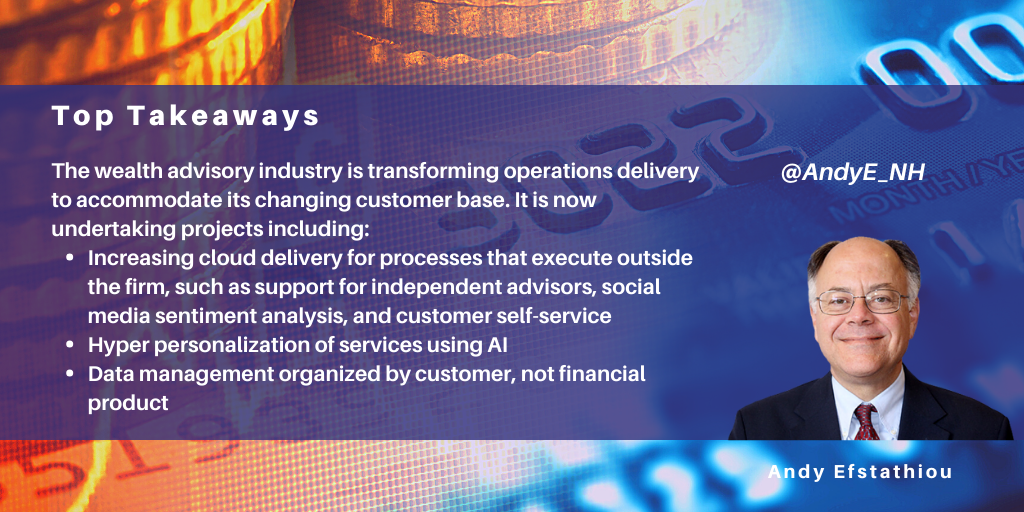
Financial institutions are rapidly starting or growing existing wealth and asset management businesses. In the U.S., wealth assets under third-party management have grown over the last five years by 16.8% CAGR to 2023 (Source: Statista). Wealth advisors are looking to continue to invest in and grow their wealth management businesses because they see continued growth coming from:
- Generational transfer of wealth from baby boomers to younger generations. The estimated transfer of wealth is $84 trillion over the next 20 years (per Cerulli Associates)
- Perceived risk of an economic downturn by the management of financial institutions. This would lead to significant losses in risk portfolios for the banks. However, wealth management is a fee-based business and not subject to capital losses.
NelsonHall’s operations research finds new customer demographics can be profitably served with digitalized service delivery. These customer demographics are the mass affluent and the unbanked. Government initiatives such as India’s program to issue Aadhaar numbers to all citizens enable previously unbanked citizens to access financial services. Governments are moving towards individual retirement funding, necessitating individuals to start saving. Digitalization of service delivery allows profitable service delivery to a much larger mass affluent customer base.
Changing customer base
The growth in the wealth advisory industry is driven by a changing customer base, which has very different priorities and expectations from the traditional wealth client base. Key new customer priorities are:
- Investments that reflect the client’s values. Examples include investments that score well on ESG and transparency. Weaknesses in effective scoring and benchmarking these attributes remain a challenge
- Digital engagement with advisors. Today’s customers are familiar with digital engagement and expect to have it across their entire environment. Currently, most younger wealth management customers are unhappy with the quality and functionality of their wealth managers’ digital interaction offerings
- Digital tools to educate themselves and provide portfolio and return attribution analyses. The quality of these tools varies widely across wealth managers. Current tools are perceived as inflexible and lacking functionality
- Support for multiple family members. Wealth managers no longer interact with one founder as wealth is transferred to the next generation. As multiple family members are active in decision-making and often pursue different goals from each other, the wealth managers need to support cooperation between family members and customize services for individual needs
- Easy to understand investment strategies. Many investment advisors previously advised on complex investment strategies and structured instruments. Today, investors are looking for simpler investment strategies, such as indexing, to deliver investment performance for them.
These customer priorities and the operational challenges that inhibit them from achieving their goals are driving new initiatives in the industry to enable wealth managers to change their business models and deliver new services.
New wealth & asset management initiatives
New industry initiatives include:
- Cloud delivery for processes that execute outside the firm. Examples include shifting processes to the cloud, which supports external users, especially:
- Third parties such as independent wealth advisors (in the U.S., they are known as Registered Independent Advisors or RIAs) who sell services directly to the financial institution's customers. Cloud-delivered services are efficiently delivered anywhere and offer multiple solutions using APIs to accommodate the legacy solutions of the independent advisor
- Social sentiment collection, analysis, and reporting. Increasingly, investments are being evaluated using social sentiment as part of the analysis. Hyperscalers are delivering AI tools to support the analysis of social sentiment as part of their overall service offerings
- Direct-to-customer data access. As clients increasingly demand more self-service, they need access to both data and AI tools to perform their custom analysis. Hyperscalers have developed ecosystems with both data vendors and AI solution vendors that customers can access to create their custom analysis
- Compliance services that are perceived as a non-differentiating cost. That cost can be minimized by sharing best practices and utilizing a shared environment. In the past, the industry shared best practices in industry forums. Cloud delivery enables industry participants to share infrastructure and best practices continually. Cloud also enables real-time response to threats and deadlines to be shared faster and more effectively
- AI is being deployed to bring highly personalized offers to customers. Examples are the use of AI to:
- Support advisors in developing investment plans for customers
- Enable customers to shop investment offerings using self-service
- Enable customers to do independent investment analysis
- Data management is changing from a siloed approach by investment product type to data collection, analysis, and reporting organized by customer.
These operational transformation initiatives make wealth and asset managers directly accessible to third parties, including customers and business partners. The changes will bring many startup service providers to the wealth management industry. Ultimately, IT services vendors supporting the industry will need to be able to support the IT needs of tiny enterprises to continue effectively servicing the industry. That, in turn, will drive significant change in the IT services industry.
]]>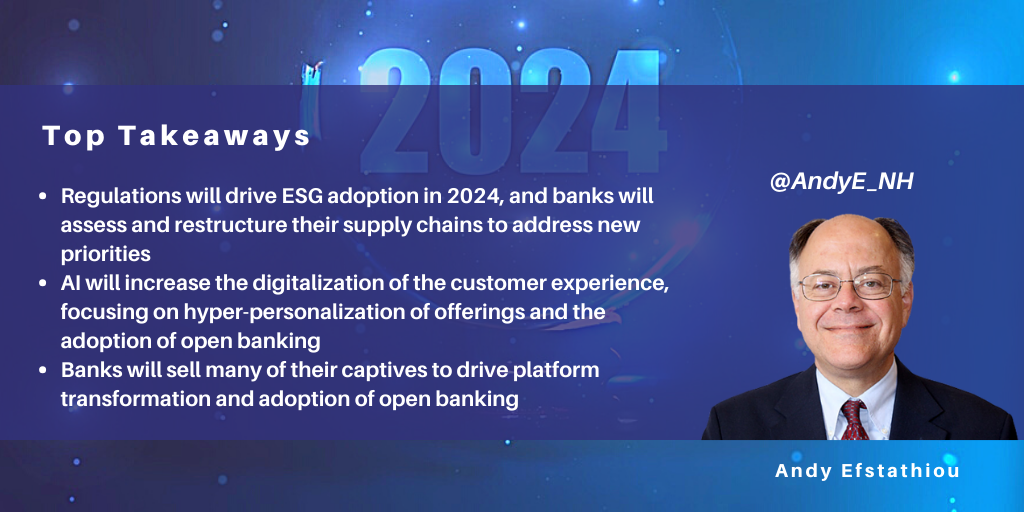
In 2024, the financial services industry will face strong economic headwinds. Usually, this is a formula for downsizing and consolidation. However, today’s headwinds are so strong that the industry will need to:
- Assess and restructure its supply chains to address new priorities such as ESG reporting
- Accelerate customer experience transformation to increase personalization and deliver many new, relevant product offerings
- Sell many more of its operations captives to accelerate digitalization and improve the brand experience across markets and business lines.
Prediction 1: ESG reporting
ESG activities will increase in North America, Europe, and India. There will be an increasing focus on auditability to mitigate “greenwashing” criticisms and make it more difficult for unscrupulous actors to engage in greenwashing initiatives.
Regulations will drive ESG adoption in 2024. The most advanced and demanding regulations are coming from thought-leading regulators in Europe, the U.S., and India:
Europe (Germany)
- January 2024: the EU’s Corporate Sustainability Reporting Directive (CSRD) requires companies to disclose their risks from environmental and social factors
- December 2023: the European Banking Authority disclosure of assets and activities and their exposure to climate change, customers’ and suppliers’ carbon exposure, Green Asset Ratio (GAR)
- June 2024: the European Banking Authority Banking Book Taxonomy Alignment Ratio (BTAR).
United States (California)
- April 2024: SEC-regulated companies must report their GHG emissions
- December 2024: Companies in California must establish processes for auditing their emissions data in anticipation of the 2026 reporting requirement.
India
- April 1, 2024: India’s 250 largest listed entities need to provide value chain ESG disclosures (the largest 150 entities were required to do so in 2023).
These regulations all target supply chain emissions and improve the auditability of enterprise ESG reporting. Many regulations target large corporations but, over time, anticipate lowering the size requirement for reporting ESG activities.
Prediction 2: accelerating digitalization of customer experience
In 2023, banks continued closing branches. 2023 was the fourteenth year of declining branches for U.S. banks, With PNC Bank and U.S. Bank each closing 10% of their branches. The decline of in-person banking options will continue to drive the digitalization of the customer experience. AI, including Generative AI, will drive the increasing adoption of digital customer contact services. The focus in 2024 will be on:
- Hyper-personalization of service offerings in response to a customer’s stated and implied preferences. These AI offerings will deliver less clutter to the customer and drill down to offer a few relevant offerings. Retaining these preferences will enable the customer to maintain an ongoing virtual conversation with the bank, rather than the current state of retelling the bank one’s preferences and goals each time the customer engages with the bank
- Accelerated adoption of open banking partnerships focused on providing specialized lending offerings to customers. Open banking has been slowly developing in response to regulatory requirements. Today’s economy has left banks facing capital and cost challenges, causing them to restrict their lending services. Meanwhile, customers seek customized lending services that meet their need for rapid approval and specialized financing for certain products or services. Open banking will enable banks to offload risk asset creation while enabling FinTechs to provide customers with specialized financing, including green loans. Many FinTech loan offerings delivered by open banking will be embedded finance offerings, becoming the future lending model.
Prediction 3: selling off captive operations
Financial institutions will sell many of their captive operations to improve cost efficiency. The emphasis will be on realigning costs to transform the bank’s business model. This will drive improved customer experience and greater operational agility across multiple businesses and markets.
The financial services industry is facing revenue declines and is looking to cut costs. The Financial Times estimates that the 20 largest global financial institutions have cut over 60k jobs in 2023 as of mid-December. This is the largest single-year decline in financial jobs since the Great Financial Crisis in 2008-09. Other industries are doing worse. Bloomberg estimates that 250k tech workers have already lost their jobs in 2023. The final numbers for the global economy will be larger, making cost control an even higher priority for businesses.
Captives are sold to third parties for three reasons:
- Operations and business model transformation: today’s banking economy necessitates banks transform their operations to service high-volume delivery at lower cost (e.g., premium wealth management services for mass-affluent clients and banking services for previously unbanked populations). Enabling this business shift requires pervasive digitalization of delivery, customer self-service where possible, and AI support for any remaining humans in the loop
- M&A enablement: banks are exiting non-core business lines and scaling core businesses. Most of the cost benefits of mergers are realized by rapidly integrating the two businesses. Third-party support for integrating the acquired entity into a single shared service center requires a technology operations provider focused on this transformation, after which it will scale down the integration force. Only third parties can provide the necessary skills at scale and still downsize upon completion
- Cost savings from reducing inputs (primarily labor) and sharing overhead across a larger operational volume (transforming a single tenant operation to a shared services environment).
Examples of these types of captive acquisitions include:
- Infosys-Stater: Stater is a large mortgage services provider in the Benelux countries. Infosys acquired 75% of Stater from ABN AMRO and is automating and managing its service delivery
- Infosys-Vanguard: Vanguard’s defined contribution business has partnered with Infosys to manage its service delivery, improve customer experience, and move its recordkeeping to the cloud
- TCS-Standard Bank (the largest African custodian): TCS will centralize and standardize the bank’s custody and securities settlement operations across 15 markets in Africa using TCS’ proprietary securities platform.
These activities will accelerate the digitalization of banking processes and the extent of open banking where institutions partner to deliver offerings to banking customers on shared platforms.
To keep up to date with NelsonHall's Banking research and thought leadership in 2024, subscribe to our Banking Insights newsletter on LinkedIn.
]]>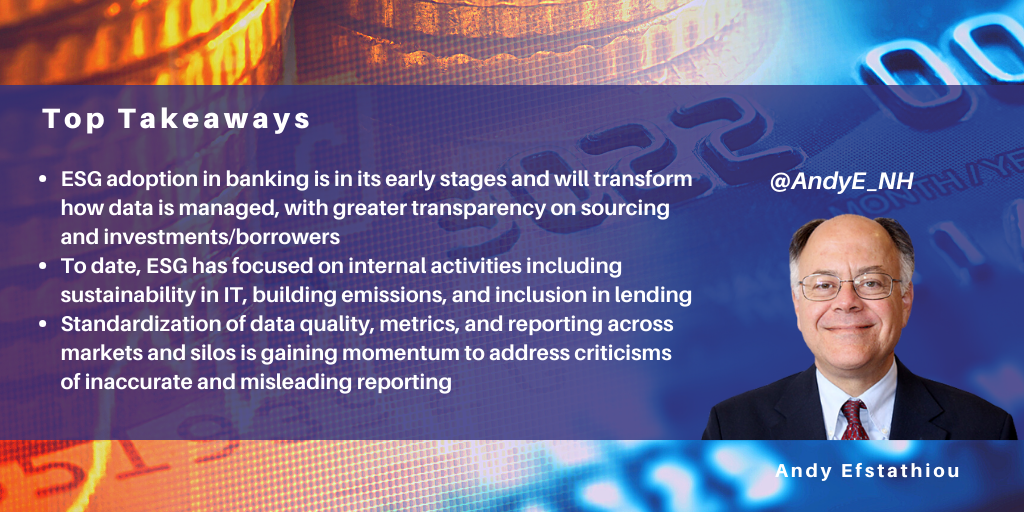
ESG services are an emerging set of tracking and reporting capabilities for enterprises. Emerging technologies do not mature in a straight line but cycle through peaks and valleys of development and adoption as they mature. In the past year, ESG services have passed from the euphoria stage of market adoption to the valley stage as the hype has been confronted by the real-world challenges of failure to meet expectations and outright fraud in some cases.
I am currently conducting a market assessment of how ESG services are transforming the banking sector, and here are some early findings.
ESG in Banking: early findings
The financial services industry is an early adopter of ESG reporting due to regulations that set implementation deadlines, and because of the data-heavy nature of the business.
Adoption is currently immature but is growing rapidly. Financial institutions are applying 60% of their efforts to environmental services, 30% to social services, and 10% to governance services. Social and governance initiatives are growing faster than environmental initiatives.
Currently, 70% of banks’ ESG initiatives are internal business activities, 20% investing and lending, and 10% supply chain activities (banks have small supply chains relative to manufacturing, wholesale, and retail).
Also, 80% of ESG activities have been focused on reporting, primarily for regulatory purposes. The remaining 20% of activities have focused on mitigating adverse ESG outcomes. As financial institutions are enabling better reporting, they are now accelerating their mitigation efforts.
Adoption is highest in Europe because its regulations are stricter than in other geographies, with earlier implementation deadlines. North America has the second highest level of ESG adoption. Regulations for ESG adoption in North America and Europe generally follow the same principles, with Europe implementing its regulatory deadlines earlier and with higher remediation hurdles. The rest of the world lags behind these two markets in adoption and has far less consistency in applying principles.
The adoption of ESG services in banking is concentrated in the following processes:
- Green IT: banks do not engage in manufacturing but manage large amounts of data. As such, their primary activities are delivered by IT systems. Reducing a bank’s carbon footprint in IT services is the primary path to increasing sustainability in bank operations
- Inclusion in lending/saving: a large percentage of all populations do not have formal banking relationships. Banks are reaching out to underbanked people as part of their social initiatives to provide banking services to unbanked consumers. The country with the highest level of activity in this area in India
- Rating investments based on ESG criteria for wealth and asset managers. This has been driven by regulation and customer preference. Sourcing, managing, and reporting the data is a massive undertaking, the buildout of which remains ongoing
- Rating carbon emissions data for real estate (buildings). Banks own, invest in, and finance real estate. Sourcing, managing, and reporting this data is more mature than for investments, but it is still an area that is growing
- Governance: financial institutions have fiduciary responsibilities to customers and regulators. Adapting their internal governance systems to deliver better ESG performance has been an area of growing importance over the past several years. Governance engagements are focused on consulting and change management activities.
Areas of emerging adoption include:
- Green lending: banks are experimenting with lending programs that provide a reduced interest rate when the borrower meets specific ESG requirements
- Standardizing metrics for evaluating the sustainability of suppliers and investments. Much of the pushback on ESG comes from using metrics that do not accurately reflect a company’s sustainability, such as greenwashing. Banks and ESG services vendors are working to identify relevant data and scrub it to make it a better indicator of an enterprise’s actual sustainability
- Standardizing the approach to ESG across lines of business and countries. Currently, multi-national banks have very different approaches to ESG issues across these silos. Banks are moving to standardize their approach to enable brand integrity and build a globally optimum response to ESG challenges.
Many ESG engagements are enhancing banks’ data management capabilities to assess and report on emissions. Below are two examples.
Case 1: British multinational bank and Capgemini
- Challenge: The client wanted to modernize its ESG data operating model and rationalize its data feeds on the emissions in its lending portfolio
- Scope of services:
- Built an ESG data store to measure the bank’s financed emissions
- Enabled tracking at the portfolio level
- Designed target operating model to deliver greater flexibility to changing regulations
- Designed data governance framework
- Benefits:
- Reduction in data sources: 50%
- Cost savings: $1m per year in third-party data sourcing spend
- Improved tracking and analytics capabilities
Case 2: Large capital markets firm and Infosys
- Challenge: The firm wanted to enhance its ESG data management for investments, and wanted to be able to:
- Ingest ESG investment data, validate it, and prepare it to be consumable at the issuer level
- Manage the large and variable number of structured and unstructured ESG data sources
- Scope of services:
- Created roadmap, conducted downstream impact analysis on consumption of ESG
- Vendor solution validation
- Implementation of ESG investments platform on AWS cloud
- Implemented NLP-based AI algorithms to support both structured and unstructured data
- Benefits:
- Productivity gain in data analysis: 50%
- Mapped 5k issuers
- Validated statistical accuracy of 400 ESG metrics
In December, I will be publishing a market assessment of ESG activities in banking, “Transforming the Banking Industry with ESG Services” which will delve deeper into how this global initiative is developing, what banks are doing to address these challenges, and how technology services vendors are supporting this transformation. Though this is a transformation that is still in its early stages, banking is one of the industries making the change quicker due to the regulatory deadlines it faces and its high use of IT services in all its business lines.
]]>
Financial institutions use legacy ERP solutions to monitor, control, and report on their business activities. At large institutions, most of these solutions were deployed in the 1990s and have inflexible architectures that need the requisite functionality to report on modern products, regulations, and industry practices. In this blog, I look at how Capgemini is helping clients tackle this challenge.
The Challenge
All financial institutions need to modernize their platforms because they have heterogeneous legacy environments due to M&A and an operational environment organized by product lines. In addition, differences in regulations and technology availability have required platform customization for each market. The market share for ERP solutions varies by sub-industry and specific market. The heterogeneous nature of all these systems makes consolidating product lines and general ledgers very difficult and often requires manual intervention.
In addition, these legacy systems face challenges, including:
- New regulations, such as IFRS 15 for banks and IFRS 17 for insurance companies, that will necessitate modernizing ERP platforms to remain compliant
- Legacy ERP systems do not have the functionality to track and report ESG issues. CFOs and all senior executives are beginning to implement ESG programs in their institutions and need to modernize their ERP systems to support ESG initiatives. Future system requirements for ESG services are not defined, so today’s platform renewal must enable flexibility to introduce new functionality with minimal disruption to the existing platform
- CFOs must close books quickly with data that provides one version of the truth. When the company decides to reorganize itself, the executives must be able to restructure systems across the new organizational structure and still generate the same reporting numbers. Today, with legacy EPR systems deployed in the 1990s, that is not the case.
As these market conditions continue to evolve, ERP solutions should be able to adapt quickly with minimal disruption to remain relevant.
Capgemini’s Approach to ERP Renewal
Capgemini has developed a program for ERP renewal in financial services to address this challenge in partnership with significant solution vendors. The program is customized by sub-industry (i.e., banking, capital markets, P&C insurance, and life insurance). Today, Capgemini partners with three solution vendors to address these problems: SAP, Oracle, and Workday.
Executives who buy these services are typically the CFO, CHRO, or CPO (Chief Procurement Officer).
Capgemini’s offering to modernize ERP platforms has five components:
- Assessments and roadmaps
- Implementation services
- Integration services
- Migration to the cloud
- Application management services.
During modernization, Capgemini rearchitects the technology environment to improve efficiency, declutter the environment, and remove customization. This “lift, shape, and shift” process to a cloud environment enables the client to convert from a Capex to an Opex cost model while achieving greater operational agility and a simplified technology environment.
Capgemini uses tools and accelerators to deliver this type of large complex project. The tools are part of its proprietary Large Transformation Program (LTP) Method. The method defines how to undertake business transformations, including successfully designing, building, and deploying solutions that can continue to evolve over time. An LTP is defined as a multi-year, multi-release, and multi-project delivery of solutions that evolve over multiple versions. Typically, LTP projects are globally delivered, requiring multi-tower services from a group of service partners. Typical benefits include productivity improvements of ~20% and cost reductions of ~30%.
Client Example
To illustrate how this is done, let’s look at an engagement with a leading multi-national, universal bank headquartered in London that wanted to transform its finance activities around an integrated general ledger (S4HANA) across multiple countries.
Business situation
The client wanted to modernize systems for country ledgers, A/P, A/R, project accounting, and fixed assets. The goals for the project were:
- Standardization and centralization of business processes
- Integration to feeder systems (e.g., T&E, B2B commerce, etc.)
- Integration of data platforms to risk data platform
- Enhance planning, budgeting, and financial closing systems using SAP FSDP to enable faster closing
- Improve cost allocation, profitability reporting, and transfer pricing capabilities.
Project scope
Capgemini delivered the following:
- An offshore COE for SAP S4HANA to support project delivery and ongoing maintenance and support
- Implementation of a Finance and Risk Data Platform
- Finance and profitability reporting using the client’s product data fields to allow franchisees and sales teams to receive accurate commissions on financial product sales
- Common data definitions and quality metrics to facilitate accurate data feeds across all bank systems.
Impact
The project delivered the following results:
- Center of excellence built with 98% offshore resources, which significantly reduced costs
- Reduced synchronization data from third-party systems to S/4 by 90% with 100% error-free status
- Implementation of Solution Manager automated job monitoring resulting in a 70% reduction in manual effort
- Migration from an HEC environment to a Hyperscaler environment reduced costs by 50%
- Reduction in manual effort and cost from move to cloud delivery
- New architecture makes implementing future platform changes easier and supports future business growth.
Summary
Large financial institutions have complex, heterogeneous legacy ERP systems that must change to address current market demands. Further, these systems will need to continuously evolve to remain relevant. Changing these poorly documented systems is a nightmare without a disciplined approach. Capgemini has developed an offering that cost-effectively addresses this challenge and enables financial institutions to improve user experience across employees, partners, and regulators.
]]>
Compliance is driving the adoption of ESG initiatives by enterprises, and currently Europe is ahead of other markets in the rigor of its ESG-related legislation and regulatory code. In this blog, I look at what Unisys is doing to make it easier for enterprises to comply with Germany’s Supply Chain Act.
Background
In 2023, several new regulations have increased compliance requirements in Europe. These include:
- Germany adopting the German Supply Chain Due Diligence Act (Supply Chain Act), effective January 2023. The law requires companies to observe basic human rights standards in their supply chains. Currently, the law covers direct suppliers. The EU is working on a law, Corporate Sustainability Due Diligence Directive (CSDDD) which will cover indirect suppliers and is applicable to all EU states including Germany; it is estimated to become effective in 2025
- The EU adopting the Corporate Sustainability Reporting Directive (CSRD), passed in January 2023, which requires EU and non-EU companies with European activities to file annual sustainability reports. These reports need to be prepared in accordance with European Sustainability Reporting Standards (ESRS)
- On January 24, 2022, the European Banking Authority announced new ESG disclosure requirements for EU banks, effective from 2023 and 2024. The requirements include disclosure of assets and activities and their exposure to climate change, customers’ and suppliers’ carbon exposure, Green Asset Ratio (GAR), effective December 2023, and Banking Book Taxonomy Alignment Ratio (BTAR), effective June 2024.
Further regulations are in the works. For example, in June 2023, the European Commission proposed regulating environmental, social, and governance rating providers that provide ESG opinions or ESG scores.
These regulations are increasing costs for all businesses and requiring fundamental data and operations management changes. It is no longer sufficient to monitor one’s operations; now, an enterprise must watch and report on third parties.
Unisys’ Approach to Compliance with the Supply Chain Act
In the past, ESG tracking solutions have been developed with individual modules for each regulatory requirement. Unisys’ approach is to build a single orchestration solution that manages the entire ESG process from a single dashboard. The ESG Orchestration Manager delivers:
- Tracking, processing, and managing supplier ESG data
- Automated risk scoring
- Supply chain transparency.
There are three components to the ESG Orchestration Manager:
- ESG portal: the supplier and whistleblower process for providing and processing relevant data
- ESG cockpit: a dashboard for managing tasks and reporting, including:
- Supplier management
- Whistleblower report processing
- Validation of risk analysis
- Risk scoring reporting
- ESG insights: provides risk scoring, social media monitoring, and digital bill of materials (DBOM), including:
- Risk analysis of suppliers
- Dashboard with geolocated supplier risk ratings
- Risk rules management
- Supply chain risk scoring
- Social media and news monitoring.
The benefits provided by ESG Orchestration Manager compared to previous approaches to ESG regulations include:
- A single solution allowing rapid compliance with this new regulation and providing flexibility to adopt new requirements into the existing solution
- Proactive use of media analysis, mitigating the risk of reputational damage
- Mitigating risk of penalties, which can run to 2% of global revenues
- Providing insights into primary and secondary suppliers
- Facilitating understanding of supply chain dependencies
- Enabling auditing of data.
Conclusion
Unisys’ ESG Orchestration Manager offering fills a need for enterprises to rapidly and inexpensively comply with the first stage of a series of Know-Your-Supplier regulations. The initial cost of compliance is high, but the ongoing cost of compliance will continue to increase.
By developing a flexible solution that can adapt to future requirements, enterprises can reduce their current and future cost of compliance while deriving useful information to drive immediate improved operational performance.
]]>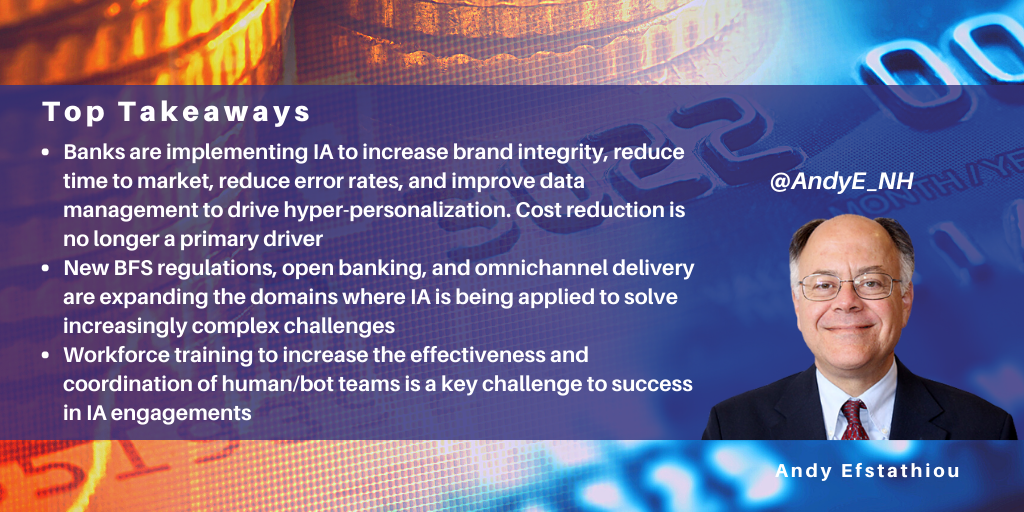
NelsonHall has just completed the research for a market assessment and forecast report on Transforming Intelligent Automation Services in Banking. We found that banks have accelerated the adoption of IA services in operations over the past two years, a shift that has been driven by:
- Declining operating margins on legacy businesses
- Pursuit of new customer demographics to replace the older customer cohort, which requires banks to launch and deliver new products digitally
- Changing business models (primarily to open banking) driven by regulations.
By transitioning operational delivery from manual to digital processing, financial institutions can drive:
- Greater brand integrity from consistent execution
- Faster time to market for new and seasonal products
- Reduced error rates which reduce costs and enable settlements on shortened deadlines
- Improved data management, which enables hyper-personalization.
IA adoption pattern
Tier-one banks have been the primary adopters, with every tier-one bank having an active IA program. Regional banks and industry services providers are increasing their commitment to IA projects. Only 30% of regional banks had IA programs three years ago; today, 75% of these banks have active IA programs. Local banks are where regional banks were three years ago, with 30% having active IA programs. Capital markets firms are late adopters but are beginning to adopt IA services to serve high-net-worth customers and meet reduced settlement deadlines.
The pace of lower-tier banks starting IA programs is accelerating, and three years from now we expect all financial institutions to be fully committed to IA in their business. The growth in clients and project scope will drive growth rates of IA revenues to 16.5% per year for the next five years to 2028. Managed services for IA operations will grow 17% over the forecast period. Growth has been fastest in mature markets, but now the emerging and APAC markets are growing faster than mature ones.
Financial institutions are focusing their efforts on the following:
- Operationalizing IA use cases: banks are deemphasizing the building of POCs to find ways to use IA and are instead concentrating on identifying high-impact use cases that can be operationalized to create value
- Improving data management: banks are changing their focus from improving data management within silos to improving data sourcing, management, and reporting across silos
- Expanding the pool of skilled employees to implement IA: banks are focusing on implementing tools (such as low/no code) that enable non-technical employees with domain expertise to build IA solutions with business impact at lower transaction volumes
- Enabling human/bot coordination and increased effectiveness: these initiatives are the least mature. Currently, banks are coordinating human/bot routines on customer-facing activities (i.e., customer contact, advisory, and lending origination). Banks are beginning to explore human/bot coordination in back-office settings, including settlements, reconciliations, and collateral management.
How vendors are enabling IA initiatives
Vendors are helping clients accelerate their IA initiatives by delivering enablement in four areas:
- Process identification and mapping: undertaking comprehensive process discovery, reengineering, automation, and embedding intelligence into processes that were previously unmapped and manual. The goal is to expand the footprint of automation in operations until all processes are digital or at least touched by digital services
- Data management: delivering three critical areas of data management:
- Data sourcing and scrubbing, focusing on standardizing data across a bank’s silos of products, markets, and sub-industries
- Expanding the range of data banks utilize into voice, image, and unstructured data
- Implementing predictive AI to support customer interactions and service
- Productizing IA offerings: the IA market has developed quickly. Most vendors have capabilities but not productized offerings. Vendors have developed productized offerings in the past two years to support lower-tier financial institutions and bank subsidiaries. These target clients are looking for rapid deployment of best practice capabilities at low cost
- Workforce effectiveness: delivering three areas of improvement:
- Developing IP, which supports employees and stakeholders in delivering IA projects with less training and fewer technical skills. This type of IP includes COEs, accelerators, APIs, low/no-code solutions, and solution libraries
- Training, including online, in-person, hackathons, and academies
- Coordination of worker/bot teams with user journey design tools and training.
Outlook
IA services in BFS are continuing to evolve new offerings and use cases. Developments include:
- New regulations, including:
- Open banking regulations, which will necessitate automating processes with third parties. This will involve integrating processes across counterparties not part of the initial financial institution. Integrating and automating processes across enterprises raises the challenge of coordinating governance
- Instant payments, which require increased automation to reduce error rates and faster settlement
- Faster securities settlement times, which require reduced error rates and faster settlement
- Application of relevant regulations to customers as they move across markets with differing regulations
- Data management, including:
- Management of third-party vendors and agents
- Use of increasingly powerful analytics requiring it to be used judiciously as well as effectively
- Increased application of IA to the omnichannel environment to:
- Increase customer choice of how to interact with banks
- Support customer interpretation of offers with visual and audio information
- Support the financial institution in understanding customer requirements and sentiment from real-time feedback analysis
- Expanding automation activities from customer-facing processes to back office and fulfillment processes. Automation to date has focused on customer interactions. Automation and AI will increasingly be applied to fulfillment processes and integrated into front-office processes.
Increasingly, business value from IA projects is less about cost savings and more about business agility. The ability to bring products to market faster and provide operational support for rapidly changing offerings is more important than cost savings on sunsetting offerings.
]]>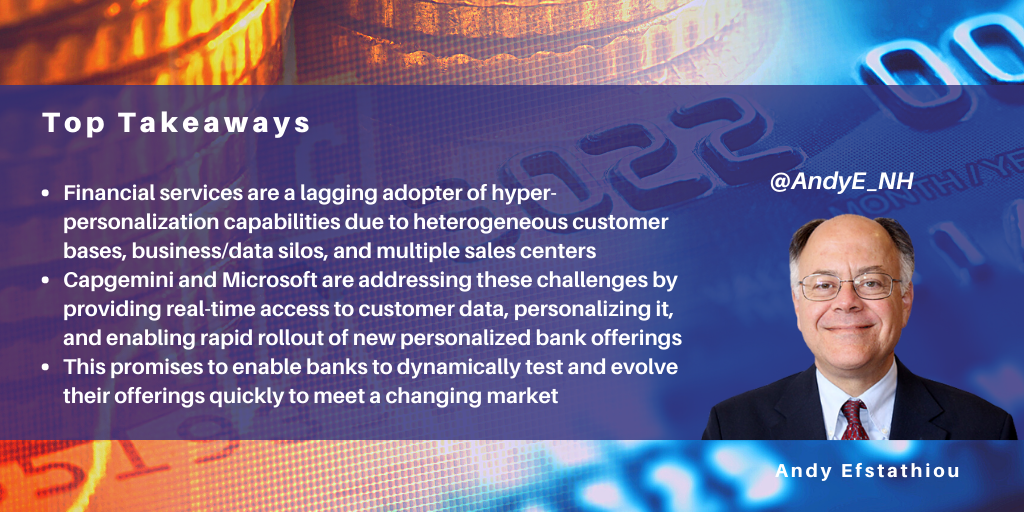
Capgemini has partnered with Microsoft to develop and market a dynamic hyper-personalization offering for the financial services industry. This blog explores how hyper-personalization capabilities can be adapted to the unique needs of the financial services industry.
Background
Enterprises want to increase the personalization of their offerings to customers to increase CSAT and sales success. However, effective personalization is an immature art. Enterprises have been using machine learning (ML) to drive the personalization of sales and marketing offerings to their customers. Still, the challenge of ML here is that the user can only generate incomplete information due to the iterative nature of the trials and limited contextual data. The ML bot can only observe the response to a chosen action but doesn't know the answer for other possible actions (i.e., it cannot analyze hypotheses, it can only analyze historical activities).
One method of increasing the effectiveness of personalization initiatives is using contextual-based ML techniques to improve recommendations. ‘Contextual bandits’ is a technique that reinforces the learning algorithm by using contextual information about the environment to make real-time decisions and using rewards at each step. Microsoft has embedded this technique in its Azure Personalizer solution, which enables enterprises to improve their personalization efforts to achieve better CSAT and sales closure.
The Challenge
Financial services is a lagging adopter of hyper-personalization capabilities. Early adopters are consumer industries, including CPG, consumer electronics, and media. Financial services lag in adoption due to the following:
- Heterogeneous customer bases: at the retail level, banks mix consumers and SMBs into a single practical customer base, which often has the same decision-maker, but differing needs and behaviors
- Multiple sales centers: M&A has led to multiple silos selling and competing with each other with the same products for the same customers. Banks continue to be organized by product lines, which also compete for the same clients from product silos.
These characteristics of the banking environment have made traditional AI and ML techniques a poor predictor of consumer behavior. If banks can apply additional parameters and data to understand consumer behavior better, they can develop improved personalized offers. The challenge in achieving this level of analysis is that the banks need to:
- Integrate data across channels, silos, and sources
- Access data across heterogeneous systems and environments
- Better understanding of customer needs
- Deliver personalized, integrated offers across channels.
Capgemini’s Approach
Capgemini and Microsoft have developed an offering to address these challenges. The contributions from the two companies are:
- Capgemini - IT and business services:
- Financial services solutions and accelerators aligned with Microsoft offerings
- IT services for Azure deployments and Microsoft Cloud for Financial Services
- Access to industry specialist ecosystem
- Microsoft - three software products:
- Azure Personalizer, which provides modeling tools and algorithms to contextualize a user’s content reactions
- Semantic Knowledge Graph, which extracts relationships from data and derives features for use in AI models
- Azure Synapse, a cloud-based analytics tool.
Financial institutions have had difficulty effectively implementing the infrastructure to drive hyper-personalization initiatives. Capgemini works with Microsoft and clients to drive this forward across multiple silos and LOBs. Critical to Capgemini’s activities is the ability to build systems that:
- Use real-time data
- Render the data analysis useable (using the Knowledge Graph)
- Personalize the data
- Develop a real-time trial offer
- Roll out successful offers
- Learn from mistakes in real-time.
Critically, the offering should be able to offer customers the best existing product and suggest new products for development. Suggesting product development is especially important for industry transitions, including the deployment of new regulations and changes in customer buying trends (for example, due to demographic differences). The offering also works with SMB customers, not just consumers.
This offering fills a need for financial institutions to help create personalized offerings for customers, especially from new demographic groups. Financial institutions use AI to analyze past data within silos to develop customized offerings but have not yet been able to create forward-looking offerings in response to changing conditions. This offering promises to enable banks to dynamically test and evolve their offerings quickly to meet a changing market.
]]>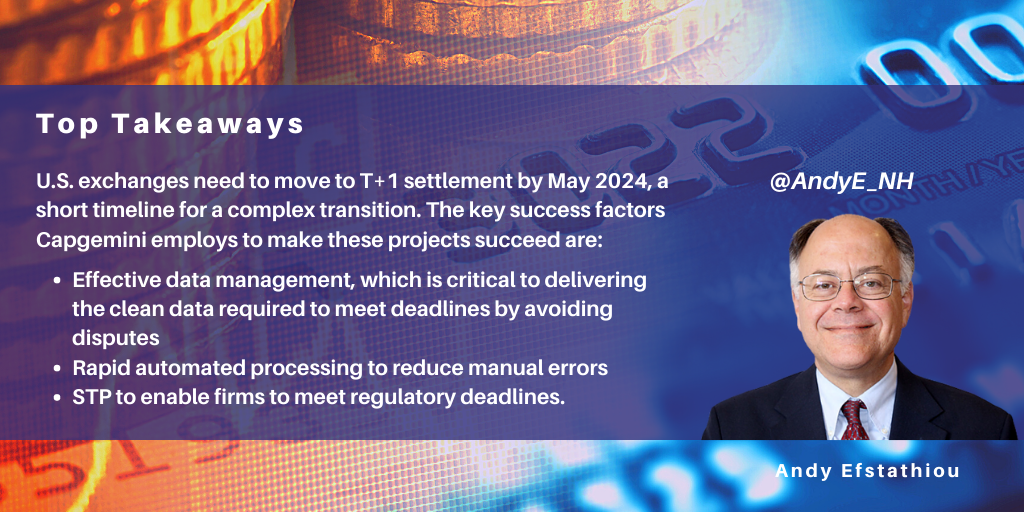
The securities industry is moving towards shorter settlement cycles to reduce risk and increase efficiency. The last reduction in settlement windows in the U.S. was in September 2017 when settlements moved from T+3 (three-day settlement) to T+2. In February 2023, the U.S. SEC announced that all companies trading securities on U.S. exchanges needed to move to T+1 settlement by May 28, 2024. Canada has indicated their markets will align with this settlement timeframe and other global markets are also considering alignment. Eventually, all markets will reduce their settlement times, as they have done in previous rounds, to remain competitive globally.
In this blog, I look at the challenge of shorter settlement cycles and how Capgemini is helping clients tackle the challenge.
The Challenge of Shorter Settlement Cycles
Reduced settlement times provide two primary benefits:
- Reduction of margin required to be posted at DTCC to insure against the risk of adverse market moves during the settlement period before security is delivered
- Increase in capital available for reinvestment in businesses, due to the above reduced margin requirements and access to settlement funds one day earlier.
However, there are risks to counterparties in implementing shorter settlement times. Major risks include:
- Shorter deadlines require greater accuracy and faster processing of trades. This means financial institutions need to increase their automation of settlement processes to reduce manual error and increase execution speed
- Trading in multiple markets, with different daily deadlines, means the effective daily deadline is even shorter for certain multi-market trades. The cost of an error and the difficulty of syncing counterparties is much more difficult than in a multi-day settlement process (and will be exponentially more difficult under a T+0 deadline). Again this places more pressure on settlement systems to be fast and accurate
- Ancillary activities, especially securities lending, are heavily impacted. Securities lending are likely to generate a higher level of fails, and fails can eliminate all the profit from the lending contract. Again, the new process will need to be robust enough to reduce fails to a level where lending activities are not driven to be unprofitable
- Trading volumes are not spread out evenly during the day. The majority of trades typically occur near the end of a trading session. Batch processing of trades under a shorter deadline is likely to have an adverse impact on the ability to affirm trades. In a T+1 environment, there is simply much less time to take most of the trade volume and process it in the window available.
Transforming legacy settlement systems in the 12 months remaining to go-live will be difficult. Depository Trust and Clearing Corporation (DTCC), which provides clearing and settlement services to the U.S. markets, recently surveyed its clients and found that over 50% are unsure they can meet the deadline. Most will have to turn to third-party help to implement the complex process and infrastructure changes required.
Capgemini’s Approach
Capgemini has built an offering to support industry participants looking to transform their legacy environment in time for the deadline. The key components of this offering are:
- Readiness assessment: assessing the client’s legacy platform, which requires highly specialized knowledge due to the nature of capital markets' post-trade systems
- Solution design and implementation planning: designing solutions that increase post-trade automation and implement these solutions on top of the existing platform
- Implementation: implementing a regulatory-compliant solution in an environment that is delivering high-volume ongoing services daily
- Testing: internal testing to assure success with the custom internal platform and external testing to coordinate with industry and regulatory partners
- Post-go-live remediation: to fix flaws and upgrade solutions over time
- Managed services: ongoing support as required and/or full outsourcing.
The key success factors for these projects are:
- Effective data management, which is critical to delivering the clean data required to meet deadlines by avoiding disputes
- Rapid automated processing to reduce manual errors
- STP to enable firms to meet regulatory deadlines.
Delivering these services successfully in a compliant fashion requires industry experience and a methodical plan to address each participant's custom environment. Achieving a compliant launch for complex custom systems in a 12-month timeframe, when over half of the participants are unsure they can meet the regulatory deadline, will require participants to use best practices as soon as they evolve within the next 12 months.
The business impact of successfully transitioning to shorter settlement deadlines is that counterparties will free up working capital to reinvest in their businesses. Collectively this will generate greater industry liquidity and reduce transaction costs for both investors and issuers. Greater market liquidity will allow more efficient markets to put more capital in both investors’ and issuers’ pockets.
Support from third parties will assist organizations with industry coordination and best practice adoption on this fast-track systems conversion project. Capgemini is well placed to capitalize based on its new offering and its track record in successfully assisting clients with T+3 to T+2 transition.
]]>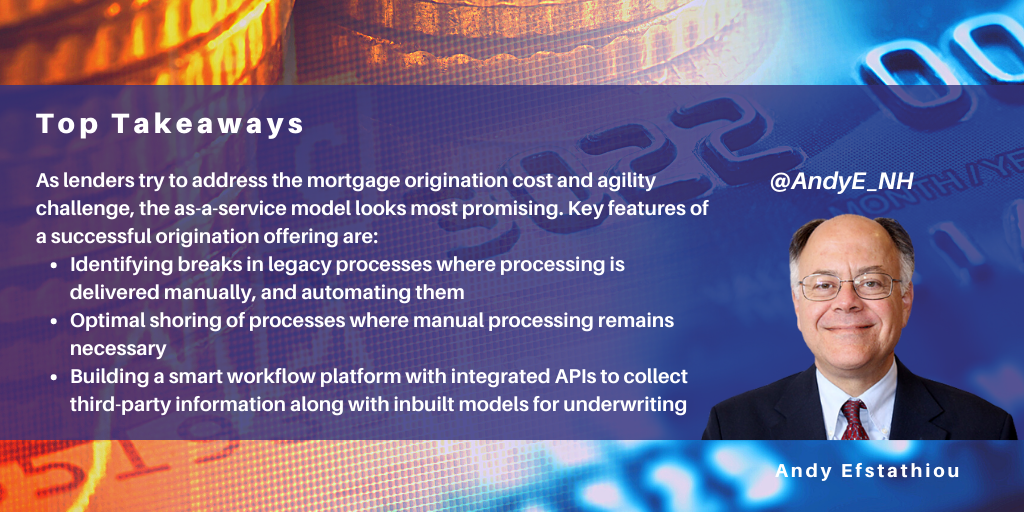
The lending business is highly cyclical due to its sensitivity to interest rates, economic cycles, and capital availability to fund loans. According to the Mortgage Bankers Association, these factors are currently driving down mortgage originations, which have fallen 60% y/y in the U.S. in Q4 2022.
The decline in originations pressuring the margins of this high-cost activity is the leading change in the industry. Delinquencies, while currently low, are expected to grow rapidly over the next year as the economy slides into an anticipated recession. Banks need to increase their agility to deal with these volume shifts cost-effectively. There are two key levers to address the shift in processing volumes:
- Automation, which enables an absolute reduction in OPEX based on upfront investment
- Outsourcing, with committed volume flexibility, enables the matching of revenues and costs.
Of the two, the more compelling savings can be made from automation, as long as transaction volumes across the entire business cycle can justify the initial investment. Mortgage origination is a clear first choice for automation because:
- The cost of mortgage origination in the U.S. is typically 10x the cost of servicing ($5k to $10k per loan in the U.S. depending on product complexity and lender platform maturity)
- Origination remains mostly a manual process. Most Loan Origination Solution (LOS) platforms in the market are providing only partial STP processing, relying mostly on manual sub-processes
- Originations are highly cyclical.
Lenders and services vendors are trying to address the mortgage origination challenge, and while no single model has won the market, the as-a-service model looks most promising.
WNS has developed a mortgage-as-a-service (MaaS) offering, working with mortgage lenders for years, and has identified many typical breaks in legacy processes where processing is manually delivered. Critical to the success of a MaaS offering is bringing the most effective resources to bear at each step of the process. The choices include:
- Intelligent Automation of manual processes, where possible
- Optimal shoring of processes, where manual processing remains necessary
- Flexibility for clients to opt for unit-based pricing model
The key steps in the origination process where MaaS transforms processing are:
- Pre-processing and sending initial loan estimate: after receiving the application, the MaaS delivers an initial loan estimate within three days. All offshore delivery
- Third-party orders: auto-triggered order checks including flood, credit, verification of employment, verification of deposit, title, mortgage insurance, appraisal, fraud, etc. All offshore delivery
- Document validation: documents have data extracted and are converted to a digital loan file. Exceptions are handled manually. All offshore delivery
- Conditions management: decision engine and underwriting, automatically raising conditions for consideration by loan officers. Combined onshore/offshore delivery
- Document reviews: review and analysis of income, collateral, asset, title, Agreement of Sale, and fraud. Combined onshore/offshore delivery
- Approval: onshore lender works with the offshore team to approve the loan package. Combined onshore/offshore delivery
- Loan closing: LE and CD prep of documents; schedule closing with the title company. Combined onshore/offshore delivery
- Transfer to servicing: digital loan file transfer to servicing platform. All offshore delivery.
The backbone of the MaaS offering is a combination of
- Smart Workflow platform with integrated APIs to collect third-party information along with inbuilt models for underwriting
- Intelligent automation powered by RPA and Artificial Intelligence.
The MaaS service integrates with the client LOS platform and digital front end to deliver services to bank customers. Because the offering is modular, clients can buy point solutions to automate individual components of the origination process.
Technology is necessary, but not sufficient for successful transformation of the loan operations process. The human element is a critical component of the success of the MaaS offering. The MaaS offering incorporates the development and utilization of talent with a comprehensive understanding of the mortgage process, associated challenges, and parameters of compliance and non-compliance. Initial and ongoing training and examinations in end-to-end loan review including compliance measures are required to continually improve the quality of performance and service levels that complement the areas of automation.
WNS’ MaaS offering has been delivering lenders benefits including:
- Productivity gains of 3x from automation and global delivery
- Customer inquiries and complaints: 50% reduction
- Reduction in loan origination costs: 40%
- QA/QC processes eligible for automation: 70%
- Loan final closure in 15 to 20 days.
These benefits are especially compelling as origination volumes decline and a MaaS service connects costs to revenues, allowing for costs to decline as volumes plummet. We expect to see the industry produce more MaaS offerings as the economy continues to shift. Early vendors, such as WNS, will have more mature offerings as lenders shift to outsourced as-a-service operations models.
]]>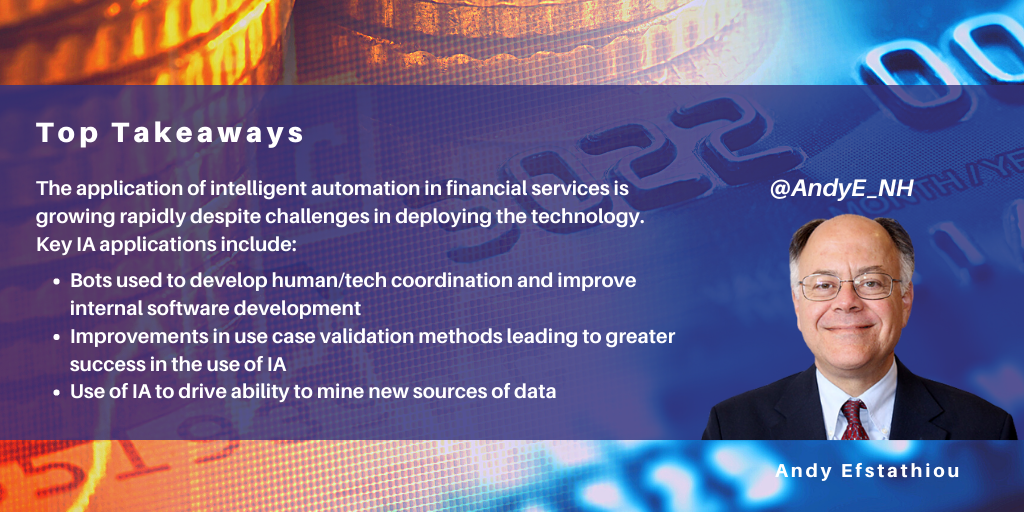
In the financial services industry, there was an initial expectation that demand for intelligent automation (IA) would fall off as clients changed platforms and moved to a microservices architecture. Instead, the application of IA in financial services has grown rapidly. The initial evidence from my current study shows that despite challenges deploying the technology effectively, the ability to bring decision making to the line-of-business user at a low cost of implementation makes a compelling value proposition.
Despite its ability to accelerate accurate, transparent process execution, implementing IA effectively is challenging. Key challenges include:
- Use case failure rate: the majority of use cases have not met their promised returns. Most POCs have not been operationalized. Increasingly, ITS vendors have had to build COEs and use case libraries to increase the cost effectiveness of IA projects. Success rates are rising, but only where ITS vendors are able to marry client operational knowledge with industry best practice
- Orchestration of bots: operations is a dynamic environment and bots are unable to reskill or change jobs without advanced orchestration services. Performance degrades rapidly in a poorly orchestrated environment
- Dynamic nature of business processes, including cyclicality, reengineering, and sunsetting: the tempo and structure of operations changes with time, requiring continuing process reengineering and new use case development
- Heterogeneous core banking platforms: most banks today are an amalgam of multiple platforms. Deploying automation across multiple environments and architectures requires process discovery, reengineering, and consolidation.
Despite these challenges, IA activities have taken off because:
- Banks lack sufficient investment capital for full platform replacement
- Bots have benefited from increasing functionality, mostly due to increased AI capabilities, which enable them to deliver greater value. For example, banks need to increase their employee productivity. The AI used for bots has been used to develop human/tech coordination capabilities which have enabled better customer interactions and improved internal software development
- Technology services vendors and banks have improved their use case validation methods, leading to greater success in operationalizing initiatives.
Over the past several years, as automation services have matured, banks have begun narrowing the number of processes they are spending resources on automating. Processes where IA is increasingly applied are:
- Technology development, especially software development
- Customer contact, especially human/bot delivered contact; often focusing on support for independent agents (such as third-party mortgage originators or independent wealth advisors)
- Cyclical processes, such as loan originations/collections, payments, and portfolio due diligence
- Compliance, with a heavy focus on KYC and AML processes
- Data management, especially in mining new sources of data (from social media and third-party data vendors).
IA adoption will continue to grow faster than overall technology adoption in the financial services industry because banks need to move fast to deal with rapidly declining margins and the need to change their business models. Automation vendors are remaining relevant in this developing market by investing heavily in building more AI functionality. Vendors who are struggling are the ones who have failed to embed robust new AI functionality in their offerings. Ultimately, intelligent automation is less about process automation and more about helping banks orchestrate their labor forces and business partners to deliver service to customers.
]]>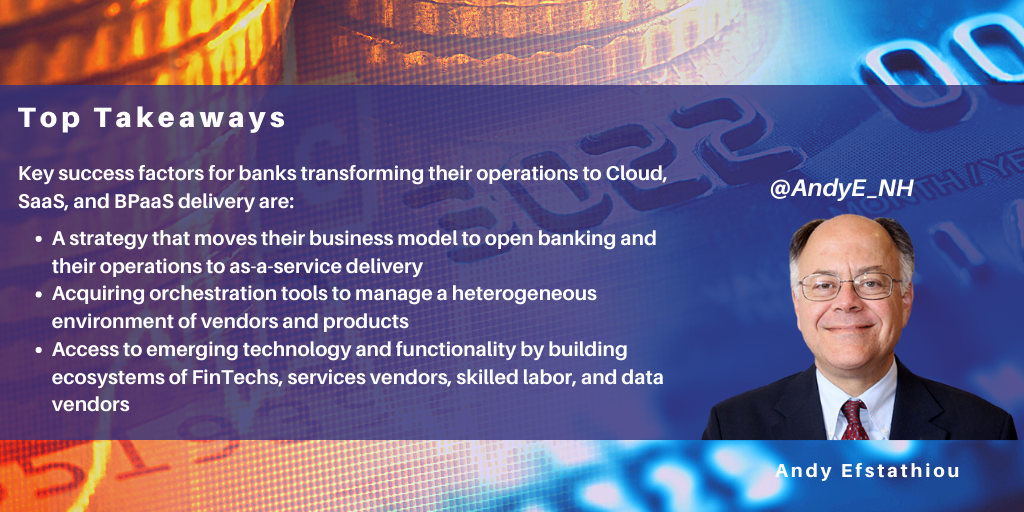
NelsonHall recently completed a market assessment and forecast report on Transforming Financial Services with Cloud, SaaS, and BPaaS Services. It reveals that the financial services industry is responding to the industrialization of cloud services from hyperscalers and IT services vendors by transforming its platforms to microservices architectures and then moving them to the cloud. Data management across markets, businesses, and entities has moved to center stage to drive compliance and customer management.
The operational transformation challenge
Tier 1 banks are looking for increasing operational agility with migration to cloud and as-a-service delivery. Smaller banks require productized solutions and SaaS/BPaaS services. All banks are increasing their data management and AI purchases. In the future, banks will move towards SaaS and BPaaS to reduce labor costs and increase the configurability of their businesses. Operational delivery will become agile to support reducing time to market and accommodate volume fluctuations.
However, the external environment has put up barriers to transformation. The key barriers impeding banks’ transformation efforts include:
- Platform modernization: legacy mainframe platforms need to be redesigned into a microservices architecture. Finding teams that can work with both legacy and modern languages is difficult
- Data management and analysis: effective use of AI requires large databases from which to derive insights. Most bank portfolios are too small to generate large data sets for meaningful analysis
- Accessing emerging technologies: skilled labor remains in short supply and worker turnover has made it worse
- Creating a roadmap: new business models require experimentation and agility, which large banks find difficult to undertake effectively.
Financial institutions must adapt transformation strategies
To transform their businesses, financial institutions will have to:
- Create a strategy that moves operations to the cloud and matches costs to revenues to enable greater agility. They will have to change their business model to an open banking model
- Build an ecosystem of operational vendors including: hyperscalers, with each one providing services in their area of expertise; IT services vendors with knowledge of the client’s environment; and FinTechs with key functionality
- Redefine the split of operations between external processes (high value, cyclical or one-time) and internal processes (lower value/less volatile)
- Acquire orchestration tools to manage a heterogeneous environment of vendors and products
- Transform application development to a DevOps and low/no code model to speed the innovation cycle and enable LOB staff to have greater input.
Services vendors are supporting clients with different services for each environment:
- Cloud: support for entering new markets and enabling open banking
- SaaS: data management tools, analytic tools, and data and solution provider partnerships
- BPaaS: offerings focused by line of business which have high volatility (e.g., collections and securities)
- Platforms: provision of low code/no code DeFi coding capabilities, APIs to solution/data vendors and industry consortia, enhanced solutions with hyperscaler partnerships, and orchestration tools to manage hybrid multi-cloud environments.
Summary
In summary, high competition and regulatory change is driving banks to focus on changing their business models and product mix. The change to shorter product cycles and lower margins means banks changing their operational focus from cost efficiency for fundamentally static businesses to agility for continuously changing businesses. Cloud, SaaS, and BPaaS infrastructure will drive accelerating change in banks’ product offerings, customer base, and market presence. The financial industry is at the start of a long-term transformation of its business model.
Find out more about NelsonHall’s Transforming Financial Services with Cloud, SaaS, and BPaaS Services market assessment and forecast report here or contact Guy Saunders.
]]>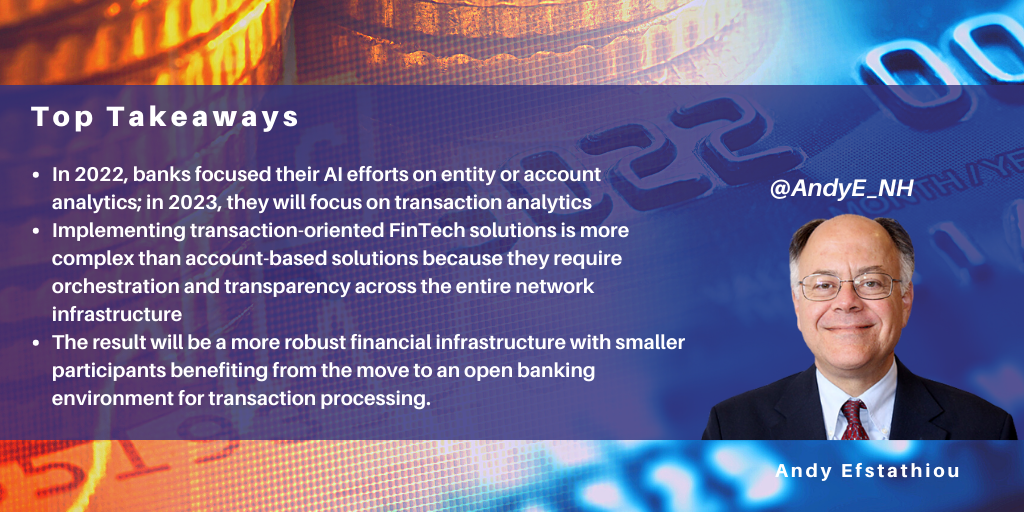
2022 has been a very strong year for IT services firms delivering cloud, digital, and AI services to the financial services industry. 2023 looks to be a very different year for these vendors as they are finding it difficult to hire skilled resources, find clients able to fund new large projects, and partner in strategic growth areas. Successful BFS technology consultants will need to focus limited resources in a few key growth areas to have a successful business in 2023. One strategic area for growth will be implementing transaction processing AI and data management tools.
To date, banks have focused their AI efforts on entity or account analytics. Typically, these tools provide customer service (e.g., customer onboarding and next-best recommendations) and compliance support (e.g., AML/KYC). We believe in 2023 banks will turn their compliance and customer analytics focus from entity analytics to transaction analytics. Financial institutions are driven by evolving regulations, which today are emerging faster from Europe than other geographies. Europe has several new regulations which are driving a change in focus to transaction monitoring. These include:
- The Digital Operations Resiliency Act (DORA): DORA seeks to mitigate the risk of cyber attacks on financial operations. Previous regulations took a balance sheet-based approach to risk mitigation by requiring capital buffers to address operational risk. DORA takes an operational approach to mitigating risk by requiring technology (i.e., cloud, supply chains, and IT outsourcers) to operate with transparency, rigor, and resiliency. The act was published on 11/17/2022, will come into force by Q1 2023, and financial institutions will be required to have implemented it by Q4 2024.
- A pilot regimen for market infrastructure in DLT: Passed June 2, 2022 by the EU, this regulation covers trading of currencies/securities using blockchain technology in multilateral trading facilities and settlement systems
- Regulations governing real-time payments/transactions: regulations include PSD2 and various securities settlement regulations, which have been shortening the settlement windows for various securities transactions towards an ultimate goal of instant transactions. Platforms need to move from batch processing to real-time processing with improved security and risk management to mitigate fraud and credit risk. An example of real-time payments implementation is the launch scheduled for summer 2023 of FedNow, the Federal Reserve bank’s instant payment service.
These regulations will drive securities exchanges, payments networks, banks, and capital markets firms to deploy cloud orchestration and AI FinTech tools to improve security and reduce operational risk. Already financial institutions are starting projects to address these challenges. Examples include:
- Goldman Sachs Transaction Bank (GS TxB): On Sept. 15, 2022 GS TxB announced a partnership with Stripe to provide corporate treasury services with embedded finance (the ability to make payments as part of the treasury application). This service requires APIs and AI to manage and deliver transaction flows safely and securely.
- State Street Bank launching a peer-to-peer repo program for the buy side to reduce the cost of collateral management, which is a critical trading cost. This facilitates bilateral trading by counterparties with varying credit and capital strength.
Implementing these transaction-oriented FinTech solutions is more complex than account-based solutions because transaction-oriented solutions require orchestration and transparency across the entire network infrastructure. These projects will be driven by the market exchanges and tier one institutions, but will require cooperation from all market participants.
The result will be a more robust financial infrastructure with smaller participants benefiting from the move to an open banking environment for transaction processing. The promise of safe digital payments in a decentralized environment will not be achievable without these investments in securing the industry infrastructure. The industry and regulators are committed to delivering on the promise, so the implementation work will start in 2023.
]]>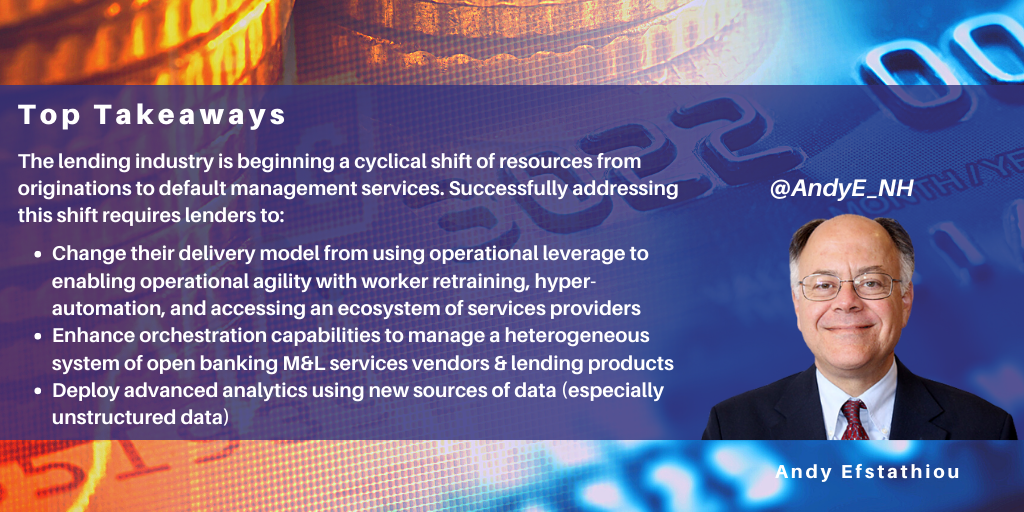
In NelsonHall’s recently published market assessment, Transforming Mortgage and Loan Services, we found that lenders are changing their approach to mortgage and loan operations from a focus on BPS and integration services to a focus on cloud migration and data management services.
The goal for lending institutions today is to be able to support open ecosystem models, new product introductions, and process automation delivered for a wider range of lender types based on cloud-delivered operations. The pace of industry change is increasing, while the industry begins its cyclical shift from a focus on originations to default management services. The shift to cloud and digital-first delivery has expanded the scope of transformation projects as more processes are opened to third-party partners.
The state of digital operations in the lending industry
For the past year, lending institutions have been:
- Implementing intelligent automation to reduce manual processing and increase accuracy
- Migrating to a hybrid cloud to increase flexibility for new functionality and product time to market
- Building data lakes to coordinate data across silos without replacing their entire data structure
- Providing customers with self-service tools to reduce the cost of delivery and increase CSAT with faster resolutions.
Today, financial institutions anticipate an aggressive decline in originations and increase in lender defaults. This will necessitate downsizing originations and growing default management capabilities. To meet this market shift, over the next year, financial institutions will focus on:
- Increased use of consulting and combined ITS/BPS to identify a road map and convert CAPEX to OPEX
- Reskilling of origination workers to default processes to scale up default work
- Rearchitecting the lending platform to a microservices-based cloud-native application with an architecture that could integrate into their other platforms
- Testing and running open banking environments to start building an ecosystem of participants and a library of business models.
However, the external environment has put up barriers to transformation. The key barriers impeding the efforts of financial institutions include:
- Useful adoption of analytics: new sources of data (especially unstructured data) provide greater opportunities for the use of AI. However, only tier one lenders have access to large internal data pools. Smaller lenders must draw from industry-wide data pools. Smaller markets and product runs present similar issues: developing quality data for analysis remains difficult
- Access to emerging technology: all service vendors are building ecosystems for emerging technologies and acquiring staff skilled in relevant technologies. Finding the best new technologies and embedding them in effective platforms remains difficult
- New products and markets: lenders are rolling out new loan products rapidly, requiring a response from other lenders in order to remain relevant. The new products require high automation, omnichannel access, and high compliance capabilities
- Access to qualified staff: changing technologies change the required mix of staff skills, and distributed work environments (primarily WFH) limits knowledge transfer. Currently, cloud migration, AI, and default management skills are the least available capabilities.
Rising to the challenge
To address these challenges successfully, lending institutions need to focus on two activities: strategy and process execution.
Key factors in strategy include:
- Creating a roadmap to move operations to the cloud and match costs to revenues, as origination volumes decline and collections volumes grow
- Changing the operational model: M&L managers need to shift from operational leverage to leveraging agility (the ability to cost-effectively switch out workloads). This requires increased process discovery to identify processes for automation. The business model needs to support an open banking environment
- Building an ecosystem of operations vendors with domain knowledge and experience with clients’ operations environments, vendors with complementary digital skills to deliver services, and the ability to work within client operational practices and transfer knowledge.
Key factors in process execution include:
- In the short term, staff training to renovate skills for cyclical issues (i.e., default management) and technology (FinTech, cloud, and IA)
- Preferred services vendors should have the widest pool of Fintech solution providers supporting them
- Data management and orchestration drive accuracy, efficiency, and compliance. Lenders need to build COEs and libraries of successful RPA and data management use cases
- Transforming application development to a DevOps and low/no code model to speed the innovation cycle and migrate to cloud delivery
- Orchestration: selection and implementation of orchestration tools to manage a heterogeneous system of (open banking) M&L services vendors and lending products.
In summary, lending institutions are changing their goals from improving process efficiency for originations to increasing operational agility across sub-processes and ramping up collections capabilities. Margin pressure is too strong for lenders to achieve their business goals with just operational efficiency enhancements. Lenders need to change their business models (from closed platform/static product offerings to open platform/evolving product lines) to enable them to access best practice, best-cost services on-demand, to drive their operational performance.
]]>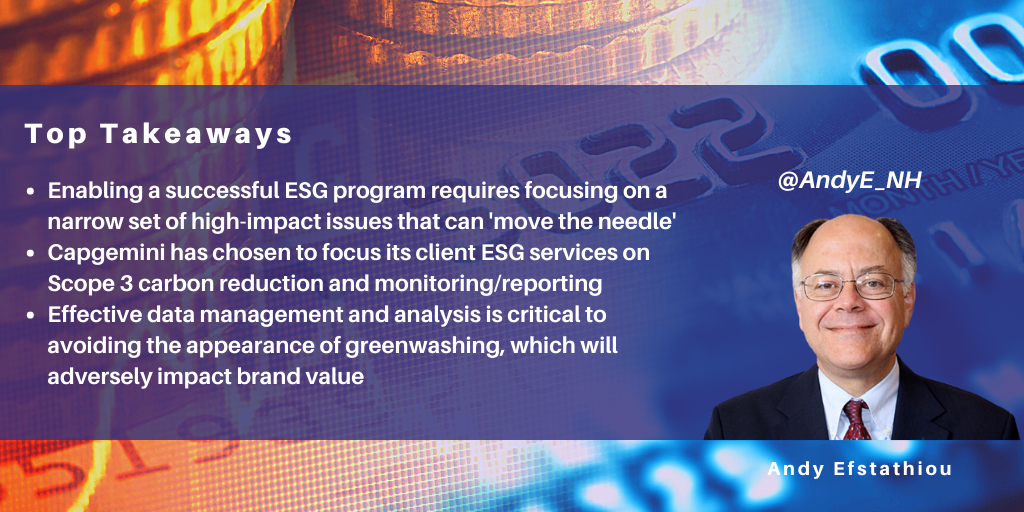
ESG is a hot, but poorly defined, topic. Many firms and investors have started ESG programs, but recent allegations of “greenwashing” and ineffectiveness have undermined confidence in them. So, what are the components of an effective ESG program? ESG is a wide set of dissimilar goals (e.g., carbon emissions reduction is very different than social inclusion). By focusing deeply on a few goals, enterprises can drive more profound change while building the framework for expanding the range of ESG activities as an ESG initiative matures. With this in mind, Capgemini has developed a set of ESG services to enable clients to methodically design a roadmap for establishing goals and improving their ESG performance.
Capgemini and ESG
Capgemini began its ESG journey by focusing on carbon emissions reduction. It has built a framework for pursuing its goals and is committed to achieving carbon neutrality by 2030. The focus of its ESG efforts is:
- Reducing/neutralizing carbon footprint (it has committed to carbon neutral operations by 2025 and being a net zero company by 2030)
- Reporting on ESG scores to the marketplace and stakeholders.
By developing its internal ESG program, Capgemini experiments and brings best practices to its consulting practice. It provides support in three areas for clients:
- Commit: consulting services to identify a vision, develop a roadmap, and scale and adjust priorities over time
- Act: implementing an ESG program with actionable initiatives to drive sustainability across customers, operations, and infrastructure. Capgemini partners with BFSI clients to focus on carbon reduction by creating sustainable products and services, bringing optimization and paper reductions through sustainable operations; and finally, in green IT, accelerating initiatives around legacy modernization and Cloud migration to deliver large carbon footprint reductions. The focus within each of these three initiatives is:
- Sustainable Products/Services/Experiences: New Revenue streams or distribution models as well as new products and services to drive greater resilience and sustainability through the customer base
- Sustainable Operations: ESG programs for financial institutions typically concentrate on Scope 3 carbon emission reduction. Banks and Insurers are also actively reducing their paper usage, with marketing and internal documents the typical focus
- Sustainable IT: IT is typically one of the largest emitters for financial institutions. There are several levers that can be pulled across applications, infrastructure and ways of working. For example, Cloud migration has delivered large carbon footprint reductions because cloud data centers are typically 70% more carbon efficient than internal data centers.
- Monitor and support: monitoring and reporting on ESG efforts enable stakeholders to evaluate progress and enable compliance with regulations (ESG regulations are strictest in Europe today). Capgemini helps develop a data strategy, build a data hub, and operate a data reporting and performance evaluation program. Unstructured data is increasingly important to ESG programs. Structured data (e.g., carbon emissions) change slowly over time, but sentiment (i.e., unstructured data) changes rapidly. Monitoring and reporting on sentiment are increasingly important to the successful management of an ESG program.
BFSI client demand
BFSI clients are buying each of these three services, but few buy more than one line of service, reflecting the maturity of their ESG programs. In the past twelve months, Capgemini has delivered 50 ESG projects for BFSI clients.
The types of engagements in highest demand by banks and financial institutions are:
- ESG strategy: key project components include clarifying purpose, setup strategy, choosing priorities, design roadmap, and functional operating model
- Designing new products and services: key project components include identifying new areas to explore, developing products/services, and identifying/building partnership ecosystems
- Moving to zero paper: key project components include identifying paper intense processes, developing strategy, redesigning processes, redesigning customer interaction/channels, and digitizing documents
- Face the data challenge: key project components include identifying KPIs for business needs, designing data strategy, creating data architecture, building risk models, and building reporting dashboards
- Green IT for sustainability: key project components include calculation of carbon emissions from IT products/procedures, and identifying workload optimization strategy to mitigate emissions.
Capgemini’s accelerators include:
- Tools focused on data management and analytics, including:
- 890: a plug-and-play AI and analytics product hosted on AWS
- IDEA: Industrialized Data & AI Engineering Acceleration to reengineer an enterprise’s data estate
- ESG 360: a data hub for ESG data
- Partner ecosystem including third-party data providers and accelerators to measure ESG in banks’ portfolios
- Thought leadership and COE, including participation in ESG consortiums and panels to support critical thinking about, and broad adoption of, ESG principles.
To date, adoption of ESG initiatives has varied widely by geography, with European institutions very active in ESG, especially projects for operations and monitoring. In North America, institutions have been slow to adopt ESG initiatives, with most projects focused on consulting engagements to define ESG goals and new business models. The difference in adoption has been driven by stricter ESG regulations in Europe than in the Americas.
Conclusions
ESG encompasses a broad range of activities. Enabling a successful ESG program requires focusing on a narrow set of high-impact issues that can “move the needle” and develop internal skills relevant to ESG for an enterprise. Capgemini has chosen to focus its client ESG services on Scope 3 carbon reduction and monitoring/reporting. Financial services institutions buy ESG services based on their level of ESG maturity. Effective data management and analysis is critical to producing quality management and reporting of ESG initiatives. Failure to accurately curate data has led to widely reported incidents of “greenwashing” and immediate loss of brand value. To mitigate that risk, institutions must employ best practices, proprietary IP, and industry vendor support.
]]>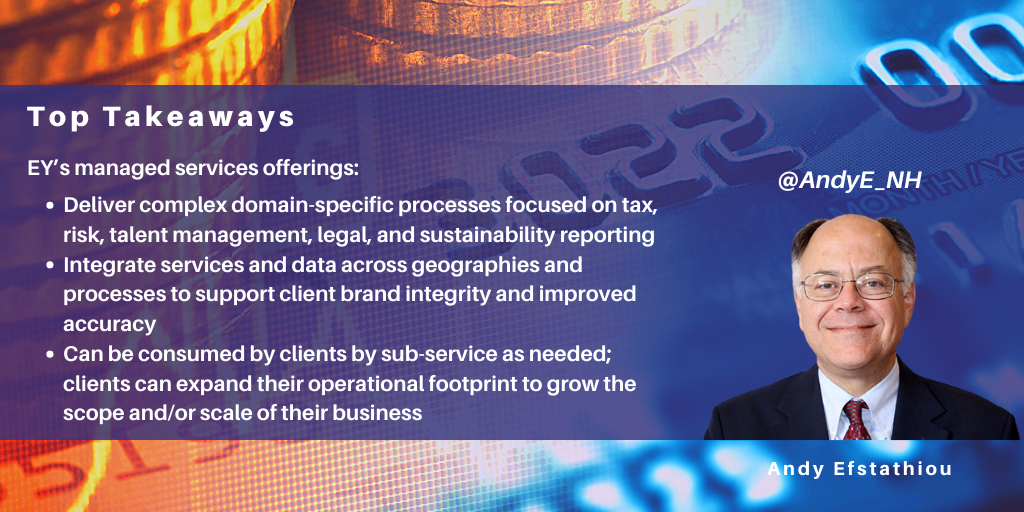
I recently attended the EY Managed Services Analyst Summit. EY’s managed services business just finished a gangbuster year, growing 30% over the prior year, with some sub-segments growing at rates up to 150% y/y. Managed services is EY’s fastest growing line of business, justifying EY’s 12-year-long commitment to this business. Here I look at EY’s managed services business, why it is satisfying a need in the market, and where it is going.
EY’s managed services offerings
The managed services business is expanding EY’s services offerings from advice and compliance to operations delivery services. EY’s managed services business differentiates itself from traditional BPO services by delivering “insight and enablement”. This means they wrap in consulting services and a technology platform (delivered using a microservices architecture) to provide higher value processes requiring domain knowledge and advanced functionality. EY employs three key competitive differentiators in these offerings:
- Domain expertise: drawing on its industry and process practitioners for best practices and each market’s custom requirements
- Integration: drawing on EY’s global delivery capabilities, including the EY fabric, proprietary IP, and alliance partnerships
- Orchestration: the delivery frameworks, infrastructure, and platforms to orchestrate consistent delivery across multiple markets and sub-industries.
The event showcased five of EY’s core managed service offerings including:
- Finance and Tax:
- Customer tax operations and reporting
- Enhanced corporate reporting and compliance
- Managed services and treasury
- Finance managed services
- Financial planning and analysis
- Tax and finance operate
- Risk and Cyber:
- Cyber operations
- Financial crime
- Risk managed services
- Forensics managed services
- Internal audit
- Compliance as-a-service
- Talent:
- Payroll
- Global mobility
- Legal: Legal managed services
- Sustainability: ESG reporting.
Finance/tax and risk/cyber are the most mature offerings. The most recent offering is sustainability, which was started two years ago. All offerings draw on resources from EY to support their delivery. For example, clients requiring LIBOR loan contract novation buy legal managed services. Lawyers and AI in legal managed services review contracts, but compliance services and GAP analysis are sourced from the risk/regulation practice. The most important shared service is data analysis and management. Data management capabilities support all managed service offerings (and all EY offerings).
Managed services delivery
Critical to the delivery of value is EY’s ability to deliver across enterprise silos, both geographic and line of business. EY’s consistency of delivery across global silos enables clients to build and maintain brand integrity across products and markets. Customizing delivery for each client requires multi-year commitments for most managed services offerings. Client retention is high and over half of new engagements are sole sourced, typically from existing EY clients.
EY enhances and delivers its managed services with its partner ecosystem. EY relies on a smaller, focused set of partners to co-innovate, create, and deliver its managed services. The three partners that presented at the event are Microsoft, SAP, and ServiceNow.
In each industry, EY works with additional partners to develop industry-specific offerings. For example, in BFS, EY works with additional partners including Pega, Experian, and Finacle.
Looking ahead
The two areas of focus for alliances over the next several years are optimizing existing offerings and developing new offerings. Developing improved data management techniques across markets will be a key focus.
EY managed services are targeting large global enterprises, many of whom are looking for support in their smaller markets, but eventually rolling out the services to home markets. As organizations are adapting to the digital world, the internal buyer is often changing from a process executive (e.g., compliance or risk manager) to a line of business executive. These new buyers need more technical expertise from vendors with greater domain skills. The nature of engagements is shifting to a combined IT/BPS offering with ongoing joint investment to drive increased efficiency and functionality over time.
Conclusions
The economy has changed over the past three years, driving costs up and increasing the dispersion of operating results across enterprises. To address this challenge institutions are looking for third-party help with the operational delivery of non-differentiating processes.
EY managed services is delivering complex domain-specific processes focused on tax, risk, talent management, legal, and sustainability reporting. It can integrate services and data across geographies and processes to support brand integrity and improved accuracy. Clients can consume sub-services as required, and expand the operational footprint as required to grow the scope and/or scale of their business. EY’s approach has been validated by the business’ high growth and client retention rates. Its ongoing investment plans to build greater infrastructure and broader offering sets should propel the business on an equally high growth rate over the next five years.
]]>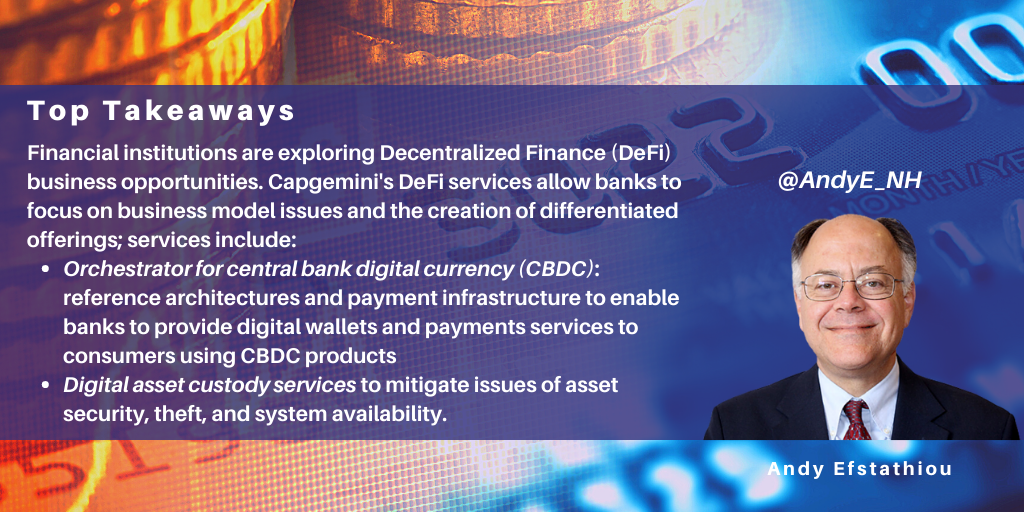
Industry background
Financial services are very centralized, with exchanges, central banks, and custodians delivering platform-based services to any user who wants to make a financial transaction or own a financial asset/liability. Decentralized finance, DeFi, is a financial system built on distributed ledger technology (DLT or blockchain) that allows a user to transact and own without an intermediary or centralized principal.
DeFi is in its early days, so the exact outline of such a system and the benefits achievable is not yet certain, but increasingly investors, including incumbent financial institutions, are building DeFi POCs and operations. Key DeFi applications being developed include decentralized:
- Payments: cryptocurrency and central bank currencies (CBDC)
- Lending (peer-to-peer)
- Exchanges (digital assets including securities, financial instruments, and currencies)
- Contracts (trade finance)
- Digital assets and Non-Fungible Tokens (NFT).
Interest from financial institutions is growing rapidly, with over 80% of central banks considering the establishment of digital currencies and over 7k cryptocurrencies now in existence. The key question is: how can financial institutions explore and execute a strategy for building a DeFi set of offerings without diverting large sums from their existing business and at the same time reinventing the wheel?
Capgemini’s framework and approach
To address this emerging opportunity with its clients, Capgemini has developed a set of assets and capabilities. Key components of Capgemini’s DeFi capabilities include:
- Tech Radar: evaluates and provides a POV on emerging technologies. Currently, 300 items have been assessed for the DeFi domain
- Digital Asset offerings: integration services for the digital asset custody lifecycle
- Trusted Data Exchange: an accelerator that enables data exchange for blockchain technology
- Blockchain Garage: consultants who work with clients to identify use cases, develop POCs, or integrate blockchain technologies into legacy platforms
- Ecosystem partnerships: a partner ecosystem of product and platform vendors
- Academic research: applied research programs with academic institutions
- Thought leadership: Capgemini published thought leadership pieces to identify trends and Capgemini’s POV on DeFi opportunities and challenges.
Both the opportunity and the challenges for DeFi are very large. To make an impact on commercializing this emerging technology, Capgemini has decided to focus its efforts in two areas:
- Orchestrator for CBDC products: central bank digital currencies can provide payment capability to consumers who currently do not have access to the financial system (financial inclusion). It can also reduce the cost of cross-border transactions. Because digital currencies can embed code, they are programable to promote governmental goals. These currencies will need custodians to reduce consumer risk. This will likely be retail banks that will store the currency in digital wallets for consumers. Capgemini is building the capabilities and running the POCs with banks to support orchestrating and managing CDFCs. Examples of engagements to date include:
- Working with SWIFT to build CBDC integrations to enable cross-border, cross-digital currency payments
- Developed reference implementation of a decentralized crypto exchange
- Built a distributed trade finance platform for a trade finance industry participant
- Developed payments infrastructure for multiple central banks
- Digital asset custody: digital asset custody is necessary to address the issues of asset security, theft, and system availability. Large retail banks typically have internal teams working on setting up digital asset custody services. Capgemini is targeting all other types of retail banks with services including Consulting, Implementation and Operate. Capgemini has domain-specific custody IP in asset tokenization, asset transfer networks, digital wallets, on-chain settlements, security, lending, and reporting. Because time-to-market is critical in this fast-evolving market, middle-market banks are looking for pre-packaged solutions that can be configured and rapidly deployed.
Conclusions
The financial services industry currently operates on a highly centralized operating model. The model works well, but the centralized model has high cost and complexity. Cost and complexity effectively limit access to the industry to customers, vendors, and products that already have large financial resources. DeFi operates on a decentralized model using DLT technology to deliver service without intermediaries or centralized principals. DeFi offers the promise of lower cost and greater access for transacting and owning digital assets.
The scale and speed of the transition to a DeFi business model are very high, which requires vendors and banks looking to succeed to focus on a few opportunities and specialize in building a competitive advantage. At the same time, any initiative needs to be plugged into an ecosystem of FinTech vendors to provide infrastructure and context to each bank’s initiatives.
Capgemini has built, and is growing, an ecosystem of FinTech vendors for the DeFi opportunity, and has chosen to focus on two opportunities in the DeFi space (orchestrator for CBDC products and digital asset custody).
These mutually reinforcing opportunities position Capgemini to provide infrastructure services (both implementation and management) for individual banks’ initiatives. These offerings will allow banks to focus their efforts on business model issues and the creation of differentiated offerings for their markets. By reducing time-to-market for new DeFi offerings, banks should be able to create new businesses and attract new customers who have never participated in the financial services industry previously.
]]>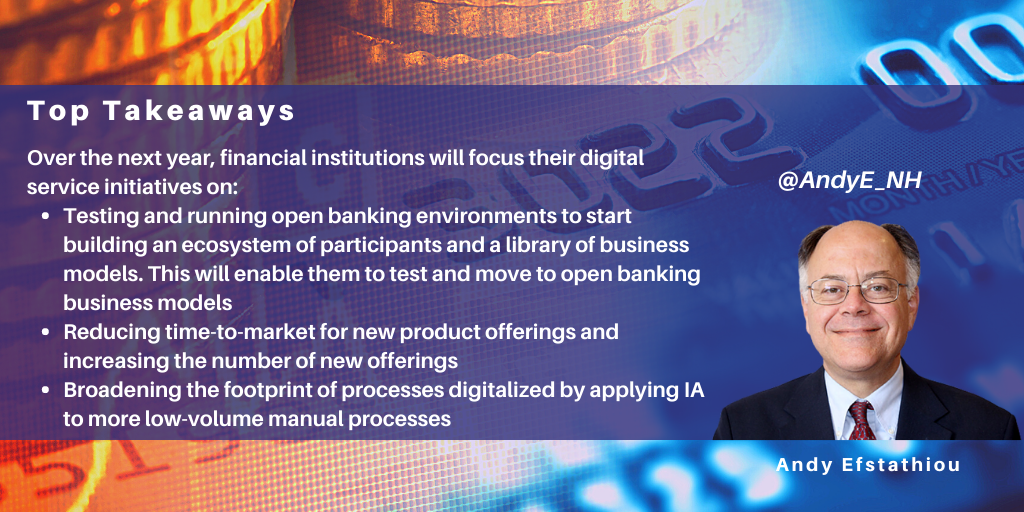
In NelsonHall’s newly published market assessment, Digital Banking Services: Transforming the Financial Services Industry, we found that financial institutions are changing their approach to digital services: from a focus on digital channels and CX to a focus on rapid solution development, cloud migration, data management, and STP.
The goal for financial institutions today is to be able to rapidly iterate new business models in an open banking environment. The pace of industry change is increasing, while labor-based operations are slowing financial institutions’ abilities to respond. The pandemic has accelerated the pace and scope of change as all business functions have had to move to remote delivery.
The state of digital services in banking
For the past year, financial institutions have been:
- Expanding the use of automated software development tools, low-code/no-code techniques, and APIs to enable platform modularization, new functionality, and the move to the cloud
- Standardizing data management and orchestration across silos
- Accelerating the use of cloud delivery and BPaaS.
Over the next year, financial institutions will focus on:
- Testing and running open banking environments to start building an ecosystem of participants and a library of business models
- Increasing their focus on human/bot teams and their effectiveness
- Reducing time-to-market for new product offerings and increasing the number of new offerings
- Applying intelligent automation to more low-volume manual processes.
However, the external environment has put up barriers to transformation. The key barriers impeding the efforts of financial institutions include:
- Opening the core platform to external parties: open banking and new stakeholders requires development of APIs and plugins for legacy platforms to increase interoperability
- Enabling new digital business models: increasing platform agility and new functionality to support new businesses
- Building and enabling partnerships: sourcing IP from open source, acquisition, or shared products
- Working with new markets and products: different markets and products have different cost structures. Banks are shifting to high-volume/low-margin products (e.g., customers: mass affluent and unbanked; products: self-service and robot-advised). These offerings require high automation, embedded AI, multi-channel access, and high compliance capabilities, each adapted to multiple, unique markets.
Rising to the challenge
To address these challenges successfully, financial institutions need to focus on two activities: strategy and execution.
Key factors in strategy include:
- Changing the business model: banks need to reduce fixed costs and be able to scale volumes at a constant margin to be able to rapidly change business models across time and markets
- Developing a roadmap to achieve agile/flexible operations delivery using cloud/BPS/heterogenous delivery
- Building an ecosystem of operations vendors with domain knowledge and experience with clients’ operations environment, vendors with complementary digital skills to deliver services, and the ability to work within client operational practices and transfer knowledge.
Key factors in execution include:
- Working with hyperscalers: migrating internal operations by standardization, consolidation, and modularization of platforms
- Redefining the external/internal operations split (with the rollout based on tested use cases):
- External processes: high value, non-repetitive, cyclical processes
- Internal processes: lower value/less differentiation/less volatile
- Selecting emerging product vendors for functionality, roadmap, financial strength, and the product vendor ecosystem. Preferred vendors should have the widest pool of IT services providers supporting them
- Orchestration: selection and implementation of orchestration tools to manage a heterogeneous system of vendors and products.
In summary, financial institutions are changing their goals from improving process efficiency for static businesses to increasing operational agility to continuously changing business models and operations. The operational changes being made will drive business model change. And these operational changes will drive accelerating change in banks’ product offerings, customer base, and market presence.
Find out more about NelsonHall’s “Digital Banking Services: Transforming the Financial Services Industry” market assessment and forecast report here or contact Guy Saunders.
]]>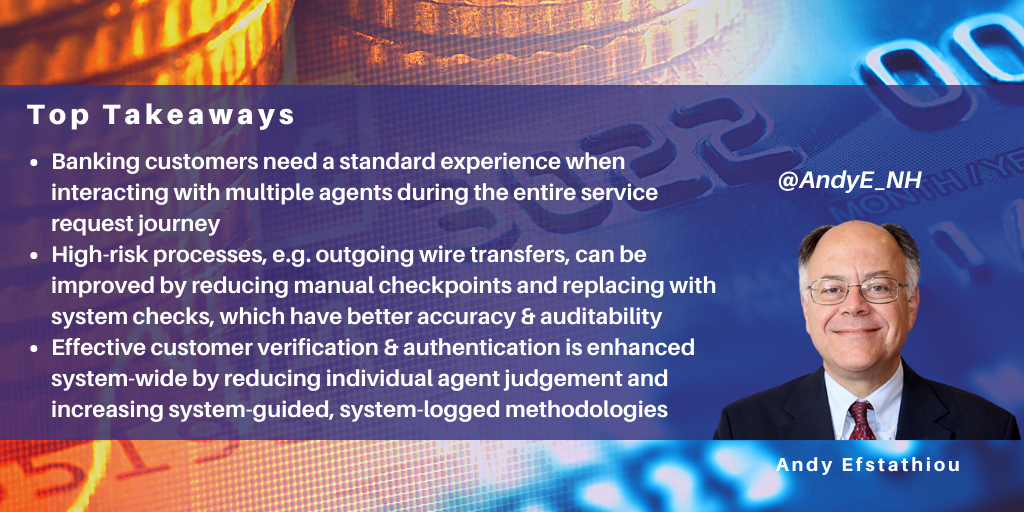
Digital transformation has accelerated in the banking industry since the start of the pandemic. This blog describes some recent digitalization activities a bank undertook with Xebia to improve its customer contact processes and provide differentiated service with increased efficiency.
The challenge
A U.S.-based neo bank began experiencing ongoing high call volumes in its call center. The result was lower customer satisfaction, lower staff productivity, and increased processing costs. To address the challenge, Xebia delivered a 5-week process discovery and consulting project to:
- Identify issues
- Propose process and application redesign
- Propose a business process reengineering blueprint for the entire contact center.
The implementation phase of the project was estimated to take 9 to 10 months. I asked the Xebia executive team to describe the changes they made to some of the processes and platforms that have enabled their client to deliver a differentiated experience for their customers. The questions cover three key areas: call center operation, outgoing wire transfer, and customer verification and authentication.
Call center operation
Q: A key component of your customer experience transformation was standardizing call center processes. Why is it critical to standardize CX processing?
A: For a call center, or any service organization, most activities performed by the staff/agents are repetitive tasks executed as part of facilitating customer requests and inquiries. Hence, it’s important to follow a standardized process so that the training time and effort are reduced and newly onboarded staff can come up the curve very quickly so they can handle customer calls ASAP. From a customer’s standpoint, they must receive a standard experience while interacting with multiple call center agents during a particular service request journey or their entire life cycle with the bank in general.
Q: What were the key components you proposed and implemented for CX process transformation?
A: From a functional point of view, multiple features and capabilities were proposed as part of the overall solution. Primarily these were in two major categories:
- Inquiry: A unified Customer Servicing Platform that allows agents to have a comprehensive and organized view of the customer profile, product holding, and multiple other criteria that are crucial to handling customer calls. This not only includes system-curated information but also analytically driven variables and personalized recommendations that empower agents to drive more informed conversations and decisions while on a call with the customer
- Action: The same Customer Servicing Platform consists of mechanisms to perform multiple actions and serve customer requests from the same channel, allowing end-to-end fulfillment and enablement of any customer request. The platform is integrated through the bank’s core systems, which will allow STP loops through a single portal and help the bank improve staff efficiency and overall service experience for the customer.
Q: How did these changes improve CX? What were the benefits achieved?
A: The program is not just a system implementation project. It also includes a revamp of some of the organizational processes and is envisaged to have both tactical and strategic benefits. Some of the expected outcomes are as follows:
- TAT and call waiting time reduction for the customer through standardized processes: 35% to 75% reduction in TAT depending on sub-process
- Improved staff efficiency through simplified processes with a reduced number of steps. (16 steps reduced to 4 steps and 17 steps reduced to 11 steps in two key processes)
- All-round audited actions and service closures for improved governance and security
- Enabling service staff to drive revenue for the bank through targeted cross-sell recommendations over the portal
- Reduction in overall staff training time resulting in a reduced overall cost of operations for the department
- Improved visibility of service ticket journey and overall success KPI matrices for the department.
Outgoing wire transfer
Q: Outgoing wire transfers is a high volume, complex process. Describe for us the ‘As-Is’ process and the ‘To-Be’ process you designed.
A: Indeed, wire transfer is complex and was one of the primary focus areas of improvement for us during the discovery exercise. Because it was one of the very few processes where the outflow of funds was involved, it became even more important to have the right level of checks and authorizations at each relevant process node even after simplification.
The As-Is Process involved the customer calling up the call center and requesting a wire transfer. After the standard customer verification, the call center agent would send the ‘wire request form’ for the customer to complete, an editable PDF file, which the customer would fill in manually and return to the bank. The customer would then call the contact center again and the form would be cross-verified manually by the agent against information available across various systems within the bank. Once verified, the agent would send the form to the Ops team who would once again verify the information and then post the transaction into the partner bank portal, where a standard maker/checker setup would be followed. After the transaction was posted, the Ops team would also maintain an entry, manually recording the wire transaction and customer details in a centrally-shared file, which would be utilized by the risk teams and other departments of the bank for any reporting or post-facto anomaly identification.
The To-Be Process we designed reduced the manual checkpoints and enhanced them with system checks. This reduced the overhead from call center agents and improved the accuracy of these checks. Further, the information on the customer wire request form was converted to a web form with pre-filled customer profile information. The customer simply verifies the pre-populated information and fills in the specifics about the wire transaction to be executed. The capture of information at each step happens digitally with the help of web forms, making the generation of any logs for post facto transaction reviews simpler and extremely efficient.
Q: What are the key differences in your approach to transforming this process versus alternative possibilities the client was considering?
A: The fundamental approach towards transforming this process was based on the following guiding principles:
- Consolidating system touchpoints: As part of serving a request, the call center agent toggles between multiple systems to gather information and act upon it. In the proposed processes, various channels were integrated into one central platform which was used for both inquiry and action purposes
- Automating decision checks: Wires require checks to be performed during the entire process to ascertain the accuracy of customer-filled information and funds applicability for wire transfer, and these checks were being done through multiple systems. These checks were automated, providing huge benefits both in terms of freeing up bandwidth for call center agents and reducing errors that happen with manual checks
- Improving auditability of every action performed by agents over the platform and providing better visibility at retrievals and on customer inquiries.
Q: How did these changes improve outgoing wire transfers? What were the benefits achieved?
A: TAT will be reduced for the overall process by 77%, which will result in an improved overall customer experience. The number of steps in the process has been reduced from 32 to 7. The process was also proposed for customer-facing channels in self-service mode, which will further release bandwidth for call center agents at the bank.
Customer verification and authentication
Q: Customer verification and authentication is a real-time, complex, regulated process. Describe for us the ‘As-Is’ process and the ‘To-Be’ process you designed.
A: Verification and authorization are regulated and part of every call received at the call center. The As-Is Process involved the contact center agent asking for customer details from the customer and then matching them manually onscreen. Once it was determined that the customer details are accurate, the aAgent would send a multi-factor authentication (MFA) code to the customer’s registered mobile or email. The customer would then be asked to call out the received code which is again verified manually against the code present in front of the agent on-screen.
The To-Be Process we proposed involved a customer calling out his details, which are then input by the agent on the screen present. The verification of this information is carried out by the system and only if it matches with the details in the customer profile will the agent be able to send out the MFA link to the customer on his registered mobile and email. The customer will be able to authenticate by clicking on this link instead of verbally calling out a secure MFA code.
Q: What are the key differences in your approach to transforming this process versus alternative possibilities the client was considering?
A: The approach we proposed makes the customer verification and authentication process more secure and robust. The previous process relied more upon the judgment of an individual sitting at the terminal to verify the customer. In addition, this required the customer to verbally relay sensitive information like an MFA code over a call.
Q: How did these changes improve customer verification and authentication? What were the benefits achieved?
A: Customer verification and authentication previously included a great amount of manual checking to ensure the veracity of the credentials being called out by the customer. The revised process is much more governed and secure. Additionally, it also helps the bank to maintain the suitability of the verification through a system-logged mechanism. The multi-factor authentication approach has also been improved and made more system-guided, resulting in overall improved efficiency and governance around call center operations. Overall, TAT has been reduced by 56%, and the number of process steps has been reduced from 17 to 6.
]]>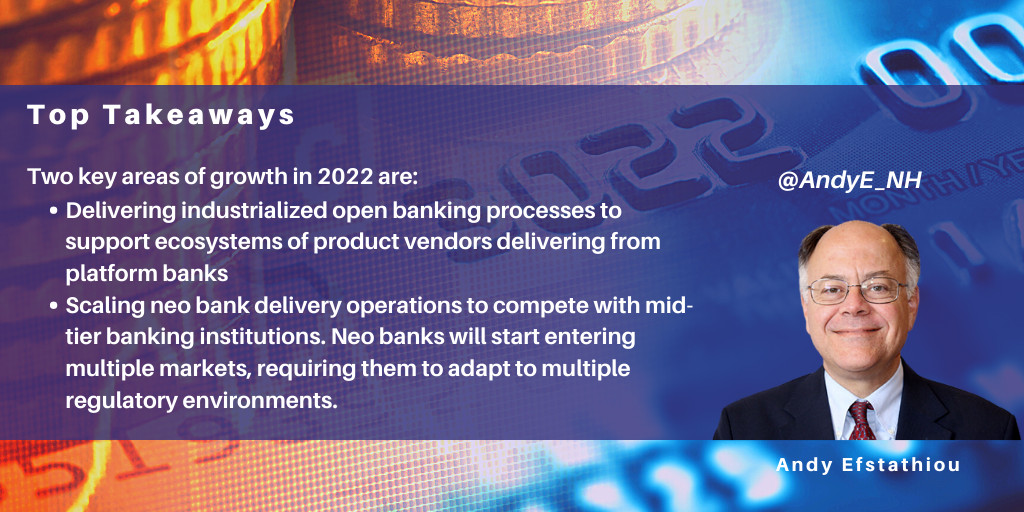
In 2022, the financial industry will continue to focus on building out its cloud and digital services infrastructure. This will be a deepening of capabilities for banks that have started their transformation, and the start of the journey for institutions that have not yet initiated their transformation. The growth rate of digital transformation is very high at ~20%.
Since most technology services vendors now derive 40% to 60% of their revenues from digital transformation services, this high growth rate will build on a large revenue base. However, there are two areas that have small revenues but much higher anticipated growth rates. We predict that these areas will start to make an impact in 2022, and be the growth engine for IT services in the financial industry in three to five years. They are:
- Delivering open banking processes in an industrialized environment
- Scaling neo bank delivery.
Our discussions with bank executives indicate that these are high priorities, though they also highlight a lack of consensus, with a wide range of perceptions. However, it is clear that execution will need third-party vendors to support and provide rapid, effective, and scaled services.
Industrializing Open Banking Delivery
Open banking has been a regulatory initiative for five years, but is only now moving to the execution stage in a few markets. Advanced markets moving ahead today include the Nordics and Benelux. These smaller markets make experimentation more feasible for a bank to launch a full-scale open banking initiative, and it is also easier to reengineer operations on the fly based on customer feedback. And, in smaller markets, it is easier for the financial institution to design an offering for a new customer demographic and vet partners to deliver a quality customer experience.
Delivering successful customer experiences in the initial open banking initiatives will drive customer awareness and willingness to adopt new offerings. Currently some Nordic banks are pursuing initiatives (e.g. in small business markets) which, if successful, will enable them to capture very large market shares of new customer demographics. The key is these markets are all domestic. It is rare that a bank in a mature market can pursue a domestic market opportunity as large as its existing markets.
Scaling Neo Bank Operations
Startup digital banks (neo banks) focus on their business model and the design and creation of new banking products. Ongoing operational delivery is not considered to be a core competency. Neo banks have been around for five plus years, but many have failed and just a few, such as Marcus, have grown to considerable size. None to date have become a tier one bank or financial services provider. Each market has seen different types of startup financial institutions opened. In the U.S., payments vendors have predominated; in Europe, digital banks have been the predominant form of startup.
The financial institutions (i.e. banks, payments processors, lenders such as Marcus, Revolut, Stripe, or Square) that have grown since founding must now scale up operationally to drive home their digital advantage before competitors match their digital value proposition. Scaling their business does not just mean scaling transaction processing, it requires scaling control, compliance, and security. Third-party BPS vendors are required to support this transition to large-scale, multi-product, multi-market operational delivery. Vendors that can provide combined domain-specific ITS and BPS services are rare. In 2021, BPS services grew slowly as clients focused on ITS for digital transformation. In 2022, BPS services focused on supporting neo bank growth will provide most of the growth in banking BPS revenues.
Summary
Financial institutions have been experimenting with new business models and customer methods. In 2022, these initiatives will need to scale the business, not just the transactions (which hyperscalers have been doing). Delivering domain-relevant operations at high scale will become an emerging focus of the digital financial industry for the next five years and drive large revenues for vendors who can deliver these comprehensive services.
]]>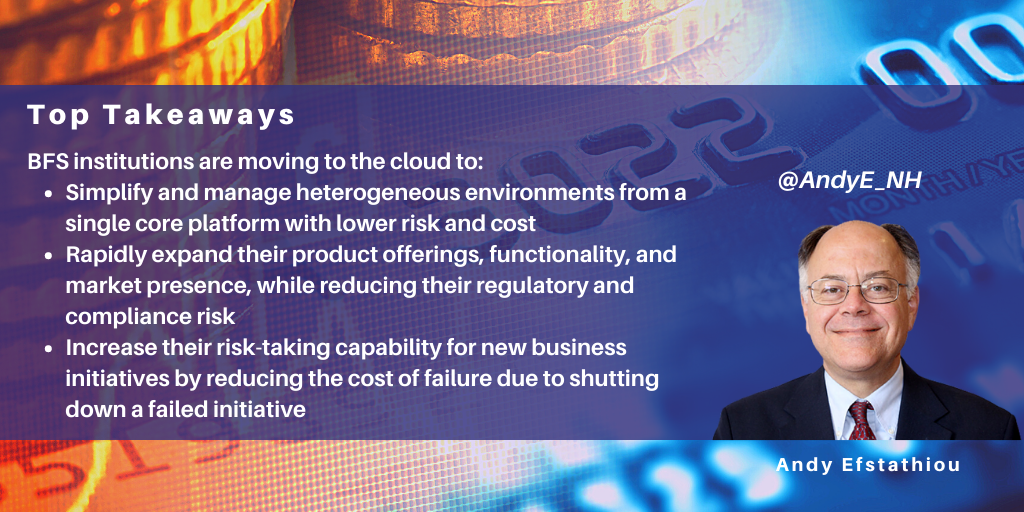
On December 15, 2021, Kyndryl and Viewpointe announced a cloud migration, modernization and management contract. The engagement provides insight for BFS executives into how banking services operations vendors are moving to the cloud to simplify operational delivery and enable business model change to expand and improve their business.
Current state
Viewpointe provides content management services for its owners, leading U.S. banks that include Bank of America, Truist, U.S. Bank, and Wells Fargo.
Viewpointe also delivers services for banks that are not part of its ownership structure. It delivers its services from two data centers (operating as primary and backup) in the U.S. It employs a proprietary platform to deliver services, which are heavily customized for each client. The primary content stored and managed by Viewpointe is mortgage/loan and checks/payment documents. Banks and their customers can search, access, and exchange content. Viewpointe develops and maintains the software platform. Kyndryl has been providing infrastructure orchestration and management services to Viewpointe since its inception in 2000.
Each client requires customization of the content management software to deliver a differentiated customer experience for each bank client. This has meant that each solution instance and sub-environment is unique and monolithic, on top of fixed infrastructure.
The engagement
Viewpointe wants to transform its application portfolio into a microservices delivered platform where:
- Clients can customize their platform, but platform management can be applied in a standardized fashion (e.g., patches, updates, management, and security will be rolled out rapidly with standardized solutions)
- Environment management will be handled by third parties (i.e., cloud delivery and environment orchestration)
- Viewpointe can develop new functionality and easily roll it out across heterogeneous client instances
- The entire environment can scale rapidly for new clients, markets, and product lines.
To achieve these goals, Viewpointe and Kyndryl have agreed to an engagement with steps including:
- Lift and shift to Azure cloud:
- Kyndryl and Azure design a landing zone to take the Viewpointe platform from its on-premise centers to the Azure cloud
- Kyndryl moves the platform to the Azure cloud, setting up orchestration and management services to manage the infrastructure environment
- Kyndryl and Azure partner to adapt to the changing cloud environment daily using best practices
- Transform the platform: Viewpointe implements solution changes to introduce new product lines and/or client feature customizations
- Scale the engagement: currently, client operations supported are all based in the U.S. In the future, Viewpointe expects to adapt its platform and delivery to support clients in additional markets with additional product lines and functionalities.
The journey will take three years, including:
- Year 1: migration to Azure cloud with new cloud-based orchestration and management capabilities implemented by Kyndryl
- Years 2-3: Viewpointe rebuilds the content management platform to fully adopt a microservices approach.
The engagement is expected to result in cost savings of 20% to 30%.
Conclusions and benefits
Cloud migration has been effective for highly seasonal or cyclical businesses, where volumes spike and the client only pays for capacity as it is used. Static workloads typically cost more in a cloud environment. This engagement highlights a use case where cloud delivery is more cost-effective than internal delivery. Features that must be present to make the case for cloud include:
- Heterogeneous environment by client: each member of the client base has high levels of platform customization resulting in each instance being materially different from all other instances
- Expanding the set of product offerings: rapidly expanding product offerings requires the client to deploy new solutions into the environment frequently. These solutions must rely on core functionality in the existing platform to deliver service
- Expanding markets: rolling out support for clients in additional markets that can be more easily supported from a Hyperscaler’s data center network
- Highly regulated industry: security and compliance requirements in highly regulated industries are frequently updated. A standardized microservices environment allows clients to rollout standardized updates across the entire environment faster, with greater accuracy.
Ultimately, the case for the cloud is that it allows Viewpointe to accelerate new product launches and standardize its operational delivery, while still enabling its customers to customize their platform instance.
]]>
Wipro acquired Capco six months ago, and is Wipro’s largest ever acquisition which, if successful, should enable it to compete with tier-one technology and management consulting firms in large-scale, domain critical, transformation projects with financial institutions.
However, successful unions are not created at the strategic level, but with disciplined execution that drives client and employee retention and growth. This blog examines early activities and results from this union.
Background
In Q1 2021, Wipro acquired Capco for $1.45 Bn to extend its capabilities in technology and management consulting for the banking and financial services industry. Wipro already had a large presence in BFSI, which currently represents 36% of its revenues, with offerings centered on designing, building, integrating, implementing, and supporting services. Capco’s services are centered on business and technology consulting and digital transformation services customized for the financial services industry.
Capco’s geographic footprint differs from Wipro’s, with key accounts in Europe and North America. In addition, Capco has a network of onshore and nearshore shared consulting capability centers in Europe and North America which support Wipro moving closer to the client.
Complementary business models
The partners have complementary business models. Capco is a global consultancy focused on financial services, with 96% of its revenues from Europe and North America and a smaller presence in APAC. When comparing Capco’s top 30 strategic accounts with Wipro’s Top 45 strategic accounts, only five of the accounts overlap. One year before this union, Capco formally launched its insurance practice, which today is accelerating its growth based on its frameworks and accelerators and the ability to bring Wipro resources to bear.
Wipro has a broader geographic presence (including a strong presence in APAC, LATAM, and the Middle East), greater scale, and unique domain offerings (U.S.-based mortgage lending IP and delivery, and Canadian custody services). Together the two firms bring an end-to-end set of services offerings to the market, comparable in scope to the largest IT and consulting services vendors.
The combined Wipro/Capco consultancy is bringing five digital service propositions to market focused on:
- Data
- Cybersecurity
- Customer experience transformation
- Cloud transformation
- Digitization.
The go-to-market strategy is for Wipro and Capco to maintain and manage their individual client relationships and collaborate to identify specific opportunities, through joint planning, to cross-sell services.
During the past six months, the combined entity has booked 20 new joint deals as a result of their new GTM strategy and there are currently more than 65 deals in their joint pipeline. The combined firm is looking for, and so far winning, larger, more comprehensive deals than either had before this union. Key examples of new deals won include:
- Setting up a new digital-only bank: two deals, one in North America and one in Europe
- Customer onboarding application rationalization for a provider of financial products to banks
- Migrating a treasury product application suite to the cloud
- Custody engagements in Canada: multiple deal wins engaging both Wipro and Capco offerings.
To power the new strategy, Capco needs to retain its staff and Wipro needs to grow its delivery capabilities in relevant technology areas. Key activities to date include:
- Capco has always attracted staff through a strong employee value proposition, supported by a differentiating culture and by offering highly competitive compensation coupled with strict non-competes. These contracts have built a stable, growing workforce
- Capco has added >1k employees to its existing 5k employee base over the last six months
- Wipro has integrated project delivery into its existing global delivery network.
Go-to-market plans for next 12 months
Over the next twelve months, Wipro and Capco will develop joint account plans for their joint strategic accounts. The primary focus will be on deepening strategic account engagements, with a secondary focus on winning new account logos with engagements that draw on the combined offerings of both Capco and Wipro. Wipro’s strategy has been to focus on strong growth from strategic accounts paired with a healthy addition of new clients each year.
Capco has hired four senior leaders to help drive an expansion of its offerings into the APAC marketplace, which will leverage Wipro’s existing infrastructure and account relationships.
Conclusions
The partners’ highly complementary offerings are being synthesized into five digital service propositions for the marketplace. Rigorous account management with clearly defined roles is driving larger, more comprehensive engagements with existing and new clients. Wipro will be able to enhance engagements with existing clients. It is now beginning to compete with vendors on projects requiring end-to-end services. Success over the long term will require continued operational discipline, evolving offerings to include a greater custom domain component, and retention of key skillsets. The union is off to a good start.
]]>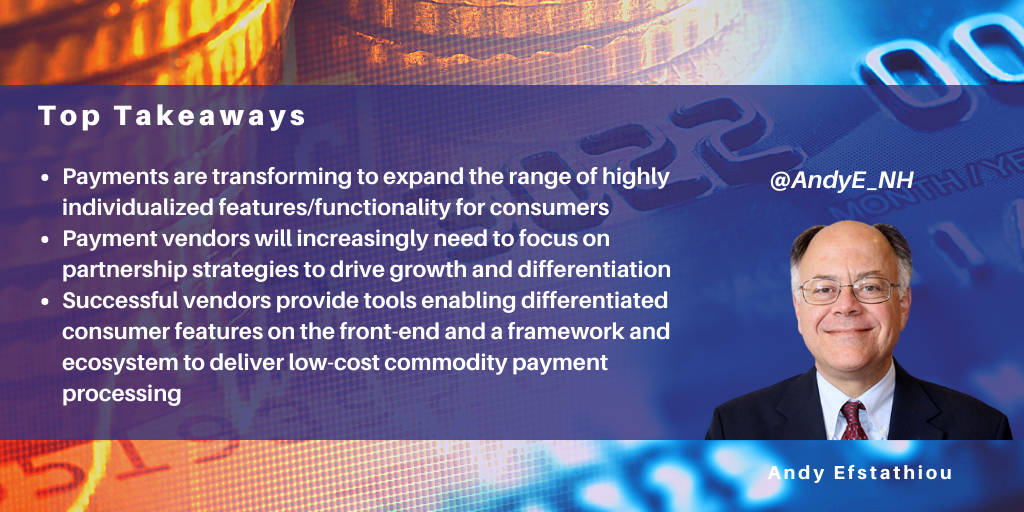
The payments industry has been transforming away from physical payments and electronic closed networks into an open network, all-digital payment ecosystem, and the pandemic has accelerated this shift. From the consumer’s perspective, this has been characterized by:
- A move to e-commerce and m-commerce, away from brick-and-mortar commerce
- Aggressively reduced use of traditional payment types (e.g., cash and checks) and increased use of digital payments (e.g., digital wallets, phone payments)
- Hyper-personalized payment experiences (e.g., enabled by multiple channel access and AI).
In this environment, payments vendors are expanding their:
- Customer bases to cover all consumer demographics
- Modes of payment, providing access from one interface
- Use of AI and biometrics
- Payment functionality to include real-time, cloud delivery, APIs, and platform-based solutions.
The payments industry is adopting key emerging functionality including:
- Buy now, pay later (BNPL) which combines credit and payment functions into one financial product
- Biometric payments, increasing security effectiveness and reducing friction from password usage
- Cryptocurrency payment options which expand the range of currency options
- Invisible payments: payments via a virtual wallet, increasing the ease and security of payments.
The Challenge
New competitors and new functionality are disrupting the traditional payments business, driving down margins. A recent Capgemini survey found that 70% of bank executives stated their payments business was either unprofitable or at break-even. Banks need to adapt their payments business to compete with emerging payments vendors.
Banks have three levers available to them to improve payment profitability:
- Change their business model, where there are two options available:
- Exit unprofitable offerings, reducing the overall offering set
- Partner with third parties to expand the offering set by geography and functionality
- Change their operating model, with two models available:
- Creating partnerships to invest in creating new offerings for the market
- Building ecosystems and API sets to let customers select new offerings from the bank’s platform
- Change their technology used in operations delivery, where the three models available are:
- Invest in cost-reducing technology: used by global tier one banks to create differentiation and reduce cost
- Buy operations delivery on an as-a-service basis: used by banks to support short-cycle products, seasonal/cyclical products, and untested products
- Collaborate with technology product vendors to build offerings and improve the distribution of the products with joint customer propositions.
The focus of these initiatives is reduced cost of delivery, but customers do not buy payments to improve banking profitability. They buy to improve their own experience. The key parts of the payments value chain delivering differentiation are the front end (i.e., signup, underwriting, acceptance, ease of use, speed of execution, and customization) and reporting (i.e., receipts, integration to tax reporting, analytics, budgeting, and customization).
Capgemini’s Approach
Delivering this level of change, while standardizing operations to control and reduce cost requires a move to standardized core platforms with a high degree of configurability to adapt to specific markets, customers, and a constantly changing environment. Capgemini’s approach demonstrates how this strategy can be implemented. Key components of its payments offerings include:
- Clearing Connect: a consolidated payment hub solution that can be customized for each clearing house the bank operates in. The payment hub allows centralized processing of payments but enables rapid customization and enablement of additional clearing houses as the client requires
- Payments Realization COE Hub: a COE that supports banks' modernization of their payments infrastructure and operations. There are three key offerings:
- Focused engines as payment hubs: Capgemini partners with solution vendors to provide products and services to modernize the operation of a payment. This represents 55% of client demand
- Frameworks: provides insights and a structured approach to payment transformation (35% of client demand)
- As-a-service: provides an emerging payments wallet in Europe, in partnership with AWS (10% of client demand).
These offerings enable banks to build a core payments platform that can be rapidly adapted to changing markets, technologies, and regulations.
Conclusions
The payments market is facing compressing margins and expanding functionality. Payment providers need to be able to expand their differentiated services with highly individualized features/functionality for consumers. At the same time, undifferentiated processing services must reduce costs to remain viable. The solution is for payments vendors to build standardized core payment hubs which can rapidly be adapted to new clearing houses and financial product introductions.
Capgemini has built services that provide a framework and ecosystem for transformation and a core processing hub that can deliver low-cost commodity payment processing. As the market evolves, payment vendors will increasingly need to focus on partnership strategies to drive growth and differentiation.
]]>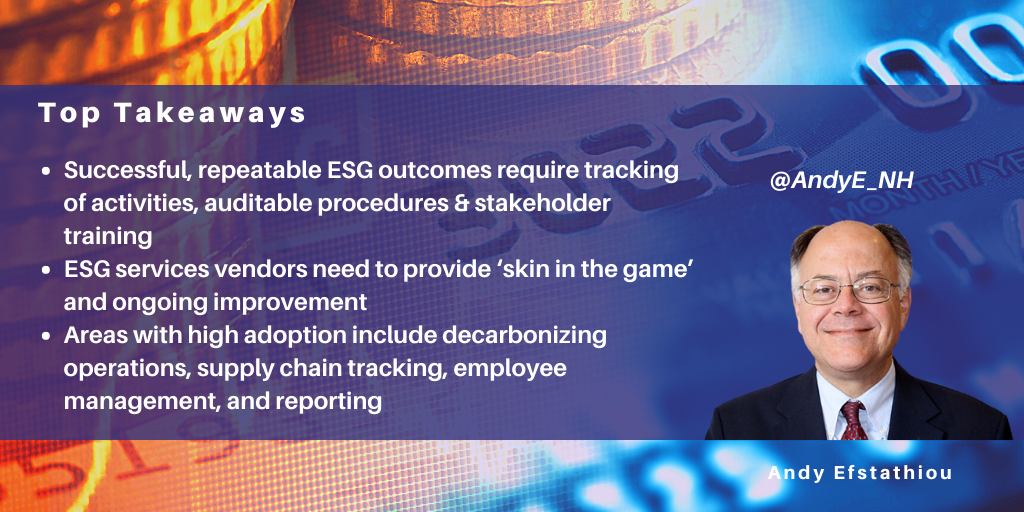
Environmental, Social, and Corporate Governance (ESG) is a popular topic of conversation and one that most corporations claim to be actively pursuing. The financial industry is particularly active in ESG, and here I look briefly at what is being done to support ESG initiatives by IT services and BPS vendors who support financial institutions’ operations.
How vendors help banks set up & run ESG activities
Vendors are supporting banks with services including:
- Advisory: engagements to develop a strategy, roadmap, and framework for implementing effective ESG programs
- Solutions: implementing tools, software, and ecosystems to achieve goals
- Integration of ESG/business activities: coordinating and embedding ESG programs into ongoing business activities.
These services are applied to:
- Data: managing, analyzing, and reporting current state and the impacts programs have made
- Technology: identifying and implementing technology to achieve ESG goals (e.g., technology to reduce energy consumption)
- Culture: working with stakeholders to educate and impact behaviors
- Portfolio management: orchestrating and managing ESG programs and assets across the enterprise to reuse and pursue improved outcomes.
Key activities covered include:
- Literature review and best practices
- Analysis: analysis of activities to prioritize for change, plus analysis of outcomes achieved
- Reporting to stakeholders, including employees, customers, management, and regulators
- Tracking the chain of custody and activities for assets and processes to confirm that actual behaviors are as reported
- Employee training: educating employees about strategies, value, and methodologies of ESG activities.
Most vendors offer a wide range of services, but specialize in implementing a few processes (e.g., decarbonization or HR). Activities with a high level of adoption include:
- Decarbonizing operations
- Supply chain tracking for carbon and ethicality
- Reporting (especially for regulations)
- Employee management, ethicality, and diversity.
In terms of challenges, ESG programs have faced pushback for ‘greenwashing’ activities where analysis of achievements has indicated actual outcomes have been much lower than reported, or non-existent. The key to achieving successful, repeatable outcomes is rigorous:
- Tracking of activities and assets with robust chain-of-custody controls
- Compliance with auditable procedures to ensure activities are as reported
- Stakeholder training with buy-in from trainees (achieving cooperation).
Example vendor frameworks & solutions for ESG
Decarbonization: Atos
Atos delivers services to help clients decarbonize their operations. Their offering helps clients to identify their current digital emissions status, build a roadmap to reduce the carbon footprint, and engage employees to support these changes. Key components of the offering include:
- One-day ‘hackathon’ to identify issues and build consensus
- Assessment: identify the current state and build a roadmap to a desired future state
- Dashboard: displays information on the current status and supports setting goals and decision making
- SLAs: Atos contractually commits to carbon reduction targets with a roadmap for how those targets will be met
- Green App: a gamified ecosystem to help employees understand key issues and support developing ideas to solve problems.
Employee & stakeholder training: Infosys
Infosys delivers training services to educate employees in adopting ESG practices across the enterprise. The key to enhancing the training programs that the vendor delivers to clients is the use of existing CX platforms to enhance training effectiveness using tools such as design thinking, knowledge management, and digitally delivered learning offerings. Key to success is special-purpose platforms that respond to environmental change and support change in the enterprise, including:
- Wingspan platform: knowledge and change management
- Meridian platform: sustainability events and community.
Responsible supply chain: WNS
WNS supports clients looking to secure and improve the ESG and operational characteristics of their supply chain with a set of agreements, contracts, practices, and due diligence. Key components of its responsible sourcing offering include supplier:
- Code of conduct: mandatory standards for all participants
- Portal: supplier data repository
- Due diligence
- Contracts: standardization of party obligations, including to ESG
- Evaluation: a periodic review of competency and compliance
- Assurance: supplier self-evaluation
- Awareness: mandatory anti-bribery training
- Diversity: profiling of suppliers
- Governance: audit and management reporting
- Ongoing improvement: benchmarking and ongoing enhancements.
In summary
Vendors are launching tools and offerings to address ESG challenges rigorously for banking clients and others. The programs are effective where there is accountability, consensus, ongoing improvement, and vendor skin in the game. Effective ESG programs will become increasingly important to the heavily regulated banking industry over time.
In my next blog I will look at how the market for these services, including client demand, is evolving.
]]>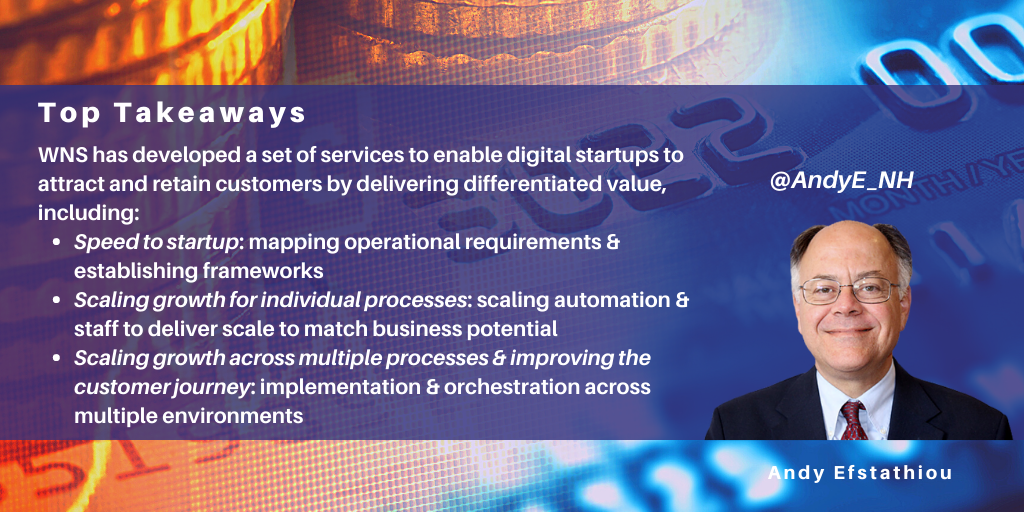
Digital startup banks are built on FinTech functionality to deliver financial services in an omnichannel environment. There are two types of FinTechs: B2B businesses that have a proprietary platform to deliver service to clients, and B2C businesses that provide clients with an all-digital banking experience.
WNS: expanded focus on B2C FinTechs
While WNS supports B2B and B2C, it has seen more traction in the latter, and has expanded its services to support the B2C FinTechs. The key market segments include:
- Digital banks
- Personal finance
- Wealth managers
- Business finance (small businesses)
- Payment providers/digital wallets/crypto firms.
Because the B2C FinTechs work with consumers, they require support for compliance and customer support, and these processes require human interaction to succeed and grow. Only 10% of FinTechs survive, but successful firms require massive scaling to meet customer service requirements. The good news is digital banks have lower exception rates (typically a 3% exception rate, versus 10% from a typical tier one bank) because their core processes are all digital.
However, many of these startup digital banks have faced operational challenges. Traditional banks are retaining customers because they offer the entire range of banking services, at scale, which encourages customers to maintain their business with them. FinTech banks that have faced challenges include Tesco Bank which has sold off its mortgage business and is closing its clients' demand-deposit accounts. Similarly, M&S Bank, a JV of M&S Stores and HSBC, has closed its in-store branches and is also closing its customers’ demand-deposit accounts. The lesson is that full product-line operational delivery at scale economics is critical to success.
WNS services for startup FinTechs
WNS has pursued the startup B2C FinTech market with a three-pronged set of services:
- Speed to startup:
- Map regulatory requirements
- Identify volume and staffing requirements
- Establish controls and SOPs
- Establish risk management, compliance, and control frameworks
- Scaling growth for individual processes:
- Institutionalize best practices
- Scale staffing to match business potential
- Performance management
- Automate repetitive manual processes (e.g., exception management)
- Scaling growth across multiple processes and improving the customer journey:
- Scale multi-geography operations
- Incorporate new regulatory and process requirements into frameworks
- Implement IA, AI, and omnichannel CX.
WNS engagements with FinTechs add processes over time, and the typical progression of services includes:
- KYC/AML/Fraud and compliance: most engagements start with this set of processes
- CX and onboarding: engagements next add in compliant onboarding services to achieve higher conversion rates, faster overall growth rates, and improved CSAT
- Back office services: reporting, accounting, fulfillment.
WNS can enhance its clients’ capabilities with functionality from its own set of tools or its ecosystem of FinTech solution providers which delivers emerging functionality in four key areas:
- Customer service
- Origination and servicing
- Analytics
- Compliance.
By using this rollout strategy and set of offerings, WNS has been able to scale individual engagements by 2X to 10X in one year. Overall, WNS has been able to grow its digital startup bank business this past twelve months by 40% y/y. Clients using these services have experienced a 30% reduction in TAT, 95% improvement in CX, and 30% reduction in application processing times.
Conclusions
Digital startup financial institutions are looking to bring new business models to market quickly. Third-party services vendors need to provide STP and a comprehensive set of services to support these emerging BFS services providers. WNS has built a set of operational services which enable startup banks to scale fast and continuously deliver new functionality to customers. This enables digital startups to attract and retain customers by delivering differentiated value. In contrast, tier one banks look for vendors to deliver siloed functionality.
Startup banks need a vendor that can deliver broad operational support. Sourcing, organizing, and managing resources is a complex challenge for a bank. WNS has pulled together the relevant components and frameworks necessary to deliver a full-service operations environment. As startup banks and local banks look to grow their businesses, they will increasingly rely on third-party vendors for this type of support.
]]>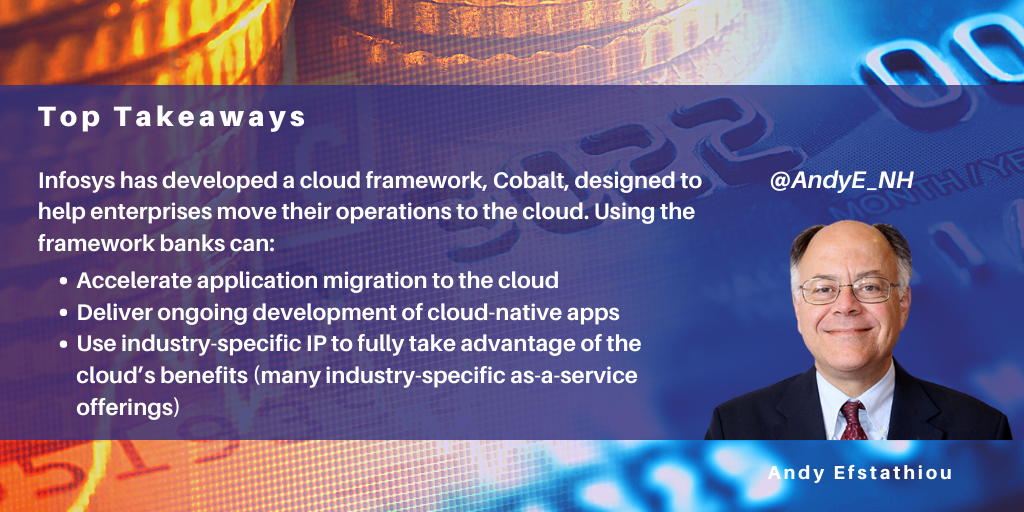
Banks are accelerating their move to the cloud to respond to the pandemic, enable greater operational agility to reduce time to market, and develop open banking capabilities. At the same time, performance dispersion (the operational variance across institutions within the industry) has increased significantly.
Cloud delivery can change operational performance and hyperscale businesses. So, how can banks move their operations to the cloud most effectively, and what tools and frameworks are needed to best adapt cloud operations over time? Infosys has developed a set of tools and frameworks, Cobalt, to address these challenges.
Infosys’ Cobalt Offering
Cobalt, Infosys’ cloud framework offering, is designed to address the key challenges enterprises face when trying to move their operations to the cloud. These challenges include:
- Security: the ubiquitous challenge of the cloud is providing satisfactory cybersecurity
- Modernizing and innovating their platforms: enterprises are moving to the cloud to modernize their platforms, but access to a broad range of tools and applications in this rapidly emerging market remains a challenge. Maintaining flexibility requires enterprises to avoid vendor lock-in
- Improving speed to market: implementing new solutions quickly and effectively in a multi-cloud environment is subject to wide variation across domains and companies. Access to talent continues to be a gating factor.
The Cobalt offering provides a solution across these five key areas of accelerated cloud adoption by any enterprise:
- Mainframe modernization: tools for assessment, rules extraction, and component migration
- Cloud-native development: tools for the development of cloud-native apps
- Database migration: database migration frameworks and tools
- Migration: frameworks and tools for migrating apps to the cloud
- DevOps: tools and frameworks to accelerate the adoption of DevOps across the bank.
Infosys believes cloud migration requires industry-specific IP to fully take advantage of the cloud’s benefits. Infosys has created a financial services-specific Cobalt offering, FS.Live.Cloud, that includes, but is not limited to:
- Open Banking solution: an open banking API platform
- Recon-in-a-box: recon platform to manage operational risk and provide controls
- Mortgage-as-a-service
- Business banking: Virtual CFO
- AML/KYC
- Media platform: digital asset and content management
- Voice-based solution: voice-based solutions integrated into Alexa
- Location-based solution: enhanced CX with value-added services based on location.
This packaged version of FS.Cloud.Live helps mid-size financial institutions with a cloud solution at an overall cost of 15% to 18% lower than buying public cloud services direct. In addition to the services described above, this offering will:
- Host applications from Infosys and third parties (e.g., Actimize, Calypso, Avaloq, and Fiserv)
- Provide clients with the ability to build new cloud-native platforms using accelerators for cloud-native development.
Large financial institutions in most cases have either developed or are developing a comprehensive cloud strategy and they can benefit from leveraging components of FS.Cloud.Live to optimize migration times by 30-40% and deliver a much lower overall TCO.
Conclusions
Financial institutions of all types are looking to migrate to the cloud with the help of third-party services and technology vendors. Sourcing, organizing, and managing resources is a complex challenge for any financial institution. Infosys has pulled together the relevant components and frameworks necessary to deliver a cloud migration project, with ongoing environment management updates, to enable regional and local banks to capitalize on the cloud opportunity. These services are useable by line-of-business executives, not just technologists, which allows the LOB to directly adapt the capabilities to align with their business objectives.
As banks migrate more of their operational footprint to a multi-cloud environment, the technology will become more robust. However, the business advantage comes from being an early mover. All financial institutions are looking for the broadest, most robust set of tools, technological and human, to enable them to transform their business models for a more agile, open banking industry. The FS.Cloud.Live platform is a good example of the type of tools banks need to start their cloud journey.
]]>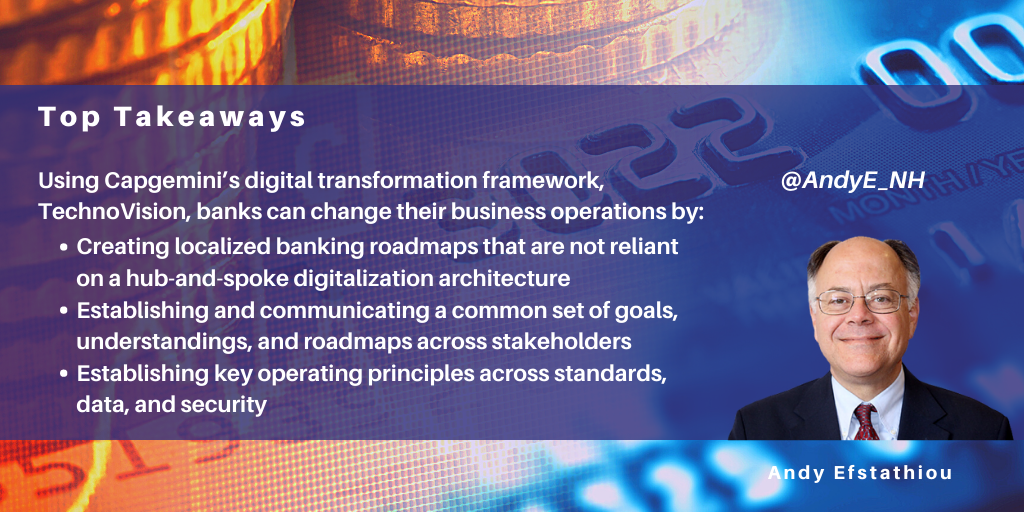
The pandemic has accelerated the adoption of digital transformation across all industries, and in the financial sector, operational transformation has grabbed the top spot in the priority list for investment and spending. At the same time, performance dispersion (the variance across institutions within the industry) has significantly increased.
So, how can banks make their transformation initiatives effective, and what drives performance? Multiple firms, banks, and IT/operations services vendors, are now creating digital transformation frameworks to help improve the effectiveness of these efforts.
Capgemini’s TechnoVision framework
Capgemini has created its own transformation framework, TechnoVision, which identifies key business/technology levers, evaluates technologies, enables initiative prioritization, and supports disciplined creation and execution of a transformation strategy.
Strategic considerations are based on three core principles, backed by technology domains, which are:
- Standards: each technology, and the domain it is applied in, requires customized standards which are set by the ecosystem it operates in
- Data: sourcing, scrubbing, analyzing, and using data in businesses
- Security: security practices relevant to the specific operational environment.
Technology domains under consideration are Cloud, AI, Immersive, Connected, High Performance & Decentralized Technologies. The operational framework is adapted to each industry where it is employed. TechnoVision has the following key components:
- Infrastructure areas for transformation:
- Invisible infostructure: coordination of the technology infrastructure
- Applications unleashed: the application and API domain
- Thriving on data: the data and AI domain
- Process on the fly: the process automation domain
- People-focused areas:
- You experience: stakeholder experience domain
- We collaborate: workforce and partner coordination
- The design principles for transforming delivery technology. Here, the principle of balance by design aims to balance and coordinate people and systems to create sustainable delivery.
The framework allows banks to move from a centrally controlled organization (hub and spoke model) to a decentralized model, coordinated by a set of operational/business standards and a single golden-source set of data. The value of the framework is that it can deliver:
- Growth: driven by hyper scaling in two directions: matching costs/revenues, and the ability to harvest smaller economic opportunities more efficiently
- Efficiency: driven by lower error rates, reduced reconciliation/fixes, improved STP/fulfillment, and lower cost
- Stakeholder engagement: driven by higher CSAT, improved CX, higher up/cross-sell
- Resiliency (losses previously to generational change, silos, and latency responses to societal changes)
Conclusions
Financial institutions of a wide variety of backgrounds and characteristics are looking to undertake digital transformation with third-party services and technology vendors. There needs to be a meeting of the minds among all stakeholders to ensure the transformation process is effective. A transformation framework helps to establish and communicate a common set of goals, understandings, and roadmaps across stakeholders.
Capgemini’s TechnoVision framework for financial services helps banks address transformation issues across the enterprise, including standards, data, and security. The framework has been used in many global and regional banks to define and accelerate the transformation journey. Other services vendors have similar frameworks, though TechnoVision is distinctive in its use of sessions with local banking executives to create localized banking roadmaps which are not reliant on a hub and spoke digitalization architecture. We expect to see Capgemini build more real-time transaction capabilities with its clients to address banking’s move away from wide settlement windows and batch processing.
]]>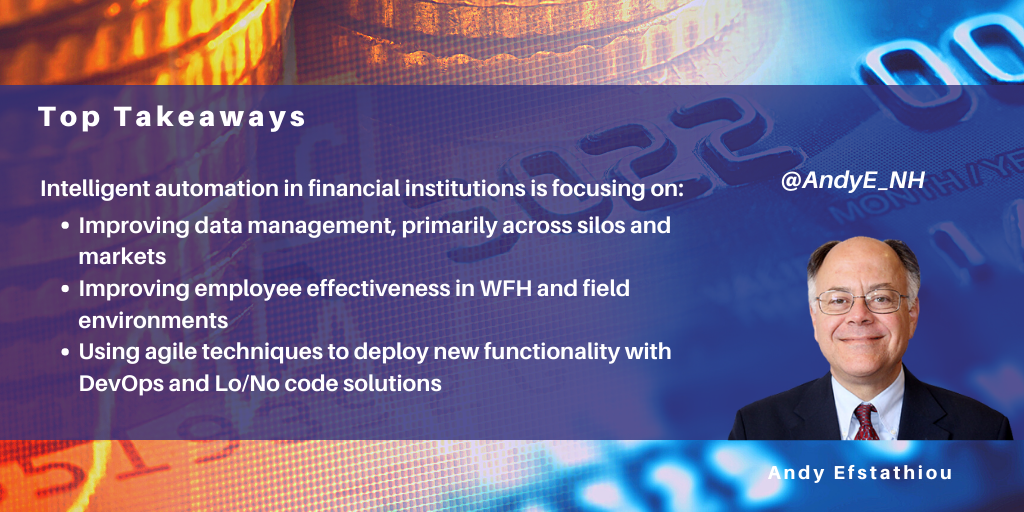
NelsonHall recently published a market assessment and forecast report on Intelligent Automation in Banking: Transforming Operations. We found that financial institutions must automate their operations if they are to compete successfully in a rapidly evolving marketplace. Currently, they operate with manual processes using a heterogeneous set of platforms, acquired over many years of M&A. However, the pace of industry change is increasing, while labor-based operations are slowing financial institutions’ abilities to respond. Cognitive, AI and RPA technologies are allowing these institutions to become more agile, cutting the cord from labor-based value-add, without having to do a rip-and-replace of their existing platforms.
The state of IA in financial services
For the past year, financial institutions have been:
- Expanding the use of process discovery to identify new targets
- Standardizing processes across silos
- Focusing on the use of IA for employees for WFH and fieldwork (especially in response to COVID-19)
- Accelerating their delivery from the cloud
- Adopting the use of hybrid AI/RPA to support agents and advisors.
Over the next year, financial institutions will focus on:
- Managing data across silos and markets
- Using agile techniques to deploy new functionality with DevOps and Lo/No code solutions
- Increasing their focus on human/bot teams and their effectiveness
- Applying IA to low-volume manual processes.
However, the external environment has put up barriers to transformation. The key barriers impeding the efforts of financial institutions include:
- Access to emerging technology: all IA services vendors are building ecosystems for emerging technologies and acquiring staff skilled in relevant technologies. Finding the best new technologies and embedding them in effective platforms remains difficult
- Access to qualified staff: changing technologies changes the required mix of staff skills, and emerging tech is driving a skills shortage. Currently, AI is the most constrained capability
- Changing regulations requiring resources to adapt to them
- The COVID-19 induced move to more distributed operations:
- The need to reduce supply chain risk by increasing the distribution of operations
- Increased use of joint human/bot work teams, and how to make them effective
- Shifting delivery to the omnichannel environment and rearchitecting processes
- Changing business models: the advent of digital banks (e.g., Marcus) and the need to create new competitive business models to address this challenge.
Rising to the challenge
To address these challenges successfully, financial institutions need to focus on two activities: vendor selection and execution.
Key factors in vendor selection include:
- Preferred product vendors should have the widest pool of IT services providers supporting them
- Focus on services vendors with skills in process discovery, breadth of solution partnerships, willingness to invest in operations, AI, domain knowledge, and data management capabilities
- Building an ecosystem of vendors with knowledge of client’s business issues; complementary skills to build and deliver IA services;, and the ability to work within client operational practices
- Changing the operational model: banks need to shift from operational leverage (scale economies) to leveraging flexibility (ability to cost-effectively switch out workloads).
Key factors in execution include:
- Preferred vendors should have the widest pool of solution providers supporting them
- Redefining what is delivered by third parties, internal, and cloud to maximize flexibility and speed new intelligence and automation
- Focusing on increasing the yield of use cases by focusing on KPIs for successful use cases
- Transforming application development to a DevOps model to speed the innovation cycle.
In summary, financial institutions are changing their goals in two important ways:
- From improving process efficiency to improving data management
- From improving cost efficiency for static businesses to agility for continuously changing businesses.
The operational changes being made will drive business model change. And these operational changes will drive accelerating change in banks’ product offerings, customer base, and market presence.
Find out more about NelsonHall’s Intelligent Automation in Banking: Transforming Operations market assessment and forecast report here or contact Guy Saunders.
]]>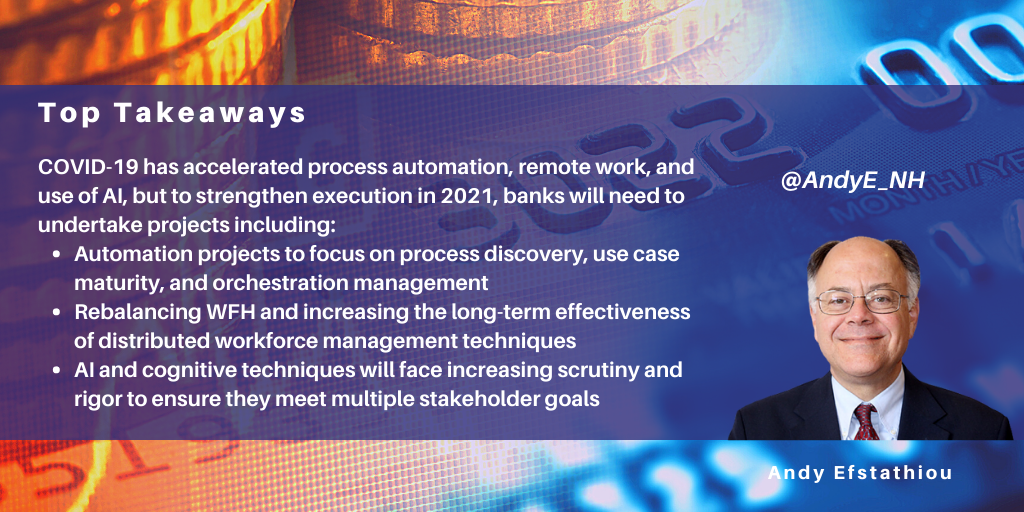
Banks will spend 2021 pursuing different aspects of three key initiatives that have become more important since the advent of COVID-19. The first is process automation, which has become more important but needs to increase its delivery effectiveness. The second, work-from-home (WFH) has also accelerated under COVID-19 but will need to change in 2021 to continue to be effective. The third is the application of cognitive to processing. Cognitive is an immature technology and has had teething pains with bias and ethics. Users of cognitive technologies will need to include controls to meet ethics requirements that society requires of its business community.
Process Automation
Process automation has been an accelerating trend for the past four years. Since COVID-19 struck earlier this year, the adoption rate of automation has pulled three years of anticipated adoption work into the second half of 2020. However, this acceleration has highlighted key challenges to effectiveness. They are:
- Process discovery: the acceleration in the pace of adoption has highlighted that banks do not fully understand the processes and process bottlenecks that need automation. Multiple vendors have been developing enhanced process discovery tools to increase the speed at which banks can identify processes
- Use case yield: most banks have been toying with many POCs to try to improve process effectiveness. However, the majority of cases (sometimes as high as 90%) fail to meet their required rate of return to justify their deployment. Third-party vendors are well-positioned to improve the yield on POCs due to their work with multiple clients in many industries. Increased rigor of use case development, based on experiences to date, will enable higher throughput from conception to operations
- Orchestration: once the bots are deployed, especially in a highly distributed environment such as cloud or multi-country, effectiveness declines rapidly. Orchestration tools are being built and improved to improve effectiveness.
These issues have become a priority for banks. Our conversations with bank executives indicate their highest priorities for RPA engagements are:
- Increasing the yield to operational deployment from POCs and use cases
- Maintaining the effectiveness of bot deployments while adapting the operational environment to changing business conditions.
In 2021, they will focus their automation initiatives on compliance (especially the conversion of loan contracts to a post-LIBOR world), customer service, improving agent effectiveness, and KYC/AML reviews.
Work from Home
The COVID-19 world has seen a mass migration to WFH. However, CEOs and other leaders are concerned about workforce morale and training issues over the long term. Bankers we have spoken to expect WFH will remain a larger part of the financial services environment, but much smaller than it is today. Specifically, interviews we have conducted indicate banks expect 70% of workers to move back to offices and ~30% to remain in a WFH environment. Over the next year, institutions will have to work out what the shape of the new workforce deployment will be. Key issues will include:
- Which workers will be on-premise and which in a WFH environment?
- What are the criteria for working in each environment?
- What are the conditions and frequency of being on-campus or off-campus?
- How will this impact the shape of teams?
- What automation and security will be required to support workers over the long term in this new environment?
Until the lockdowns end there will not be much movement on this issue. However, the second half of the year should see the economy open up and these issues will take center stage.
Cognitive Processing Support
Banks and technology vendors have been developing and trialing cognitive support tools for many years now. The aggressive move to digital channel environments caused by COVID-19 has both enabled the application of cognitive tools to business processes and necessitated the use of cognitive tools to deliver services. However, accelerated deployment of cognitive tools has highlighted challenges including:
- Bias: ML and AI tools are inherently backward-looking. Improving society or reducing inequities will not happen from a backward-looking analysis. The algorithms, use cases, and human oversight of these tools will be overhauled in the upcoming year
- Compliance: to date, the primary use of cognitive has been within an individual market and silo at a bank. Moving into 2021, banks are looking to deploy cognitive across silos and markets. Understanding data from across heterogeneous environments is a big challenge, but regulators are requiring banks to deliver on this.
The above growth areas of technology services for banks in 2021 are the result of 2020’s rapid deployment of immature technologies. Each of the three growth segments of services will, as usage matures, provide banks with increased agility to adapt to a rapidly changing business environment.
]]>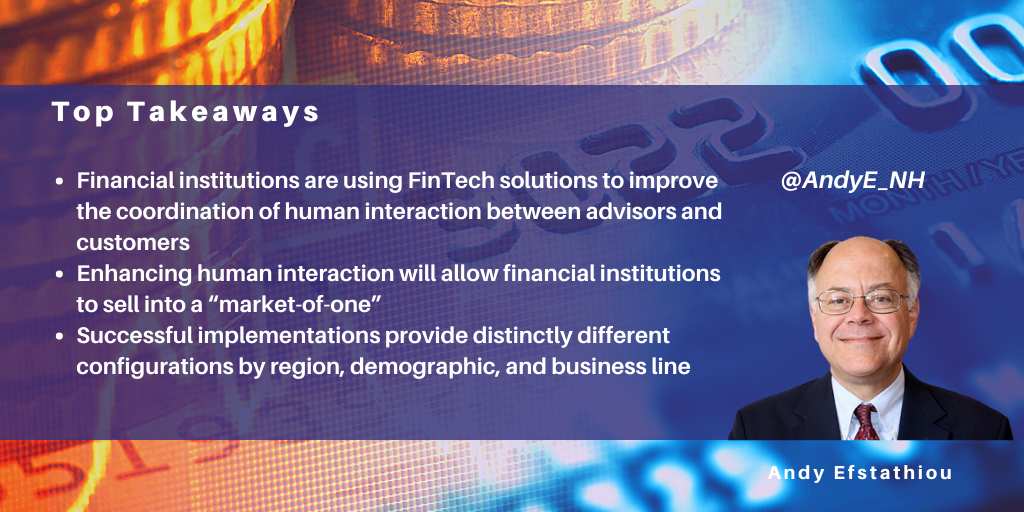
It has been extensively reported that industries requiring in-person interaction, such as travel and entertainment, have been adversely impacted by the COVID-19 pandemic. Less obvious has been the impact on industries that are often typified by remote delivery. For example, the wealth and asset management industry is primarily driven by the long-term buildup of wealth and involves infrequent face-to-face meetings.
During 2020, global stock markets have recovered from the March stock market decline (but maybe relapsing in late 2020) when COVID-19 became a household word and businesses were forced to respond. However, despite its advantages, the wealth management industry is still facing strong headwinds from COVID-19 impacts. Overall, industry Q3 results for wealth management businesses have shown strong revenue performance based on strong market appreciation, but not from new business. To maintain operational strength, wealth managers will need to attract new customers and assets to perform well when future market breaks occur.
Three emerging trends can help wealth managers to grow their revenues and control their costs. These trends include:
- An emerging younger customer demographic which prefers very different methods of interaction (primarily digital and mobile interactions)
- Open banking ecosystem of vendors providing products for improved CX and a broader product mix
- Mass affluent offerings of existing product types and, in the future, increased customization of offerings for each customer (hyper-personalization).
Many financial institutions and services vendors are grappling with ways to enhance the customer experience in partnership with human advisors. Improving the coordination of interaction between advisors and customers is a complex, highly human, challenge that firms are beginning to address. For example, Capgemini has developed its Augmented Advisor Intelligence solution to support matching the right investment advisors to individual customers by analyzing and then leverage the advisors’ traits including:
- Prospecting and compatibility scoring
- Propensity modeling
- Next-best action decisions
- Value-based segmentation
- Model financial advisor
- Best practice behavior.
By drawing on internal data (advisor past customer interactions and portfolio) and external data (customer demographics, sentiment, portfolio, and behaviors) the platform uses ML and AI to provide advisor matching recommendations, investment and portfolio recommendations, and best practice recommendations.
The benefits for the wealth management firm include:
- Ability to assign advisors to customers based on fact-based analysis of personality, behavior, and lifestyle matching
- Ability to track and monitor advisor performance, including prescriptive analysis of problems that may be developing
- Improved targeting of outreach and customized offerings to customers, which can increase marketing campaign ROI
- Improved ongoing advisor/customer interaction by use of sentiment analysis of digital communications and improved routing allocation and recommendation options.
The application of this platform across markets has resulted in distinctly different regional requirements, including:
- Mature markets: young people are the primary growing demographic. The focus is on developing omnichannel access to digital-based investment services for customers familiar with wealth management activities but dissatisfied with traditional delivery methods
- Emerging markets: small business owners, often middle-aged are the primary demographic. The focus is on supporting investment into growing their businesses
- Mature Asian markets: rising young professionals are the primary demographic. The focus is on developing a set of mass affluent products that can grow in value to service the lifetime financial needs of individuals with limited or no family experience with financial products.
In short, vendors are trying to move beyond tracking and analyzing customer traits and propensities, to analyzing and changing advisor/customer interactions to optimize CSAT and business effectiveness. Enhancing human interaction will allow financial institutions to sell into a “market-of-one” effectively. These tools will enable consistent success in matching advisors to customers and reduce the cost of delivery to enable greater adoption of mass affluent wealth management offerings in all marketplaces.
Capgemini’s approach to enhancing advisor/customer interactions and relationship management provides a comprehensive approach to this challenge. It identifies stakeholder attributes, predicts behaviors, manages ongoing interactions, and evaluates ongoing relationship health. Most intelligent solutions focus on improving transactions. This type of platform enhances customer lifecycle management performance by improving communication and understanding between human beings.
]]>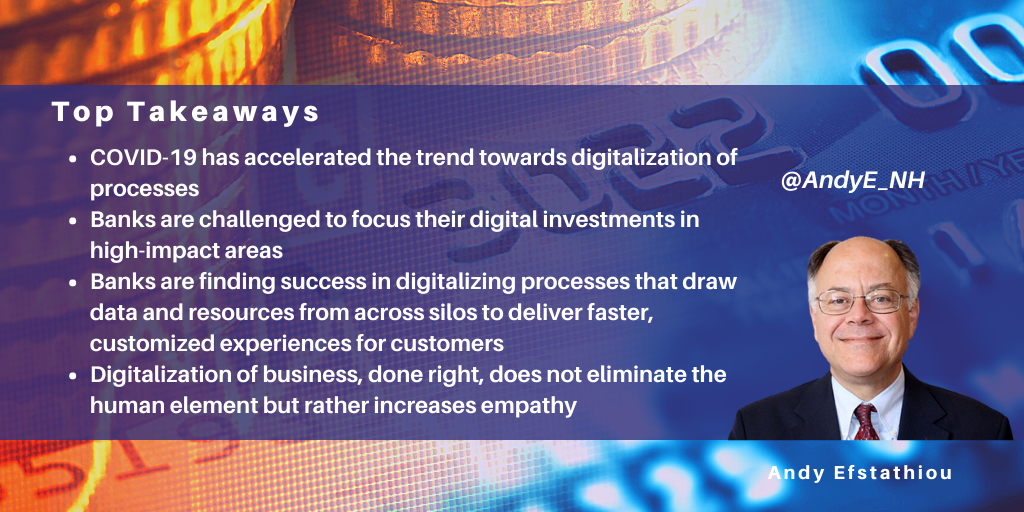
I recently participated in a webinar panel during the Consumer Banking Association conference with Genpact and TD Bank. The panel topic was Genpact: Turning Crisis into Opportunity for Consumer Banking, and it addressed three core topics:
- The global health and economic crises have reshaped consumer banking
- Banks are adjusting to serve customers digitally while trying to maintain empathy and human connection
- Banks can accelerate and prioritize their digital investments to drive real change.
The COVID-19 crisis has accelerated previous trends towards digital adoption, including:
- Cloud migration, as banks have moved from a single cloud strategy to a hybrid, multi-cloud strategy
- Omnichannel migration, as banks close branches and expand online alternatives
- Cybersecurity adoption, as banks seek to secure their data and operations in the cloud.
TD Bank has found that banks have moved at light speed to implement the PPP Act and financial relief offers for customers. TD Bank’s relief offer, TD Cares, was built with three concepts in mind:
- What benefits do stressed customers need?
- What products can best deliver these benefits?
- Outreach to customers the bank anticipated might need support. The guiding principle is meeting the customer where they are (online, in-person, etc.).
The delivery of these services was developed with a “digital-first” approach, followed immediately with human interaction to support robust interaction and CSAT.
Overall, banks are trying to prioritize where they will be spending their money. When a bank looks at digitizing a process, such as onboarding or payments, where in the value chain should it start and focus their investment dollars to make the largest operational impact? The key to succeeding in delivering value is to optimize the customer experience. To date, banks have looked at improving their processes. However, customers are comparing their online experiences against their experiences form other industries, such as the consumer products or entertainment industries.
COVID-19 has forced banks to rethink how and when they engage customers. Key examples of changes made include:
- Much faster decision-making process (e.g., for lending). Digitalizing applications and providing STP to decisioning algorithms has enabled closer to real-time approvals for standard borrowing requests
- Real-time digital channels: by deploying armies of chatbots, AI, and decision trees; banks have been enabling employees to engage across all channels with customers while knowing who the customer is in real-time.
The banks are not just trying to improve efficiency, they are trying to create empathetic, differentiated experiences in their customer interactions. Creating a value chain that delivers digital, empathetic, differentiated customer experiences will require a synthesis of bank operations, data management, and FinTech partner ecosystems. By integrating digital processing, bank/customer data, and new functionality from an ecosystem of vendors, banks should be able to know each customer and create a custom experience for that customer. The industry is in the early stages of creating such customized experiences, but the journey has begun. For example, a bank has been able to deliver empathetic, customized experiences by digitalizing customer contact apps across silos. This requires all stakeholders to participate to move a project ahead both thoughtfully and at speed.
Banks are not just building customer contact experiences with digital technologies. The panel identified payments as an area of rapid transformation, where customers experience the use of the product itself as a consumer experience. There are two areas within payments that are a focus for innovation today:
- Payment initiation: identifying the payor at the POS to provide a seamless, real-time payment experience
- Post-payment services: delivery of services such as credit extension and loyalty program assignment.
Again, modularizing the process with support from an ecosystem of specialized vendors is enabling payment companies to restructure the industry and improve customer experience.
The key takeaways from the webinar panel are that, because of COVID-19, banks are moving faster than ever to digitalize their businesses. The digitalization of business does not eliminate the human element but rather increases empathy and human engagement to drive a differentiated experience. Because the canvas is large, banks are challenged to focus their investments in high-impact areas. The areas where banks are finding success are in digitalizing processes that draw data and resources from across silos to deliver faster, customized experiences for customers.
]]>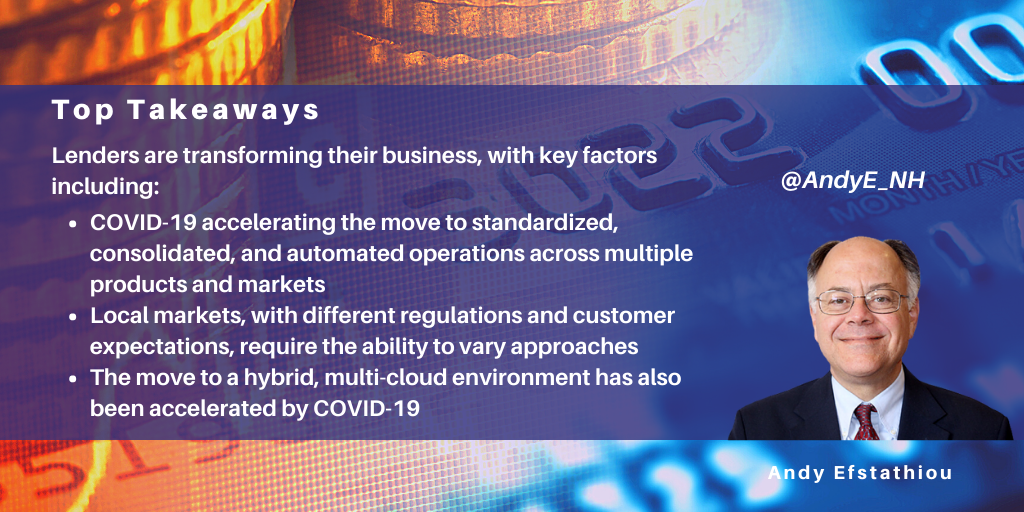
NelsonHall recently completed a market assessment and forecast report on Transforming Mortgage and Loan Services. We found that the lending industry is undergoing profound operational change as it adapts to slowing loan growth and emerging customer populations that are younger and more technology savvy. For the past two years, lenders have been:
- Variablizing and reducing the cost of operational delivery using automation, AI, and third-party operations delivery
- Moving to hybrid cloud delivery. This trend is still in the early stages and has been accelerating with the advent of the COVID-19 pandemic
- Standardizing, consolidating, and automating operations across multiple products and markets. Most lenders have been built via M&A and they have tried to differentiate themselves with new loan product features. Standardizing their heterogeneous platforms to reduce cost of delivery and unify customer experience is a high priority
- Focusing on cost reduction for high-cost processes. Origination, due to its high cost ($3k to $7k per closed retail mortgage in the U.S.) has been the highest priority target for cost reduction.
COVID-19 & other challenges
The COVID-19 pandemic has accelerated these trends and initiated an aggressive move to remote work. Remote work has increased the need for strong cybersecurity and for robust national infrastructure in some emerging markets to support remote delivery.
The external environment has put up barriers to transformation. The key barriers impeding their efforts include:
- COVID-19: lenders have been focusing on maintaining operations, while shifting to a work-from-home (WFH) environment. The impact has been to put transformational projects on hold for the short term
- Competitive landscape: the introduction of all-digital lenders, with unproven business models, has led many incumbent lenders to take a wait-and-see approach to business model change
- Changing technologies making long-term investments risky.
For lenders operating in multiple markets, local requirements make transformation difficult. Market-specific requirements that make a standard global delivery methodology impossible to achieve are:
- Local markets require different licenses and procedures, and feature different customer expectations and competitive landscapes
- Evolving loan product types are based on new data fields and product attributes, making existing taxonomies obsolete.
Lenders adapt transformation strategies
Transformation strategies have had to take these barriers into account. While they have postponed many initiatives, lenders have not abandoned those projects. Currently, lenders intend to restart projects when the impact of the pandemic is clearer, and prior to full resolution of the pandemic. At this point, it looks like these projects will restart by late 2020.
Digital transformation goals for lenders are changing from cost-focused to agility-focused goals. Key changes in goals for transformation projects include:
- Strategic goals are moving from reducing costs to changing business models:
- Moving from enable remote customers to enable remote employees (due to COVID-19)
- Transforming to an open banking environment with large ecosystems of partners
- Financial goals are moving from optimizing at fixed volumes to optimizing at constantly changing volumes:
- Increasing flexibility by reducing breakeven volumes and ability to react to change
- Improving STP by tying front-end to back-end for faster TAT
- Increasing sales by taking on new customer types facilitated by better analytics
- Engagement goals are moving from “same mess for less” to “transform”:
- Standardizing and consolidating platforms and methods across silos
- Automating to reduce the labor component and manual errors
- Changing DevOps to facilitate faster, modularized platform renewal
Summary
In summary, vendors are changing their goals from cost efficiency for fundamentally static businesses to agility for continuously changing businesses. The operational changes being made will enable and drive further change in the business. These operational changes will drive accelerating change in lenders’ product offerings, customer base, and market presence. The mortgage industry is at the start of a decade-long transformation of its business model.
Find out more about NelsonHall’s Transforming Mortgage and Loan Services market assessment and forecast report here.
]]>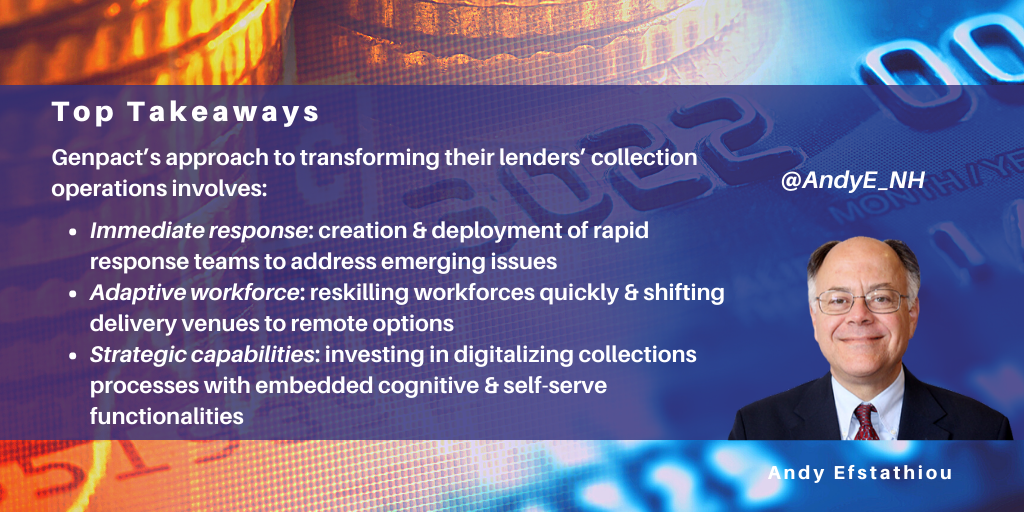
The past decade since the global financial crisis (GFC) has been good for the lending industry. Loan delinquencies in the U.S. reached their highest level after the GFC in the first quarter of 2010 at 7.4% of commercial bank loan portfolios. Since then, loan delinquencies have fallen to 1.44% of loan portfolios as of the fourth quarter of 2019. At the same time, loan portfolios have grown 26.8% larger than they were in the second quarter of 2013. During this period, banks and lenders have reduced collections staff as delinquencies have declined. Banks can support delinquency collections if portfolios maintain low default rates.
However, COVID-19 has had a major adverse impact on the economy. During this time unemployment rates have surged and GDP forecasts have plummeted.
This type of economic contraction will aggressively drive up collection activities at banks. But scaling collections activities will be challenging when all lenders will be trying to scale-up their activities at the same time, and as new regulations constraining collection methodologies are being issued.
The automation and operating framework will be critical to successfully navigating the collection environment. I recently participated in a Consumer Bankers Association hosted webinar with Genpact where they outlined their approach to improving collections services. Genpact has developed a three-part methodology for transforming their clients’ collection operations:
- Immediate response: creation and deployment of rapid response teams with simplified decision-making structures to address emerging issues and deteriorating portfolios
- Adaptive workforce: reskilling workforces quickly and shifting delivery venues to work-from-home (WFH) or other remote options
- Strategic capabilities: investing in digitalizing collections processes and embedding cognitive and self-serve functionalities
The challenge is large, so success requires a set of prioritized actions to make early gains possible. Examples from Genpact include:
- Immediate response measures taken to date include efforts to proactively identify and remediate high-risk customers before they hit delinquency. Clients can reduce exposure related to high-risk customers by leveraging machine learning to develop and deploy a combination of credit limit decrease and blocking, or proactively offering customers hardship plans. Using text-mining of agent notes from customer service interactions has allowed early identification and treatment of high-risk customers
- Adaptive workforce measures have had the highest activity to date, and include:
- Rapid, remotely delivered workforce training. For example, Genpact is helping a top 5 global bank is ramping up their operations from 600 to 1600 skilled collections resources
- Workforce multiplier support such as a group of rapid response teams (cross-functional teams that can address the rapidly evolving customer dynamics through agile pods). These teams deliver services such as surge-capacity hiring, training, and deployment all with WFH solutions
- New models of data usage, both new data forms, and alternative data streams. COVID-19 has changed customer behavior, and ML needs to be used to identify new customer segmentation patterns and the appropriate response. This is not a one-time activity; it requires weekly refreshes as the data/behavior changes
- Regulatory changes such as the Consumer Financial Protection Bureau’s recently published new contact policies. Straddling compliance and good practice is the need to define and test what empathetic response should be. There are no clear metrics, particularly when it comes to a customer situation where they may be impacted economically, socially, and health-wise
- Strategic measures taken to date include investments in:
- Channels of customer contact and payment beyond the voice channel, including chatbots and self-service
- Automation of manual back-office processes in collections using RPA or workflow solutions, so that agents can focus on customer management. This has been especially useful for implementing the CARES Act program
- Use of AI, ML to develop and offer unique hyper-personalized treatment strategies suited to specific situations and requirements of individual customers. These customized solutions can reduce customer hardship as it considers the individual realities to make the debt more manageable for customers
- Building empathy into conversational tools: for example, real-time speech analytics and conversational AI to prompt effective payment plan matching to customer needs using the appropriate verbiage usage based on customer talk
In short, scaling the same processes, under conditions of reduced resources, increased costs, and growing transaction numbers will not work. Already vendors are addressing these challenges by employing combinations of proactive outreach, workforce training, and technology. Lenders will then be able to increase their effectiveness and scale in collections to meet the rapidly increasing scale of operational delivery required.
To find out more on this topic, view the Consumer Bankers Association hosted webinar with Genpact and NelsonHall here.
]]>